Indazole sulfonamide derivatives as inverse agonists of retinoid-related orphan receptor gamma (ROR .gamma. (T))
Musicki , et al.
U.S. patent number 10,246,440 [Application Number 15/537,678] was granted by the patent office on 2019-04-02 for indazole sulfonamide derivatives as inverse agonists of retinoid-related orphan receptor gamma (ror .gamma. (t)). This patent grant is currently assigned to GALDERMA RESEARCH & DEVELOPMENT. The grantee listed for this patent is GALDERMA RESEARCH & DEVELOPMENT. Invention is credited to Claire Bouix-Peter, Branislav Musicki, Gilles Ouvry, Etienne Thoreau.







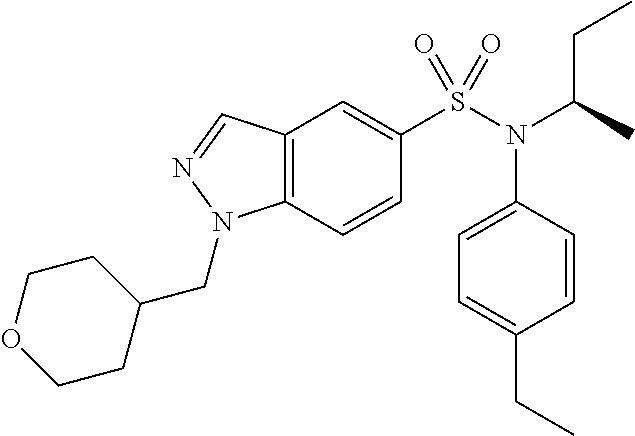


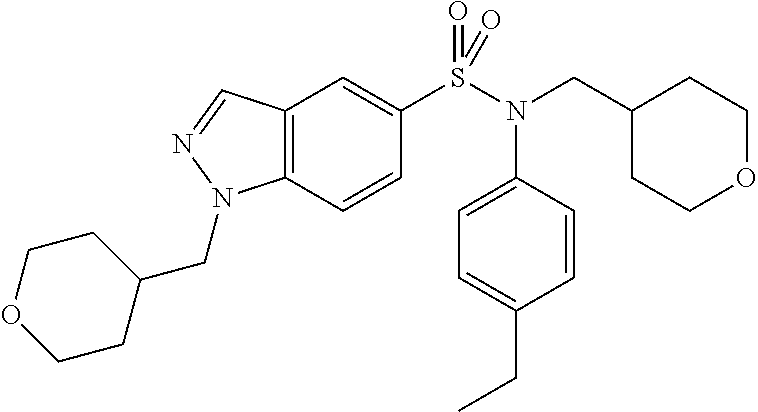
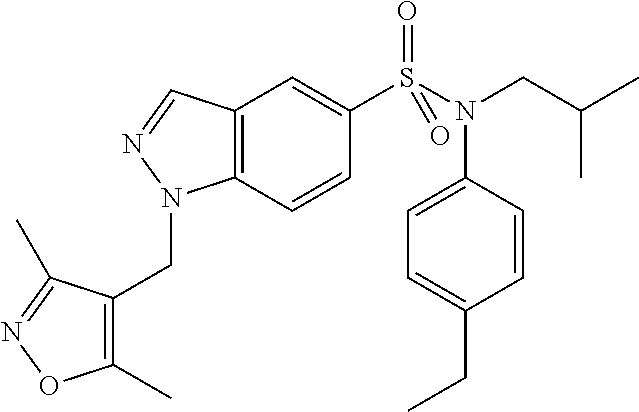
View All Diagrams
| United States Patent | 10,246,440 |
| Musicki , et al. | April 2, 2019 |
Indazole sulfonamide derivatives as inverse agonists of retinoid-related orphan receptor gamma (ROR .gamma. (T))
Abstract
Indazole sulfonamide derivatives of formula (I), the pharmaceutically acceptable addition salts thereof, the hydrates and/or solvates thereof, and the use of same as inverse agonists of retinoid-related orphan receptor gamma ROR.gamma.t are described. Pharmaceutical compositions including such compounds, as well as the use thereof for the topical and/or oral treatment of ROR.gamma.t receptor-mediated inflammatory diseases, in particular acne, psoriasis and/or atopic dermatitis are also described.
| Inventors: | Musicki; Branislav (Nice, FR), Ouvry; Gilles (Biot, FR), Thoreau; Etienne (Saint Vallier de Thiey, FR), Bouix-Peter; Claire (Vallauris, FR) | ||||||||||
|---|---|---|---|---|---|---|---|---|---|---|---|
| Applicant: |
|
||||||||||
| Assignee: | GALDERMA RESEARCH &
DEVELOPMENT (Biot, FR) |
||||||||||
| Family ID: | 52779811 | ||||||||||
| Appl. No.: | 15/537,678 | ||||||||||
| Filed: | December 18, 2015 | ||||||||||
| PCT Filed: | December 18, 2015 | ||||||||||
| PCT No.: | PCT/EP2015/080689 | ||||||||||
| 371(c)(1),(2),(4) Date: | June 19, 2017 | ||||||||||
| PCT Pub. No.: | WO2016/097391 | ||||||||||
| PCT Pub. Date: | June 23, 2016 |
Prior Publication Data
| Document Identifier | Publication Date | |
|---|---|---|
| US 20170342062 A1 | Nov 30, 2017 | |
Foreign Application Priority Data
| Dec 19, 2014 [FR] | 14 63035 | |||
| Jul 3, 2015 [FR] | 15 56341 | |||
| Current U.S. Class: | 1/1 |
| Current CPC Class: | C07D 407/04 (20130101); C07D 471/10 (20130101); A61P 17/10 (20180101); C07D 403/06 (20130101); C07D 209/34 (20130101); C07D 307/79 (20130101); C07D 231/56 (20130101); C07D 409/04 (20130101); C07D 405/12 (20130101); C07D 413/06 (20130101); C07D 401/04 (20130101); C07D 401/14 (20130101); C07D 405/06 (20130101); A61P 17/06 (20180101); C07D 215/36 (20130101); C07D 403/04 (20130101); C07D 417/06 (20130101); C07D 409/06 (20130101); C07D 405/14 (20130101); C07D 401/06 (20130101); C07D 405/04 (20130101); C07D 235/26 (20130101); A61P 17/04 (20180101) |
| Current International Class: | C07D 231/56 (20060101); A61P 17/04 (20060101); A61P 17/10 (20060101); C07D 209/34 (20060101); C07D 307/79 (20060101); C07D 471/10 (20060101); C07D 417/06 (20060101); C07D 409/06 (20060101); C07D 409/04 (20060101); C07D 407/04 (20060101); C07D 405/12 (20060101); C07D 403/06 (20060101); C07D 401/04 (20060101); C07D 215/36 (20060101); C07D 401/06 (20060101); C07D 403/04 (20060101); C07D 405/04 (20060101); C07D 405/06 (20060101); C07D 405/14 (20060101); C07D 413/06 (20060101); A61K 31/416 (20060101); A61P 17/06 (20060101) |
| Field of Search: | ;548/361.1,358.1 ;514/412 |
References Cited [Referenced By]
U.S. Patent Documents
| 2008/0004288 | January 2008 | Santhakumar |
| 2006/052190 | May 2006 | WO | |||
| 2013/160418 | Oct 2013 | WO | |||
| 2014/090712 | Jun 2014 | WO | |||
Other References
|
International Search Report dated Mar. 7, 2016 corresponding to International Patent Application No. PCT/EP2015/080689 (with English translation), 6 pages. cited by applicant . Zhang, Y., et al., "Discovery of 2-oxo-1,2-dihydrobenzo[cd]indole-6-sulfonamide derivatives as new ROR.gamma. inhibitors using virtual screening, synthesis and biological evaluation," European J. Med. Chem., vol. 78, Mar. 2014, pp. 431-444, XP028847891. cited by applicant. |
Primary Examiner: Balasubramanian; Venkataraman
Attorney, Agent or Firm: Talapatra; Sunit Foley & Lardner LLP
Claims
The invention claimed is:
1. A method of treating acne, atopic dermatitis and/or psoriasis comprising administering a pharmaceutical composition comprising at least one compound of formula (I), a pharmaceutically acceptable salt thereof, a hydrate thereof and/or a solvate thereof: ##STR00295## wherein in formula (I): L represents a single bond or a methylene group CH.sub.2, X represents a cyclic radical chosen from the radicals X.sub.1 and X.sub.2 below: ##STR00296## one or two of the elements Y.sup.1, Y.sup.2, Y.sup.3, Y.sup.4 and Y.sup.5 represent(s) a nitrogen atom and the other elements correspond to a group --CR.sup.2, or each of the elements Y.sup.1, Y.sup.2, Y.sup.3, Y.sup.4 and Y.sup.5 corresponds to a group --CR.sup.2, each of the elements Q.sup.1, Q.sup.2 and Q.sup.3 corresponds to an identical or different --CR.sup.2a group, R.sup.1 represents a linear or branched C.sub.3-C.sub.5 alkyl radical, optionally substituted with a hydroxyl group and/or a halogen atom, a C.sub.3-C.sub.5 cycloalkyl radical, a linear or branched C.sub.2-C.sub.5 alkenyl radical, a --CH.sub.2--(C.sub.3-C.sub.5)cycloalkyl radical, a C.sub.4-C.sub.5 heterocycloalkyl radical, a --CH.sub.2--(C.sub.4-C.sub.5)heterocycloalkyl radical, R.sup.2 represents a hydrogen atom or a halogen atom, a linear or branched C.sub.1-C.sub.5 alkyl radical, a linear or branched C.sub.2-C.sub.4 alkenyl radical, a C.sub.1-C.sub.4 alkoxy radical, a cyano group --CN, a radical --C(.dbd.O)R'.sup.2 with R'.sup.2 denoting a C.sub.1-C.sub.3 alkoxy radical, a --CF.sub.3 radical; said alkyl, alkenyl and alkoxy radicals optionally being substituted with one or more halogen atoms, R.sup.2a represents a hydrogen atom or a halogen atom, a linear or branched C.sub.1-C.sub.5 alkyl radical, a linear or branched C.sub.2-C.sub.4 alkenyl radical, a C.sub.1-C.sub.4 alkoxy radical, a --CN group, a hydroxyl group --OH, a group --CH(R.sup.3a)OH, a carboxylic group --COOH, a carbamoyl group --CONR.sup.2cR.sup.2d, an amido group --NR.sup.2cCOR.sup.2d, a group --SO.sub.2R.sup.2c, a group --SOR.sup.2c, a group --S(.dbd.O)(.dbd.NH--R.sup.2c), said alkyl, alkenyl and alkoxy radicals optionally being substituted with one or more halogen atoms, R.sup.2c and R.sup.2d, which are identical or different, represent a hydrogen atom or a linear or branched C1-C.sub.5 alkyl radical; R.sup.3a represents a hydrogen atom or a linear or branched C.sub.1-C.sub.5 alkyl radical, R.sup.3 represents a hydrogen atom, a halogen atom, a group (CHR.sup.6).sub.n--(Z).sub.o--(CHR'.sup.6).sub.p--R.sup.7 or a group CH.dbd.R.sup.7, n, o and p, which are identical or different, represent zero or a natural integer ranging from 1 to 3, Z represents a divalent group selected from the group consisting of a methylene group --CH.sub.2--, an amino group --NH-- and an oxygen atom --O--, R.sup.6 and R'.sup.6, which are identical or different, represent a hydrogen atom, a methyl group --CH.sub.3, a group --OH, a hydroxymethyl group, or a carboxylic function-COOH, R.sup.7 represents: a hydrogen or a halogen atom, a group COOR'.sup.7 with R'.sup.7 denoting (C.sub.1)alkyl(C.sub.6)heterocycle, a heterocycloalkyl radical, wherein the heterocycloalkyl radical is optionally substituted with one or more halogen atoms, one or more linear or branched C.sub.1-C.sub.3 alkyl groups, one or more --OH groups, one or more carbonyl functions, one or more linear or branched C.sub.1-C.sub.4 hydroxyalkyl groups, one or more amino groups, one or more groups --C(.dbd.O)R.sup.7a, one or more groups S(.dbd.O).sub.2R.sup.7a; R.sup.7a representing a linear or branched C.sub.1-C.sub.3 alkyl radical, a linear or branched C.sub.1-C.sub.3 alkoxy radical, or an amino radical N(R.sup.8a)(R.sup.8b), a C.sub.3-C.sub.6 cycloalkyl radical, wherein the cycloalkyl radical is optionally substituted with one or more methyl radicals, one or more halogen atoms, a cyano group --CN or one or more groups --COR.sup.13; R.sup.13 denoting a linear or branched C.sub.1-C.sub.3 alkoxy radical, or a hydroxyl group, an aromatic radical, wherein the aromatic radical is optionally substituted with one or more halogen atoms, one or more linear or branched C.sub.1-C.sub.3 alkyl groups optionally substituted with one or more halogen atoms, one or more C.sub.1-C.sub.3 alkoxy groups, one or more amino groups --NR.sup.11R.sup.12, one or more groups --COR.sup.11, one or more groups --COOR.sup.11, one or more amido groups --CONR.sup.11R.sup.12, one or more groups --SOR.sup.11, one or more groups --SO.sub.2R.sup.11, one or more groups --NHCOR.sup.11, one or more groups --NHCOOR.sup.11, one or more groups --SO.sub.2NR.sup.11R.sup.12 or one or more --CN groups; R.sup.11 and R.sup.12, which are identical or different, representing a hydrogen atom, a hydroxyl radical --OH, a linear or branched C.sub.1-C.sub.3 alkyl radical optionally substituted with one or more halogen atoms; a heteroaromatic radical, wherein the heteroaromatic radical is optionally substituted with one or more halogen atoms, one or more linear or branched C.sub.1-C.sub.3 alkyl groups optionally substituted with one or more halogen atoms, one or more C.sub.1-C.sub.3 alkoxy groups, one or more amino groups --NR.sup.11R.sup.12, one or more groups --COR.sup.11, one or more groups --COOR.sup.11, one or more amido groups --CONR.sup.11R.sup.12, one or more groups --SOR.sup.11, one or more groups --SO.sub.2R.sup.11, one or more groups --NHCOR.sup.11, one or more groups --NHCOOR.sup.11, one or more groups --SO.sub.2NR.sup.11R.sup.12 or one or more --CN groups; R.sup.11 and R.sup.12, which are identical or different, representing a hydrogen atom, a hydroxyl radical --OH, a linear or branched C.sub.1-C.sub.3 alkyl radical optionally substituted with one or more halogen atoms; R.sup.5 represents a hydrogen atom or a halogen atom, a linear or branched C.sub.1-C.sub.3 alkyl radical optionally substituted with one or more halogen atoms; an amino radical --NH.sub.2, a C.sub.4-C.sub.5 heterocyclic radical, an OCH.sub.2--(C.sub.4-C.sub.5) heterocyclic radical, a radical CH.sub.2R.sup.'7a with R'.sup.7a denoting a methoxy radical, a hydroxyl group --OH, a --CH.sub.2COOH group, a group --CH(R.sup.5b)OH, a carboxylic group --COOH, a --CN group, a thioxo function, R.sup.5b represents a hydrogen atom, a linear or branched C.sub.1-C.sub.3 alkyl radical optionally substituted with one or more carboxylic functions; a cyclopropyl radical, R.sup.8a and R.sup.8b, which are identical or different, denote a hydrogen atom, a linear or branched C.sub.1-C.sub.3 alkyl radical or a cyclopropyl radical; and wherein the compound of formula (I) inhibit activity of a ROR.gamma.t receptor.
2. The method as defined by claim 1, wherein R.sup.7 represents a heterocyclic radical selected from the group consisting of: ##STR00297## in which: R.sub.7a represents a linear or branched C.sub.1-C.sub.3 alkyl radical, a linear or branched C.sub.1-C.sub.3 alkoxy radical or an amino radical N(R.sup.8a)(R.sup.8b), R.sup.8a and R.sup.8b, which may be identical or different, denote a hydrogen atom, a linear or branched C.sub.1-C.sub.3 alkyl radical or a cyclopropyl radical, R.sub.8 and R.sup.9, which are identical or different, represent a hydrogen atom, a linear or branched C.sub.1-C.sub.3 alkyl radical, a hydroxyl group --OH, a carbonyl function .dbd.O, a C.sub.1 hydroxyalkyl radical (--CH.sub.2OH), an amino group NH.sub.2, R.sub.8 and R.sub.9 can form, together with the carbon atoms to which they are attached, a 5- to 7-membered carbocyclic ring.
3. The method as defined by claim 1, wherein R.sup.7 represents an aromatic or heteroaromatic radical selected from the group consisting of: ##STR00298## in which: R.sub.10 represents a hydrogen atom or a halogen atom, one linear or branched C.sub.1-C.sub.3 alkyl group optionally substituted with one or more halogen atoms, one C.sub.1-C.sub.3 alkoxy group, one amino group --NR11R.sup.12, one group --COR.sup.11, one group --COOR.sup.11, one amido group --CONR11R.sup.12, one group --SOR.sup.11, one group --SO.sub.2R.sup.11, one group --NHCOR.sup.11, one group --NHCOOR.sup.11, one group --SO.sub.2NR11R.sup.12 or one --CN group; R.sup.11 and R.sup.12, which are identical or different, representing a hydrogen atom or a linear or branched C.sub.1-C.sub.3 alkyl radical optionally substituted with one or more halogen atoms, m denotes zero or a natural integer ranging from 1 to 3.
4. The method as defined by claim 1, wherein the compound, the pharmaceutically acceptable salt thereof, the hydrate thereof and/or the solvate thereof has a structure of formula (II): ##STR00299## wherein in formula (II) R.sup.1, R.sup.3, R.sup.5 and Y.sup.1 to Y.sup.5 have the same meanings as in formula (I).
5. The method as defined by claim 1, wherein the compound has the structure of formula (III), and also the pharmaceutically acceptable addition salts thereof, hydrates thereof and/or solvates thereof: ##STR00300## in which formula (III) R.sup.1, R.sup.3, R.sup.5 and Y.sup.1 to Y.sup.5 have the same meanings as in formula (I).
6. The method as defined by claim 1, wherein the compound is selected from the group consisting of: ##STR00301## ##STR00302## ##STR00303## ##STR00304## ##STR00305## ##STR00306## ##STR00307## ##STR00308## ##STR00309## ##STR00310## ##STR00311## ##STR00312## ##STR00313## ##STR00314## ##STR00315## ##STR00316## ##STR00317## ##STR00318## ##STR00319## ##STR00320##
7. The method as defined by claim 1, wherein the method comprises administering an effective amount of the compound for the treatment of acne to an individual subject in need thereof.
8. The method as defined by claim 1, wherein the method comprises administering an effective amount of the compound for treating psoriasis to an individual subject in need thereof.
Description
CROSS-REFERENCE TO PRIOR APPLICATIONS
This application is a National Stage of PCT/EP2015/080689, filed Dec. 18, 2015, and designating the United States (published on Jun. 23, 2016, as WO 2016/097391 A1), which claims priority under 35 U.S.C. .sctn. 119 to French Application No. 1463035, filed Dec. 19, 2014, and to French Application No. 1556341, filed Jul. 3, 2015 each hereby expressly incorporated by reference in its entirety and each assigned to the assignee hereof.
The present invention relates to particular bicyclic sulfonamide derivatives, to the pharmaceutically acceptable addition salts thereof, hydrates thereof and/or solvates thereof, and also to the use thereof as inverse agonist of the retinoid-related orphan receptor gamma ROR.gamma.t.
The invention also relates to a pharmaceutical composition comprising such compounds and also to the use thereof for the topical and/or oral treatment of inflammatory diseases mediated by the ROR.gamma.t receptors, especially acne, atopic dermatitis and/or psoriasis.
The nuclear receptors form a large family (known as a superfamily) of transcription factors which correspond to proteins that are capable of being activated by a ligand, of binding to specific DNA sequences and of regulating the transcription of target genes. Thus, these receptors are involved in the regulation of a wide variety of biological functions, including growth, development, reproduction, differentiation and metabolism in a multitude of living organisms.
The first members of this superfamily that were identified and described in the scientific literature are the nuclear receptors of steroid hormones such as the glucocorticoid receptors and the estrogen receptors. This superfamily also comprises among its members many receptors for which no ligand has been identified. These nuclear receptors are known as "orphan receptors".
Retinoid-related orphan receptors thus constitute a subfamily of nuclear receptors. This subfamily is composed of three members each having an intrinsic expression profile: ROR alpha (known as ROR.alpha.), ROR beta (known as ROR.beta.) and ROR gamma (known as ROR.gamma.). Two isoforms of the orphan receptors ROR.gamma. have already been identified, namely ROR.gamma.1, which is expressed in a variety of tissues such as the thymus, the kidneys, muscles and the liver, and ROR.gamma.2 (also known as ROR.gamma.t), which is expressed exclusively in the cells of the immune system.
In particular, the receptor ROR.gamma.t plays an important regulating role in cell differentiation of the Th17 lymphocytes which correspond to helper T lymphocytes whose function is to ensure the defence of the body against a large number of extracellular pathogens such as bacteria and fungal infections.
However, it has been demonstrated that the Th17 lymphocytes are also involved in a wide variety of inflammatory disorders, such as acne, and of autoimmune diseases such as psoriasis, rheumatoid arthritis or multiple sclerosis (Peck A, Mellins E D. Precarious balance; Th17 cells in host defense. Infect. Immun. 2010 January; 78(1): 32-8; Suarez-Farinas: J. Allergy Clin. Immunol. 2014; J. Invest. Dermatol. 2008, 128(11), 2625).
Specifically, the Th17 lymphocytes produce numerous cytokines which have distinct profiles, such as interleukin-17A (IL-17A), interleukin-17F (IL-17F), interleukin-26 (IL-26), interleukin-21 (IL-21), interleukin-22 (IL-22) and TNF.alpha., the development, survival and proliferation of which depend on interleukin-23 (IL-23). These cytokines are capable of activating different types of effector cells, such as keratinocytes, thus leading to their hyperproliferation and to the additional production of pro-inflammatory cytokines, chemokines and antimicrobial peptides, which in turn recruit and activate other immune system cells in the inflamed skin, which may lead to amplification of the immune response.
Thus, activation of the Th17 lymphocytes is responsible for the recruitment of cytokines, especially of interleukin-17 (IL17), and of other types of pro-inflammatory cells, which will lead to the mediation of inflammatory disorders such as acne and/or of autoimmune diseases such as psoriasis.
Experiments conducted on mice show that a decrease in the level of expression of the ROR.gamma.t receptor leads to a decrease in the activity of the Th17 lymphocytes, which consequently makes it possible to greatly reduce the expression of interleukin-17 (IL-17) (Ivanov I I, McKenzie B S, Zhou L, Tadokoro C E, Lepelley A, Lafaille J J, Cua D J, Littman D R: Cell 2006, 126, 1121-1133) and to efficiently treat inflammatory disorders and autoimmune diseases mediated by these cytokines, especially those for which high levels of interleukin-17 (IL-17) are detected.
To this end, patent application WO 2013/160 418 describes sulfonamide compounds used as inverse agonists of the ROR.gamma.t receptor in order to be able to treat inflammatory disorders and autoimmune diseases. Similarly, other compounds have also been developed as inverse agonists of the ROR.gamma.t receptor, such as those described in patent applications WO 2014/090 712, WO 2014/008 214, WO 2013/169 588, WO 2013/160 419, WO 2013/1 002 027, WO 2013/092 939, WO 2013/092 941, WO 2013/085 890 and WO 2012/100 732.
There is thus a real need to develop novel compounds as inverse agonists of the ROR.gamma.t receptor in order to be able to efficiently treat diseases mediated by such a receptor, especially inflammatory disorders such as acne, and/or autoimmune diseases such as psoriasis or atopic dermatitis.
This aim is achieved by means of the use of particular bicyclic sulfonamide derivatives as described below, which make it possible to modulate the activity of the ROR.gamma.t receptor and consequently to efficiently treat inflammatory disorders and autoimmune diseases of certain pathologies.
One subject of the present invention is thus especially one or more compounds of formula (Ia), the pharmaceutically acceptable addition salts thereof, hydrates thereof and/or solvates thereof:
##STR00001##
in which formula (I): L represents a single bond or a methylene group CH.sub.2, X represents a cyclic radical chosen from the radicals X.sub.1 and X.sub.2 below:
##STR00002## one or two of the elements Y.sup.1, Y.sup.2, Y.sup.3, Y.sup.4 and Y.sup.5 represent(s) a nitrogen atom and the other elements correspond to a group --CR.sup.2, or each of the elements Y.sup.1, Y.sup.2, Y.sup.3, Y.sup.4 and Y.sup.5 corresponds to a group --CR.sup.2, one or two of the elements Q.sup.1, Q.sup.2 and Q.sup.3 represent(s) a nitrogen atom and the other element(s) correspond(s) to a group --CR.sup.2a, or each of the elements Q.sup.1, Q.sup.2 and Q.sup.3 corresponds to a group --CR.sup.2a, R.sup.1 represents a linear or branched C.sub.3-C.sub.5 alkyl radical, optionally substituted with a hydroxyl group and/or a halogen atom, a C.sub.3-C.sub.5 cycloalkyl radical, a linear or branched C.sub.2-C.sub.5 alkenyl radical, a (C.sub.1)alkyl(C.sub.3-C.sub.5)cycloalkyl radical, a C.sub.4-C.sub.5 heterocycloalkyl radical, a (C.sub.1)alkyl(C.sub.4-C.sub.6)heterocycloalkyl radical, R.sup.2 represents a hydrogen atom or a halogen atom, a linear or branched C.sub.1-C.sub.5 alkyl radical, a linear or branched C.sub.2-C.sub.4 alkenyl radical, a C.sub.1-C.sub.4 alkoxy radical, a cyano group --CN, a radical --C(.dbd.O)R'.sup.2 with R'.sup.2 denoting a C.sub.1-C.sub.3 alkoxy radical, a --CF.sub.3 radical; said alkyl, alkenyl and alkoxy radicals possibly being substituted with one or more halogen atoms, R.sup.2a represents a hydrogen atom or a halogen atom, a linear or branched C.sub.1-C.sub.5 alkyl radical, a linear or branched C.sub.2-C.sub.4 alkenyl radical, a C.sub.1-C.sub.4 alkoxy radical, a --CN group, a hydroxyl group --OH, a group --CH(R.sup.3a)OH, a carboxylic group --COOH, a carbamoyl group --CONR.sup.2cR.sup.2d, an amido group --NR.sup.2cCOR.sup.2d, a group --SO.sub.2R.sup.2c, a group --SOR.sup.2c, a group --S(.dbd.O)(.dbd.NH--R.sup.2c), said alkyl, alkenyl and alkoxy radicals possibly being substituted with one or more halogen atoms, R.sup.2c and R.sup.2d, which may be identical or different, represent a hydrogen atom or a linear or branched C.sub.1-C.sub.5 alkyl radical; R.sup.3a represents a hydrogen atom or a linear or branched C.sub.1-C.sub.5 alkyl radical, R.sup.3 represents a hydrogen atom, a halogen atom, a group (CHR.sup.6).sub.n--(Z).sub.o--(CHR'.sup.6).sub.p--R.sup.7, a group CH.dbd.R.sup.7 or a group --C.dbd.CH--R.sup.7, n, o and p, which may be identical or different, represent zero or a natural integer ranging from 1 to 3, Z represents a divalent group chosen from a methylene group --CH.sub.2--, an amino group --NH-- and an oxygen atom --O--, R.sup.6 and R'.sup.6, which may be identical or different, represent a hydrogen atom, a methyl group --CH.sub.3, a group --OH, a C.sub.1 hydroxyalkyl group, a carboxylic function --COOH, R.sup.7 represents: a hydrogen atom or a halogen atom, a group COOR'.sup.7 with R'.sup.7 denoting (C.sub.1)alkyl(C.sub.6)heterocycle, a non-cationic heterocyclic radical optionally substituted with one or more halogen atoms, one or more linear or branched C.sub.1-C.sub.3 alkyl groups, one or more --OH groups, one or more carbonyl functions, one or more linear or branched C.sub.1-C.sub.4 hydroxyalkyl groups, one or more amino groups, one or more groups --C(.dbd.O)R.sup.7a, one or more groups S(.dbd.O).sub.2R.sup.7a; R.sup.7a representing a linear or branched C.sub.1-C.sub.3 alkyl radical, a linear or branched C.sub.1-C.sub.3 alkoxy radical, or an amino radical N(R.sup.8a)(R.sup.8b), a non-cationic C.sub.3-C.sub.6 cycloalkyl radical optionally substituted with one or more C.sub.1 alkyl radicals, one or more halogen atoms, a cyano group --CN or one or more groups --COR.sup.9; R.sup.9 denoting a linear or branched C.sub.1-C.sub.3 alkoxy radical, or a hydroxyl group, an aromatic or heteroaromatic, non-cationic radical optionally substituted with one or more halogen atoms, one or more linear or branched C.sub.1-C.sub.3 alkyl groups optionally substituted with one or more halogen atoms, one or more C.sub.1-C.sub.3 alkoxy groups, one or more amino groups --NR.sup.11R.sup.12, one or more groups --COR.sup.11, one or more groups --COOR.sup.11, one or more amido groups --CONR.sup.11R.sup.12, one or more groups --SOR.sup.11, one or more groups --SO.sub.2R.sup.1, one or more groups --NHCOR.sup.11, one or more groups --NHCOOR.sup.11, one or more groups --SO.sub.2NRR.sup.12 or one or more --CN groups; R.sup.11 and R.sup.12, which may be identical or different, representing a hydrogen atom, a hydroxyl radical --OH, a linear or branched C.sub.1-C.sub.3 alkyl radical optionally substituted with one or more halogen atoms; when R.sup.3 represents a group --CH.dbd.R.sup.7 or a group --C.dbd.CH--R.sup.7, then R.sup.7 does not represent a hydrogen atom, a halogen atom or a group COOR'.sup.7, R.sup.5 represents a hydrogen atom or a halogen atom, a linear or branched C.sub.1-C.sub.3 alkyl radical optionally substituted with one or more halogen atoms; an amino radical --NH.sub.2, a C.sub.4-C.sub.5 heterocyclic radical, an OCH.sub.2--(C.sub.4-C.sub.5)heterocyclic radical, a radical CH.sub.2R'.sup.7a with R'.sup.7a denoting a C.sub.1 alkoxy radical, a hydroxyl group-OH, a --CH.sub.2COOH group, a group --CH(R.sup.5b)OH, an amino group --NH.sub.2, a carboxylic group --COOH, a --CN group, a thioxo function, R.sup.5b represents a hydrogen atom, a linear or branched C.sub.1-C.sub.3 alkyl radical optionally substituted with one or more carboxylic functions; a cyclopropyl radical, R.sup.8a and R.sup.8b, which may be identical or different, denote a hydrogen atom, a linear or branched C.sub.1-C.sub.3 alkyl radical or a cyclopropyl radical.
The compound(s) according to the invention thus correspond to bicyclic sulfonamide derivatives, and thus to one or more sulfonamide compounds bearing in their structure at least two rings that are fused to each other.
In other words, X is a cyclic radical fused to the aromatic nucleus, comprising the elements Q.sup.1, Q.sup.2 and Q.sup.3 as defined above.
In accordance with the definition of formula (I), the endocyclic bond between the cyclic radical X.sub.1 or X.sub.2, as represented above, and the aromatic nucleus comprising the elements Q.sub.1 to Q.sub.3 is a double bond. Thus, the double bond is common between the cyclic radical X.sub.1 or X.sub.2 and the aromatic nucleus comprising the elements Q.sub.1 to Q.sub.3.
The compounds according to the invention make it possible to modulate, i.e. to inhibit, the activity of the ROR.gamma.t receptor.
A subject of the present invention is also the compound(s) as defined previously, as medicament and cosmetic.
Another subject of the invention relates to the compound(s) as defined previously for their use in the treatment of diseases mediated by the ROR.gamma.t receptor, especially inflammatory disorders and/or autoimmune diseases mediated by the ROR.gamma.t receptor.
Moreover, the invention also relates to a pharmaceutical composition comprising, in a pharmaceutically acceptable medium, one or more compounds of formula (I) as defined previously, pharmaceutically acceptable addition salts thereof, hydrates thereof and/or solvates thereof.
The present invention also relates to the pharmaceutical composition as described previously, for its use in the treatment of diseases mediated by the ROR.gamma.t receptor, especially inflammatory disorders and/or autoimmune diseases.
Finally, the invention relates to a method for treating diseases mediated by the ROR.gamma.t receptor, comprising the administration, especially topically or orally, of a therapeutically effective amount of one or more compounds as defined above to a patient.
Other subjects, characteristics, aspects and advantages of the invention will emerge even more clearly on reading the description and the examples that follow.
According to one embodiment, in formula (I): R.sup.3 represents a hydrogen atom, a group (CHR.sup.6).sub.n--(Z).sub.o--(CHR'.sup.6).sub.p--R.sup.7, a group CH.dbd.R.sup.7 or a group --C.dbd.CH--R.sup.7, and R.sup.5 represents a hydrogen atom or a halogen atom, a linear or branched C.sub.1-C.sub.3 alkyl radical optionally substituted with one or more halogen atoms; an amino radical --NH.sub.2, a radical CH.sub.2R'.sup.7a with R'.sup.7a denoting a C.sub.1 alkoxy radical, a hydroxyl group --OH, a --CH.sub.2COOH group, a group --CH(R.sup.5b)OH, an amino group --NH.sub.2, a carboxylic group --COOH, a --CN group, a thioxo function.
According to one embodiment, in formula (I), L represents a single bond.
According to another embodiment, in formula (I), L represents a methylene group --CH.sub.2.
Preferentially, in formula (I), L represents a single bond.
Preferably: when R.sup.5 is linked to the nitrogen atom, then R.sup.5 represents a hydrogen atom or a --CH.sub.2COOH group, when R.sup.5 is linked to a carbon atom belonging to the cyclic radical X, then R.sup.5 represents a hydroxyl group --OH, a group --CH(R.sup.5b)OH, an amino group --NH.sub.2, a carboxylic group --COOH, a halogen atom or a --CN group.
Preferentially, when X.dbd.X.sub.1, then R.sup.3 is other than a halogen atom and when X.dbd.X.sub.2, then R.sup.5 represents a hydrogen atom or a linear or branched C.sub.1-C.sub.3 alkyl radical optionally substituted with one or more halogen atoms.
More preferentially, R.sup.3 and R.sup.5 are different.
Even more preferentially, R.sup.3 represents a hydrogen atom or a group (CHR.sup.6).sub.n--(Z).sub.o--(CHR'.sup.6).sub.p--R.sup.7.
According to one embodiment, R.sup.3 represents a hydrogen atom or a group (CHR.sup.6).sub.n--(Z).sub.o--(CHR'.sup.6).sub.p--R.sup.7 and R.sup.5 represents a hydrogen atom or a linear or branched C.sub.1-C.sub.3 alkyl radical, optionally substituted with one or more halogen atoms.
Preferably, R.sup.11 and R.sup.12 are other than an --OH group.
According to one embodiment, in formula (I), R.sup.3 represents a hydrogen atom.
According to one embodiment, in formula (I), R.sup.3 represents a group (CHR.sup.6).sub.n--(Z).sub.o--(CHR'.sup.6).sub.p--R.sup.7.
According to one embodiment, in formula (I), the indices n, o and p, which may be identical or different, denote zero.
According to one embodiment, in formula (I), the indices n, o and p, which may be identical or different, denote a natural integer ranging from 1 to 3.
According to one embodiment, in formula (I), the indices n and p denote zero and the index o is equal to 1.
According to one embodiment, in formula (I), Z represents a methylene group --CH.sub.2.
According to one embodiment, in formula (I), Z represents a divalent group-O--.
According to one embodiment, in formula (I), Z represents a divalent group-NH--.
According to one embodiment, in formula (I), R.sup.3 represents a group Z--R.sup.7, with Z having the meaning described previously.
According to a particular embodiment, in formula (I), R.sup.3 represents a group-CH.sub.2--R.sup.7.
According to a particular embodiment, in formula (I), R.sup.3 represents a group-O--R.sup.7.
According to a particular embodiment, in formula (I), R.sup.3 represents a group-NH--R.sup.7.
According to one embodiment, in formula (I), R.sup.7 represents a heterocyclic radical chosen from the following heterocycles:
##STR00003##
in which: R.sub.7a represents a linear or branched C.sub.1-C.sub.3 alkyl radical, a linear or branched C.sub.1-C.sub.3 alkoxy radical or an amino radical N(R.sup.8a)(R.sup.8b), R.sup.8a and R.sup.8b, which may be identical or different, denote a hydrogen atom, a linear or branched C.sub.1-C.sub.3 alkyl radical or a cyclopropyl radical, R.sub.8 and R.sub.9, which may be identical or different, represent a hydrogen atom, a linear or branched C.sub.1-C.sub.3 alkyl radical, a hydroxyl group --OH, a carbonyl function .dbd.O, a C.sub.1 hydroxyalkyl radical (--CH.sub.2OH), an amino group NH.sub.2, R.sub.8 and R.sub.9 can form, together with the carbon atoms to which they are attached, a 5- to 7-membered carbocyclic ring.
According to one embodiment, in formula (I), R.sup.7 represents an aromatic or heteroaromatic radical chosen from:
##STR00004##
in which: R.sub.10 represents a hydrogen atom or a halogen atom, one linear or branched C.sub.1-C.sub.3 alkyl group optionally substituted with one or more halogen atoms, one C.sub.1-C.sub.3 alkoxy group, one amino group --NR.sup.11R.sup.12, one group --COR.sup.11, one group --COOR.sup.11, one amido group --CONR.sup.11R.sup.12, one group --SOR.sup.11, one group --SO.sub.2R.sup.11, one group --NHCOR.sup.11, one group --NHCOOR.sup.11, one group --SO.sub.2NR.sup.11R.sup.12 or one --CN group; R.sup.11 and R.sup.12, which may be identical or different, representing a hydrogen atom or a linear or branched C.sub.1-C.sub.3 alkyl radical optionally substituted with one or more halogen atoms, m denotes zero or a natural integer ranging from 1 to 3.
Preferably, R.sup.11 and R.sup.12 are other than an --OH group.
Preferentially, R.sup.7 represents an aromatic or heteroaromatic radical as defined previously, optionally substituted with one or more methyl groups --CH.sub.3, one or more methoxy groups --OCH.sub.3, one or more hydroxyl groups --OH, one or more amino groups --NH.sub.2, one or more --CH.sub.2OH groups, one or more cyano groups --CN, one or more halogen atoms or one or more carbonyl functions.
According to one embodiment, the index m is equal to zero.
According to one embodiment, the index m denotes a natural integer ranging from 1 to 3.
Preferentially, the index m is equal to 1.
According to one embodiment, in formula (I), each of the elements Y.sup.1, Y.sup.2, Y.sup.3, Y.sup.4 and Y.sup.5 corresponds to a group --CR.sup.2 with R.sup.2 having the same meaning as that described previously.
According to one embodiment, in formula (I), each of the elements Y.sup.1, Y.sup.2, Y.sup.3, Y.sup.4 and Y.sup.5 corresponds to a group --CR.sup.2 with R.sup.2 representing a hydrogen atom.
According to one embodiment, in formula (I), each of the elements Y.sup.1, Y.sup.2, Y.sup.3, Y.sup.4 and Y.sup.5 corresponds to a group --CR.sup.2 with R.sup.2 representing a linear or branched C.sub.1-C.sub.5 alkyl radical.
According to one embodiment, in formula (I), each of the elements Q.sup.1, Q.sup.2 and Q.sup.3 represents a group --CR.sup.2a with R.sup.2a having the same meaning as that described previously.
According to one embodiment, in formula (I), each of the elements Q.sup.1, Q.sup.2 and Q.sup.3 represents a group --CR.sup.2a with R.sup.2a representing a hydrogen atom.
According to one embodiment, in formula (I), Q.sup.1 and Q.sup.2 represent a group-CR.sup.2a with R.sup.2a representing a hydrogen atom and Q.sup.3 represents a group --CR.sup.2a with R.sup.2a representing a linear or branched C.sub.1-C.sub.5 alkyl radical.
According to one embodiment, in formula (I), R.sup.1 represents a linear or branched C.sub.3-C.sub.5 alkyl radical, preferably a branched C.sub.3-C.sub.5 and more preferentially branched C.sub.4 alkyl radical.
According to one embodiment, in formula (I), R.sup.1 represents a C.sub.3-C.sub.5 cycloalkyl radical, preferably cyclopropyl.
According to one embodiment, in formula (I), R.sup.1 represents a linear or branched C.sub.2-C.sub.5 alkenyl radical.
According to one embodiment, in formula (I), R.sup.1 represents a CH.sub.2--(C.sub.3-C.sub.5)cycloalkyl radical.
According to one embodiment, in formula (I), R.sup.1 represents a C.sub.4-C.sub.5 heterocycloalkyl radical.
According to one embodiment, in formula (I), R.sup.1 represents a CH.sub.2--(C.sub.4-C.sub.6)heterocycloalkyl radical, in particular a CH.sub.2--(C.sub.4-C.sub.5)heterocycloalkyl radical.
Preferentially, R.sup.1 represents a linear or branched C.sub.3-C.sub.5 alkyl radical, or a CH.sub.2--(C.sub.4-C.sub.5)heterocycloalkyl radical.
According to one embodiment, R.sup.5 represents a hydrogen atom.
Preferably, the compound(s) of formula (I) are chosen from the compound(s) of formula (II), the pharmaceutically acceptable addition salts thereof, hydrates thereof and/or solvates thereof:
##STR00005##
in which formula (II) R.sup.1, R.sup.3, R.sup.5 and Y.sup.1 to Y.sup.5 have the same meanings as in formula (I) described previously.
Preferentially, R.sup.3 represents a group (CHR.sup.6).sub.n--(Z).sub.o--(CHR'.sup.6).sub.p--R.sup.7 with R.sup.6, Z, R'.sup.6, R.sup.7 and the indices n, o and p having the same meanings as those indicated previously.
More preferentially, R.sup.3 represents a group CH.sub.2--R.sup.7 with R.sup.7 representing a non-cationic heterocyclic radical.
Preferably, the compound(s) of formula (I) are chosen from the compound(s) of formula (III), the pharmaceutically acceptable addition salts thereof, hydrates thereof and/or solvates thereof:
##STR00006##
in which formula (III) R.sup.1, R.sup.3, R.sup.5 and Y.sup.1 to Y.sup.5 have the same meanings as in formula (I) described previously.
Preferentially, in formula (III), R.sub.5 represents a hydrogen atom or a linear or branched C.sub.1-C.sub.3 alkyl radical optionally substituted with one or more halogen atoms.
The compounds of formula (I) may be in the form of pharmaceutically acceptable salts. Examples of pharmaceutically acceptable salts are described in Berge et al., 1977, "Sels pharmaceutiquement acceptables" [Pharmaceutically acceptable salts], J. Pharm. Sci., Vol. 66, pages 1-19.
In particular, when the compounds of formula (I) according to the invention are in the form of salts, then the electrical neutrality of said compounds is ensured by an external cationic counterion Y which may be organic or mineral.
Y may be chosen from suitable inorganic cations such as alkali metal ions, especially Na.sup.+, K.sup.+, alkaline-earth metal ions, especially Ca.sup.2+, Mg.sup.2+, or alternatively other cations such as the aluminum ion Al.sup.3+.
Y may be chosen from suitable organic cations such as the ammonium ion NH.sub.4.sup.+, substituted ammonium ions such as NH.sub.3R.sup.+, NHR.sub.2.sup.+, NR.sub.4.sup.+ with R representing a C.sub.1-C.sub.4 alkyl radical.
In particular, the substituted ammonium ions are those chosen from derivatives of ethylamine, diethylamine, dicyclohexylamine, triethylamine, butylamine, ethylenediamine, ethanolamine, diethanolamine, piperazine, benzylamine, phenylbenzylamine, choline, meglumine and tromethamine, and amino acids such as lysine and arginine.
An example of a quaternary ammonium ion may be the ion N.sup.+(CH.sub.3).sub.4.
The compound(s) according to the invention may be in the form of the solvates thereof.
For the purposes of the present invention, the term "solvate" means a complex of solute (i.e. the compound according to the invention or the salt of said compound) and of solvent.
If the solvent is water, then the solvate may suitably be considered as a hydrate, for example, a hemihydrate, a monohydrate, a dihydrate, a trihydrate, etc.
For example, the solvates and/or hydrates may be obtained directly at the end of the synthetic process, the target compound being isolated in the form of a hydrate, for example a monohydrate or hemihydrate, or in the form of a solvate of the reaction solvent and/or purification solvent.
Unless otherwise indicated, any reference to a compound according to the invention also includes the solvate or the hydrate of the corresponding compound.
Typical processes for the preparation and identification of hydrates and solvates are well known to those skilled in the art: see, for example, pages 202-209 of K J Guillory, "Generation of Polymorphs, Hydrates, Solvates, and Amorphous Solids" in Polymorphism in Pharmaceutical Solids, edition. Harry G. Britain, Vol. 95, Marcel Dekker, Inc., New York, 1999.
The hydrates and solvates may be isolated and characterized via methods known in the art, such as thermogravimetric analysis (TGA), TGA-mass spectroscopy, TGA-infrared spectroscopy, x-ray powder diffraction, Karl Fischer titration, high-resolution x-ray diffraction, and the like.
Preferably, the compound(s) of formula (Ia) are chosen from the compounds as described in the tables below, and also the pharmaceutically acceptable addition salts thereof, hydrates thereof and/or solvates thereof:
TABLE-US-00001 TABLE 1 IC50 IC50 hRORg hCD4/IL17 ##STR00007## 1-(tetrahydropyran-4- ylmethyl)-1H- indazole-5-sulfonic acid (4-ethylphenyl)(1- ethylpropyl)amide Compound 1 B B ##STR00008## 1-(tetrahydropyran-4- ylmethyl)-1H- indazole-5-sulfonic acid ((R)-sec-butyl)(4- ethylphenyl)amide Compound 2 B ND ##STR00009## 1-(tetrahydropyran-4- ylmethyl)-1H- indazole-5-sulfonic acid cyclopropyl(4- ethylphenyl)amide Compound 3 C ND ##STR00010## 3-bromo-1- (tetrahydropyran-2- yl)-1H-indazole-6- sulfonic acid (4- ethylphenyl)isobutyl- amide Compound 4 C ND ##STR00011## 1-(tetrahydropyran-4- ylmethyl)-1H- indazole-5-sulfonic acid (4- ethylphenyl)(tetrahy- dropyran-4- ylmethyl)amide Compound 5 C ND ##STR00012## 1-((3,5- dimethylisoxazol-4- yl)methyl)-N-(4- ethylphenyl)-N- isobutyl-1H-indazole- 5-sulfonamide Compound 6 B ND ##STR00013## 1-(tetrahydropyran-4- ylmethyl)-1H- indazole-5-sulfonic acid butyl(4- isopropylphenyl)amide Compound 7 B ND ##STR00014## 1-(tetrahydropyran-4- ylmethyl)-1H- indazole-5-sulfonic acid (4- ethylphenyl)propyl Compound 8 C ND ##STR00015## 1-(tetrahydropyran-4- ylmethyl)-1H- indazole-5-sulfonic acid butyl(4- ethylphenyl)amide Compound 9 C ND ##STR00016## 1-(tetrahydropyran-4- ylmethyl)-1H- indazole-5-sulfonic acid (5-chloro-2- fluorophenyl)isobutyl- amide Compound 10 C ND ##STR00017## 1-(tetrahydropyran-4- ylmethyl)-1H- indazole-5-sulfonic acid (2,5- dimethylphenyl)iso- butylamide Compound 11 B ND ##STR00018## 1-(tetrahydropyran-4- ylmethyl)-1H- indazole-5-sulfonic acid (3- methoxypyridin-2- yl)isobutylamide Compound 12 C ND ##STR00019## 1-(tetrahydropyran-4- ylmethyl)-1H- indazole-5-sulfonic acid (4-butyl-2- methylphenyl)isobutyl amide Compound 13 B ND ##STR00020## N-(4-ethylphenyl)-N- isobutyl-1- ((tetrahydro-2H-pyran- 4-yl)methyl)-1H- indazole-5- sulfonamide Compound 14 C ND ##STR00021## 3-amino-1H-indazole- 5-sulfonic acid (4- ethylphenyl)isobutyl- amide Compound 15 C ND ##STR00022## 1-(tetrahydropyran-4- ylmethyl)-1H- indazole-5-sulfonic acid (4- ethylphenyl)oxetan-3- ylmethylamide Compound 16 C ND ##STR00023## 1-(1-acetylpyrrolidin- 3-yl)-1H-indazole-5- sulfonic acid (4- ethylphenyl)isobutyl- amide Compound 17 B ND ##STR00024## 3-(tetrahydropyran-4- ylmethoxy)-1- (tetrahydropyran-4- ylmethyl)-1H- indazole-5-sulfonic acid (4- ethylphenyl)isobutyl- amide Compound 18 C ND ##STR00025## 1-(3,5- dimethylisoxazol-4- ylmethyl)-1H- indazole-5-sulfonic acid (4- ethylphenyl)isobutyl- amide Compound 19 C ND ##STR00026## 1-((1-acetylpyrrolidin- 3-yl)methyl)-N-(4- ethylphenyl)-N- isobutyl-1H-indazole- 5-sulfonamide Compound 20 C ND ##STR00027## N-(4-ethylphenyl)-N- isobutyl-1- ((tetrahydrofuran-3- yl)methyl)-1H- indazole-5- sulfonamide Compound 21 C ND ##STR00028## N-(4-ethylphenyl)-N- isobutyl-1- ((tetrahydro-2H-pyran- 3-yl)methyl)-1H- indazole-5- sulfonamide Compound 22 C ND ##STR00029## 1-benzyl-N-(4- ethylphenyl)-N- isobutyl-1H-indazole- 5-sulfonamide Compound 23 C ND ##STR00030## N-(cyclobutylmethyl)- N-(4-ethylphenyl)-1- ((tetrahydro-2H-pyran- 4-yl)methyl)-1H- indazole-5- sulfonamide Compound 24 B ND ##STR00031## 1-(tetrahydropyran-4- ylmethyl)-1H- indazole-5-sulfonic acid (3- methoxyphenyl)iso- butylamide Compound 25 C ND ##STR00032## 1-(tetrahydropyran-4- ylmethyl)-1H- indazole-5-sulfonic acid (3- methylphenyl)isobutyl amide Compound 26 C ND ##STR00033## 1-(tetrahydropyran-4- ylmethyl)-1H- indazole-5-sulfonic acid (2,4- dimethylphenyl)iso- butylamide Compound 27 B B ##STR00034## 1-(tetrahydropyran-4- ylmethyl)-1H- indazole-5-sulfonic acid (3,5- dimethylphenyl)iso- butylamide Compound 28 C ND ##STR00035## N-(4-ethylphenyl)-N- isopropyl-1- ((tetrahydro-2H-pyran- 4-yl)methyl)-1H- indazole-5- sulfonamide Compound 29 C ND ##STR00036## 1-(tetrahydropyran-4- ylmethyl)-1H- indazole-5-sulfonic acid sec-butyl(4- ethylphenyl)amide Compound 30 B ND ##STR00037## N- (cyclopropylmethyl)- N-(4-ethylphenyl)-1- ((tetrahydro-2H-pyran- 4-yl)methyl)-1H- indazole-5- sulfonamide Compound 31 C ND ##STR00038## 1-(tetrahydropyran-4- ylmethyl)-1H- indazole-5-sulfonic acid cyclopentyl(4- ethylphenyl)amide Compound 32 A ND ##STR00039## 1-(tetrahydropyran-4- ylmethyl)-1H- indazole-5-sulfonic acid (4- ethylphenyl)(tetrahy- drofuran-3- ylmethyl)amide Compound 33 C ND ##STR00040## 3-amino-1H-indazole- 5-sulfonic acid (4- ethylphenyl)isobutyl- amide Compound 34 C ND ##STR00041## N-(4-ethylphenyl)-N- isopentyl-1- ((tetrahydro-2H-pyran- 4-yl)methyl)-1H- indazole-5- sulfonamide Compound 35 C ND ##STR00042## N-(4-ethylphenyl)-N- isobutyl-1-(pyridin-4- ylmethyl)-1H- indazole-5- sulfonamide Compound 36 B A ##STR00043## N-(4-ethylphenyl)-N- isobutyl-1-(oxetan-3- ylmethyl)-1H- indazole-5- sulfonamide Compound 37 B A ##STR00044## 1-(tetrahydropyran-4- yl)-1H-indazole-5- sulfonic acid (4- ethylphenyl)isobutyl- amide Compound 38 C ND ##STR00045## N-(4-ethylphenyl)-N- isobutyl-1- ((tetrahydro-2H-pyran- 4-yl)methyl)-1H- indazole-5- sulfonamide Compound 39 B B
TABLE-US-00002 TABLE 2 IC50 IC50 hRORg hCD4/IL17 ##STR00046## 1-(1-acetylpyrrolidin-3-yl)- 1H-indazole-5-sulfonic acid (4- ethylphenyl)isobutylamide Compound 40 C ND ##STR00047## 1-(tetrahydropyran-4- ylmethyl)-1H-indazole-5- sulfonic acid cyclobutyl(4- ethylphenyl)amide Compound 41 C ND ##STR00048## 1-(tetrahydropyran-4- ylmethyl)-1H-indazole-5- sulfonic acid (5-fluoro-2- methylphenyl)isobutyl- amide Compound 42 B ND ##STR00049## 1-(tetrahydropyran-4- ylmethyl)-2H-indazole-5- sulfonic acid (3-fluoro-2- methylphenyl)isobutyl- amide Compound 43 B ND ##STR00050## 1-(tetrahydropyran-4- ylmethyl)-1H-indazole-5- sulfonic acid (5- chlorophenyl)isobutylamide Compound 44 C ND ##STR00051## 1-(tetrahydropyran-4- ylmethyl)-1H-indazole-5- sulfonic acid (2- chlorophenyl)isobutylamide Compound 45 C ND ##STR00052## 1-(tetrahydropyran-4- ylmethyl)-1H-indazole-5- sulfonic acid (4- fluorophenyl)isobutylamide Compound 46 C ND ##STR00053## 1-(tetrahydropyran-4- ylmethyl)-1H-indazole-5- sulfonic acid isobutyl-p- tolylamide Compound 47 C ND ##STR00054## 1-(tetrahydropyran-4- ylmethyl)-1H-indazole-5- sulfonic acid isobutyl-o- tolylamide Compound 48 C ND ##STR00055## 1-(tetrahydropyran-4- ylmethyl)-1H-indazole-5- sulfonic acid (4- trifluoromethoxyphenyl)iso- butylamide Compound 49 C ND ##STR00056## 1-(tetrahydropyran-4- ylmethyl)-1H-indazole-5- sulfonic acid isobutyl(5- isopropylpyridin-2-yl)amide Compound 50 C ND ##STR00057## 1-(tetrahydropyran-4- ylmethyl)-1H-indazole-5- sulfonic acid (3- chlorobenzyl)isobutylamide Compound 51 C ND ##STR00058## 1-(tetrahydropyran-4- ylmethyl)-1H-indazole-5- sulfonic acid isobutyl(2- trifluoromethylbenzyl)amide Compound 52 B ND ##STR00059## 1-(tetrahydropyran-4- ylmelhyl)-1H-indazole-5- sulfonic acid (2-fluoro-6- methylphenyl)isobutylamide Compound 53 C ND ##STR00060## 1-(tetrahydropyran-4- ylmethyl)-1H-indazole-5- sulfonic acid (4-fluoro-2- methylphenyl)isobutylamide Compound 54 B ND ##STR00061## 1-(tetrahydropyran-4- ylmethyl)-1H-indazole-5- sulfonic acid isobutyl(4- methoxy-2- methylphenyl)amide Compound 55 B ND ##STR00062## methyl 4-{isobutyl[1- (tetrahydropyran-4- ylmethyl)-1H-indazole-5 - sulfonyl]amino}-3- methylbenzoate Compound 56 B A ##STR00063## 1-(tetrahydropyran-4- ylmethyl)-1H-indazole-5- sulfonic acid (4-cyano-2- methylphenyl)isobutylamide Compound 57 B ND ##STR00064## 1-(tetrahydropyran-4- ylmethyl)-1H-indazole-5- sulfonic acid isobutyl(2- trifluoromethylphenyl)amide Compound 58 B ND ##STR00065## 1-(tetrahydropyran-4- ylmethyl)-1H-indazole-5- sulfonic acid isobutyl(4- trifluoromethylphenyl)amide Compound 59 C ND ##STR00066## 1-(tetrahydropyran-4- ylmethyl)-1H-indazole-5- sulfonic acid (3-chloro-2- hydroxymethylpropyl)(4- ethylphenyl)amide Compound 60 C ND ##STR00067## 3-(tetrahydropyran-4- ylmethoxy)-1H-indazole-5- sulfonic acid (4- ethylphenyl)isobutylamide Compound 61 C ND ##STR00068## 3-(tetrahydropyran-4- ylidenemethyl)-1H- indazole-6-sulfonic acid (4- ethylphenyl)isobutylamide Compound 62 A ND ##STR00069## 3-(tetrahydropyran-4- ylmethyl)-1H-indazole-6- sulfonic acid (4- ethylphenyl)isobutylamide Compound 63 A A ##STR00070## 3-morpholin-4-ylmethyl- 1H-indazole-6-sulfonic acid (4- ethylphenyl)isobutylamide Compound 64 A A ##STR00071## 3-((cis)-2,6- dimethylmorpholin-4- ylmethyl)-1H-indazole-6- sulfonic acid (4- ethylphenyl)isobutylamide Compound 65 C ND ##STR00072## 3-((S)-3-methylmorpholin- 4-ylmethyl)-1H-indazole-6- sulfonic acid (4- ethylphenyl)isobutylamide Compound 66 B ND ##STR00073## 1-(tetrahydropyran-4- ylmethyI)-1H-indazole-5- sulfonic acid isobutyl-o- tolylamide Compound 69 C ND ##STR00074## 1-(tetrahydropyran-4- ylmethyl)-1H-indazole-5- sulfonic acid (2-cyano-4- methylphenyl)isobutylamide Compound 70 B ND ##STR00075## 1-(tetrahydropyran-4- ylmethyl)-1H-indazole-5- sulfonic acid (4,6- dimethylpyridin-3- yl)isobutylamide Compound 71 C C ##STR00076## 1-(tetrahydropyran-4- ylmethyl)-1H-indazole-5- sulfonic acid (4- dimethylaminophenyl)iso- butylamide Compound 72 B B ##STR00077## 1-(tetrahydropyran-4- ylmethyl)-1H-indazole-5- sulfonic acid (2-fluoro-4- methylphenyl)isobutylamide Compound 73 ND ND ##STR00078## methyl 5-[(4- ethylphenyl)isobutylsul- famoyl]-1- (tetrahydropyran-4- ylmethyl)-1H-indazole- 7-carboxylate Compound 74 C ND ##STR00079## 5-[(4- ethylphenyl)isobutylsul- famoyl]-1- (tetrahydropyran-4- ylmethyl)-1H-indazole- 7-carboxylic acid amide Compound 75 ND ND ND: not determined; A: IC50 < 100 nM.; B: IC50 = 100 nM-1 .mu.M; C: IC50 > 1 .mu.M
In the tables described above, the median inhibitory concentrations IC.sub.50 for the compounds belonging to formula (I) according to the invention have been given according to the following models:
GAL4-ROR.gamma. Transactivation
The ROR.gamma. transactivation model was developed from the line HG5LN, which is a HeLa line that stably expresses a luciferase reporter gene controlled by a pentamer of the GAL4 recognition domain of yeast and of a .beta.-globin promoter. The HG5LN line was stably transfected by the DNA-binding domain (DBD) of GAL4 fused to the ROR gamma ligand-binding domain (LBD). Molecules that inhibit the ROR gamma constitutive activity reduce the luciferase expression, thus leading to a reduction in the emitted luminescence.
The cells are seeded in 384-well plates (5000 cells in 45 .mu.L/well of culture medium containing 10% fetal calf serum) and incubated for 4 hours at 37.degree. C., 5% CO.sub.2. 5 .mu.L of the test molecules (compounds described in the tables described above) are then added to each well and the plates are incubated for 18 hours at a temperature of 37.degree. C. under 5% of CO.sub.2. 20 .mu.L of luciferase substrate (Promega) are added to each well and the luminescence emitted is read by a microplate reader.
The luminescence units ("RLU") are normalized by positive controls ("POS" containing a saturated concentration of N-(2,2,2-trifluoroethyl)-N-[4-[2,2,2-trifluoro-1-hydroxy-1-(trifluorometh- yl)ethyl]phenyl])benzenesulfonamide and negative controls ("NEG" containing DMSO): % inhibition=((RLU-NEG)*100)/(POS-NEG). The IC50 values are calculated from a 4-parameter logistic model using the XLFit software (IDBS).
IL-17A Secretion
This model allows measurement of the effect of inhibitors on IL-17A secretion by CD4+ cells. The cells are frozen CD4+ cells (STEMCELL, #70026), isolated from peripheral human blood and activated with anti-CD3 and anti-CD28 antibodies. The amount of IL-17a secreted is measured by the TR-FRET (kit HTRF.RTM. Human Interleukin 17A (Cisbio, #64H17PEC)) technology.
The cells are rapidly thawed, resuspended in their culture medium (RPMI inactivated 10% FCS) supplemented with soluble anti-CD28 antibodies and seeded (100 000 cells/well) in 96-well plates precoated with anti-CD3 antibodies. The cells are then treated with the ranges of inhibitors to be tested (from 1000 nM to 0.05 nM, 0.1% DMSO). After 4 days of incubation, the HTRF signal is measured using a microplate reader (.lamda.excitation=337 nm, .lamda.emission=620/665 nm). The ratios obtained (665/620) are normalized relative to the positive control (cells activated with anti-CD3 and anti-CD28, 0.1% DMSO). The IC.sub.50 values are calculated from a 4-parameter logistic model using the XLFit software (IDBS).
Preferentially, the compounds of formula (I) according to the invention are chosen from the following compounds:
TABLE-US-00003 TABLE 3 ##STR00080## N-(4-ethylphenyl)-N-isobutyl-1- ((tetrahydro-2H-pyran-4- yl)methyl-1H- indazole-5-sulfonamide Compound 39 ##STR00081## N-(4-ethylphenyl)-N-isobutyl-1- (oxetan-3-ylmethyl)-1H-indazole-5- sulfonamide Compound 37 ##STR00082## 1-((1-acetylpyrrolidin-3- yl)methyl)-N- (4-ethylphenyl)-N-isobutyl-1H- indazole-5-sulfonamide Compound 20 ##STR00083## 1-((3,5-dimethylisooxazol- 4-yl)methyl)- N-(4-ethylphenyl)-N-isobutyl-1H- indazole-5-sulfonamide Compound 24 ##STR00084## 1-(1-acetylpyrrolidin-3- yl)-1H-indazole- 5-sulfonic acid (4- ethylphenyl)isobutylamide Compound 40 ##STR00085## N-(cyclobutylmethyl)-N-(4- ethylphenyl)-1-((tetrahydro- 2H-pyran-4- yl)methyl)-1H-indazole-5- sulfonamide Compound 24 ##STR00086## 1-(tetrahydropyran-4- ylmethyl)-1H- indazole-5-sulfonic acid cyclopentyl(4- ethylphenyl)amide Compound 32 ##STR00087## 1-(tetrahydropyran-4- ylmethyl)-1H- indazole-5-sulfonic acid sec-butyl(4- ethylphenyl)amide Compound 30 ##STR00088## 1-(tetrahydropyran-4- ylmethyl)-1H- indazole-5-sulfonic acid (4- ethylphenyl)(1-ethylpropyl)amide Compound 1 ##STR00089## 1-(tetrahydropyran-4- ylmethyl)-1H- indazole-5-sulfonic acid butyl(4- isopropylphenyl)amide Compound 7 ##STR00090## 1-(tetrahydropyran-4- ylmethyl)-1H- indazole-5-sulfonic acid (5-fluoro-2- methylphenyl)isobutylamide Compound 42 ##STR00091## 1-(tetrahydropyran-4- ylmethyl)-2H- indazole-5-sulfonic acid (3-fluoro-2- methylphenyl)isobutylamide Compound 43 ##STR00092## 1-(tetrahydropyran-4- ylmethyl)-1H- indazole-5-sulfonic acid (2,5- dimethylphenyl)isobutylamide Compound 11 ##STR00093## 1-(tetrahydropyran-4- ylmethyl)-1H- indazole-5-sulfonic acid (4-butyl-2- methylphenyl)isobutylamide Compound 13 ##STR00094## 1-(tetrahydropyran-4- ylmethyl)-1H- indazole-5-sulfonic acid (2,4- dimethylphenyl)isobutylamide Compound 27 ##STR00095## 1-(tetrahydropyran-4- ylmethyl)-1H- indazole-5-sulfonic acid isobutyl(2- trifluoromethylbenzyl)amide Compound 52 ##STR00096## 1-(tetrahydropyran-4- ylmethyl)-1H- indazole-5-sulfonic acid (4-fluoro-2- methylphenyl)isobutylamide Compound 54 ##STR00097## 1-(tetrahydropyran-4- ylmethyl)-1H- indazole-5-sulfonic acid isobutyl(4- methoxy-2-methylphenyl)amide Compound 55 ##STR00098## 1-(tetrahydropyran-4- ylmethyl)-1H- indazole-5-sulfonic acid (4-cyano-2- melhylphenyl)isobutylamide Compound 57 ##STR00099## 1-(tetrahydropyran-4- ylmethyl)-1H- indazole-5-sulfonic acid isobutyl(2- trifluoromethylphenyl)amide Compound 58 ##STR00100## 3-(tetrahydropyran-4- ylmethyl)-1H- indazole-6-sulfonic acid (4- ethylphenyl)isobutylamide Compound 63 ##STR00101## 3-morpholin-4-ylmethyl- 1H-indazole-6- sulfonic acid (4- ethylphenyl)isobutylamide Compound 64 ##STR00102## 3-((S)-3-methylmorpholin- 4-ylmethyl)- 1H-indazole-6-sulfonic acid (4- ethylphenyl)isobutylamide Compound 66
In particular, among the compounds of formula (II), compounds 1, 2, 7, 11, 21, 24, 27, 30, 32, 36, 37, 39, 40, 42, 43, 52, 54, 55, 57 and 58 are preferred.
Among the compounds of formula (III), compounds 63, 64 and 66 are preferred.
The invention also relates to the compound(s) as described previously, as medicament and cosmetic.
Preferably, the invention also relates to the compound(s) as described previously, as medicament.
Specifically, the compounds according to the invention have advantageous pharmacological properties, given that said compounds modulate, i.e. inhibit, the activity of the ROR.gamma.t receptor.
Thus, these properties make the compound(s) of formula (I) as described previously usable as medicament in the treatment of diseases mediated by the ROR.gamma.t receptor.
Preferably, the compound(s) according to the invention are used in the treatment of inflammatory disorders and/or autoimmune diseases mediated by the ROR.gamma.t receptor.
More preferentially, the compound(s) according to the invention, preferably those chosen from the compounds corresponding to formulae (II) and (III), are used in the treatment of acne, psoriasis and/or atopic dermatitis.
According to another embodiment, the compounds according to the invention are used for cosmetic treatment of the skin.
As indicated above, the present invention also relates to a pharmaceutical composition comprising, in a pharmaceutically acceptable medium, one or more compounds of formula (I) as defined previously, pharmaceutically acceptable addition salts thereof, hydrates thereof and/or solvates thereof.
Preferably, the pharmaceutical composition comprises one or more compounds chosen from the compounds of formulae (II) and (III) as defined previously, the pharmaceutically acceptable addition salts thereof, hydrates thereof and/or solvates thereof.
More preferentially, the pharmaceutical composition comprises one or more compounds of formula (I) chosen from compounds (1) to (75) defined previously.
Even more preferentially, the pharmaceutical composition comprises one or more compounds of formula (I) chosen from compounds 1, 2, 7, 11, 21, 24, 27, 30, 32, 36, 37, 39, 40, 42, 43, 52, 54, 55, 57, 58, 63, 64 and 66.
The pharmaceutical composition according to the invention as described previously may be administered orally or topically.
Preferably, the pharmaceutical composition is conditioned in a form that is suitable for topical application.
Via the oral route, the composition may be in the form of tablets, gel capsules, coated tablets, syrups, suspensions, solutions, powders, granules, emulsions, suspensions of microspheres or nanospheres or lipid or polymeric vesicles allowing controlled release.
Via the topical route, the pharmaceutical composition according to the invention is more particularly intended for treating the skin and mucous membranes, and may be in liquid, pasty or solid form, and more particularly in the form of ointments, creams, milks, pomades, powders, impregnated pads, syndets, solutions, gels, sprays, mousses, suspensions, sticks, shampoos or washing bases. It may also be in the form of suspensions of microspheres or nanospheres or lipid or polymeric vesicles or of polymeric or gelled patches allowing controlled release.
The pharmaceutical composition is used for treating inflammatory disorders and/or autoimmune diseases mediated by the ROR.gamma.t receptor.
More preferentially, the pharmaceutical composition is used in the treatment of acne and/or psoriasis.
The invention also relates to a process for treating diseases mediated by the ROR.gamma.t receptor, comprising the administration, especially topically or orally, of a therapeutically effective amount of the pharmaceutical composition as defined above to a patient.
Preferably, the pharmaceutical composition is applied topically.
In accordance with another embodiment, a subject of the present invention is also one or more compounds of formula (II) as defined previously, the pharmaceutically acceptable addition salts thereof, hydrates thereof and/or solvates thereof:
##STR00103##
in which formula (II) R.sup.1, R.sup.3, R.sup.5 and Y.sup.1 to Y.sup.5 have the same meanings as in formula (Ia) described previously.
Preferably, R.sup.3 represents a group (CHR.sup.6).sub.n--(Z).sub.o--(CHR'.sup.6).sub.p--R.sup.7 with R.sup.7 representing a non-cationic heterocyclic radical, a non-cationic cycloalkyl radical or a non-cationic aromatic or heteroaromatic radical as defined previously.
Among the compounds of formula (II), compounds 1, 2, 7, 11, 21, 24, 27, 30, 32, 36, 37, 39, 40, 42, 43, 52, 54, 55, 57 and 58 are preferred.
According to this embodiment, the invention also relates to the compound(s) of formula (II), as medicament and cosmetic.
In particular, the invention relates to the compound(s) of formula (II), for their use in the treatment of inflammatory disorders and/or autoimmune diseases mediated by the ROR.gamma.t receptor.
Preferentially, a subject of the invention is the compound(s) of formula (II) for their use in the treatment of acne.
As a variant, a subject of the invention is also the compound(s) of formula (II) for their use in the treatment of psoriasis.
Alternatively, the compound(s) of formula (II) according to the invention are used for cosmetic treatment of the skin.
Furthermore, the invention also relates to a pharmaceutical composition comprising, in a pharmaceutically acceptable medium, one or more compounds of formula (II) as defined previously, pharmaceutically acceptable addition salts thereof, hydrates thereof and/or solvates thereof.
The pharmaceutical composition is used for treating inflammatory disorders and/or autoimmune diseases mediated by the ROR.gamma.t receptor.
In accordance with another embodiment, a subject of the present invention is also one or more compounds of formula (III) as defined previously, the pharmaceutically acceptable addition salts thereof, hydrates thereof and/or solvates thereof:
##STR00104##
in which formula (III) R.sup.1, R.sup.3, R.sup.5 and Y.sup.1 to Y.sup.5 have the same meanings as in formula (I) described previously.
Preferably, R.sup.3 represents a group (CHR.sup.6).sub.n--(Z).sub.o--(CHR'.sup.6).sub.p--R.sup.7 with R.sup.7 representing a non-cationic heterocyclic radical, a non-cationic cycloalkyl radical or a non-cationic aromatic or heteroaromatic radical as defined previously.
Among the compounds of formula (III), compounds 63, 64 and 66 are preferred.
According to this embodiment, the invention also relates to the compound(s) of formula (III), as medicament and cosmetic.
In particular, the invention relates to the compound(s) of formula (III), for their use in the treatment of inflammatory disorders and/or autoimmune diseases mediated by the ROR.gamma.t receptor.
Preferentially, a subject of the invention is the compound(s) of formula (III) for their use in the treatment of acne.
As a variant, a subject of the invention is also the compound(s) of formula (III) for their use in the treatment of psoriasis.
Alternatively, the compound(s) of formula (III) according to the invention are used for cosmetic treatment of the skin.
Furthermore, the invention also relates to a pharmaceutical composition comprising, in a pharmaceutically acceptable medium, one or more compounds of formula (III) as defined previously, pharmaceutically acceptable addition salts thereof, hydrates thereof and/or solvates thereof.
The pharmaceutical composition is used for treating inflammatory disorders and/or autoimmune diseases mediated by the ROR.gamma.t receptor.
The examples that follow serve to illustrate the invention without, however, being limiting in nature.
EXAMPLES
The standard LCMS method for analyzing the products is as follows: BEH C.sub.18 standard column (150.times.2.1 mm, 1.8 .mu.m) solvent: water/acetonitrile 0.1% formic acid.
The preparative HPLC purifications were performed on a C.sub.18 column using, as eluent: 85% acetonitrile in water/0.1% formic acid.
Part I: Synthesis of the Bicyclic Sulfonamides Via Reaction Scheme 1
##STR00105##
Example 1: Synthesis of N-(4-ethylphenyl)-N-isobutyl-1-((tetrahydro-2H-pyran-4-yl)methyl)-1H-inda- zole-5-sulfonamide
##STR00106##
1. Synthesis of Intermediate 1.1
##STR00107##
Isobutyraldehyde (6.33 ml; 0.07 mol) in tetrahydrofuran (100 ml) is added to 4-ethylaniline (9.48 ml; 0.08 mol). The mixture is stirred for 2 hours at room temperature. Sodium triacetoxyborohydride (22.04 g; 0.10 mol) is then added. The mixture is stirred overnight at room temperature, water (100 ml) are added and the resulting mixture is extracted with ethyl acetate (2.times.100 ml). The organic phases are combined, washed with brine (100 ml), dried (Na.sub.2SO.sub.4) and concentrated.
The crude product is chromatographed on silica gel (eluent: heptane/dichloromethane from 0 to 50% of dichloromethane). The (4-ethylphenyl)isobutylamine is obtained in the form of an orange oil with a compliant .sup.1H NMR.
MS: [M+H]=179
2. Synthesis of Intermediate 1.2
##STR00108##
1H-Indazole-5-sulfonyl chloride (502 mg; 2.20 mmol) is added to (4-ethylphenyl)isobutylamine (300 mg; 1.69 mmol) and pyridine (820 .mu.l; 10.15 mmol) in tetrahydrofuran (6 ml). The reaction medium is stirred for 7 hours at room temperature, hydrolyzed and extracted with ethyl acetate. The organic phases are combined, washed with brine, dried (Na.sub.2SO.sub.4) and concentrated.
The crude product is chromatographed on silica gel (eluent: heptane/ethyl acetate, from 20 to 50% of ethyl acetate). The N-(4-ethylphenyl)-N-isobutyl-1H-indazole-5-sulfonamide (357 mg; 59%) is obtained in the form of a cream-colored solid with a compliant .sup.1H NMR.
MS: [M+H]=358
3. Synthesis of Compound 39 According to the Invention
##STR00109##
4-(Bromomethyl)tetrahydropyran (90 mg; 0.50 mmol) is added to N-(4-ethylphenyl)-N-isobutyl-1H-indazole-5-sulfonamide (150 mg; 0.42 mmol) and cesium carbonate (137 mg; 0.42 mmol) in N,N-dimethylformamide (12 ml). The reaction medium is stirred for 30 minutes at a temperature of 100.degree. C. under microwave irradiation, hydrolyzed and extracted with ethyl acetate. The organic phases are combined, washed with brine, dried (Na.sub.2SO.sub.4) and concentrated.
The crude product is chromatographed on silica gel (eluent: heptane/ethyl acetate, 40% of ethyl acetate). The N-(4-ethylphenyl)-N-isobutyl-1-((tetrahydro-2H-pyran-4-yl)methyl)-1H-inda- zole-5-sulfonamide (97 mg; 50%) is obtained in the form of a white powder.
.sup.1H NMR (400 MHz, DMSO-d6) .delta. 0.85 (d, J=6.6 Hz, 7H), 1.17 (t, J=7.6 Hz, 4H), 1.22-1.53 (m, 6H), 2.16-2.31 (m, 1H), 2.59 (q, J=7.6 Hz, 2H), 3.15-3.44 (m, 6H), 3.83 (ddd, J=11.5, 4.4, 2.0 Hz, 3H), 4.39 (d, J=7.2 Hz, 3H), 6.92-7.05 (m, 3H), 7.10-7.21 (m, 3H), 7.26 (dd, J=9.1, 1.8 Hz, 1H), 7.74 (d, J=9.3 Hz, 1H), 8.10 (d, J=1.7 Hz, 1H), 8.62 (s, 1H).
MS: [M+H]=456
With a procedure similar to that described for the synthesis of example 1, the compounds of the table below are obtained:
TABLE-US-00004 Example 2 ##STR00110## N-(4-ethylphenyl)-N-isobutyl-1- ((tetrahydro-2H-pyran-3-yl)methyl)-1H- indazole-5-sulfonamide 1H NMR (DMSO-d6) .delta.: 0.85 (d, J = 6.6 Hz, 6H), 1.17 (t, J = 7.6 Hz, 3H), 1.23-1.35 (m, 1H), 1.35-1.53 (m, 2H), 1.54-1.72 (m, 2H), 2.08-2.23 (m, 1H), 2.59 (q, J = 7.6 Hz, 2H), 3.21 (dd, J = 11.2, 8.9 Hz, 1H), 3.32- 3.40 (m, 3H), 3.57-3.65 (m, 1H), 3.70 (dt, J = 10.9, 3.9 Hz, 1H), 4.31-4.48 (m, 2H), 6.96 (d, J = 8.3 Hz, 2H), 7.16 (d, J = 8.4 Hz, 2H), 7.45 (dd, J = 9.0, 1.8 Hz, 1H), 7.84- 7.89 (m, 1H), 8.09 (d, J = 1.8 Hz, 1H), 8.29 (d, J = 0.8 Hz, 1H) MS: [M + H] = 456 Example 3 ##STR00111## N-(4-ethylphenyl)-N-isobutyl-1- ((tetrahydrofuran-3-yl)methyl)-1H- indazole-5-sulfonamide 1H NMR (DMSO-d6) .delta.: 0.85 (d, J = 6.7 Hz, 6H), 1.17 (t, J = 7.6 Hz, 3H), 1.42 (hept, J = 6.8 Hz, 1H), 1.57-1.73 (m, 1H), 1.83-2.00 (m, 1H), 2.60 (q, J = 7.6 Hz, 2H), 2.81 (hept, J = 7.1 Hz, 1H), 3.31-3.35 (m, 2H), 3.50 (dd, J = 8.6, 5.6 Hz, 1H), 3.60-3.71 (m, 2H), 3.81 (td, J = 8.1, 5.5 Hz, 1H), 4.36- 4.55 (m, 2H), 6.96 (d, J = 8.4 Hz, 2H), 7.17 (d, J = 8.3 Hz, 2H), 7.46 (dd, J = 8.8, 1.8 Hz, 1H), 7.90 (d, J = 9.0 Hz, 1H), 8.09 (d, J = 1.7 Hz, 1H), 8.30 (d, J = 0.9 Hz, 1H) MS: [M + H] = 442 Example 4 ##STR00112## N-(4-ethylphenyl)-N-isobutyl-1-(oxetan-3- ylmethyl)-1H-indazole-5-sulfonamide 1H NMR (DMSO-d6) .delta.: 0.85 (d, J = 6.6 Hz. 6H), 1.17 (t, J = 7.6 Hz, 3H), 1.41 (non, J = 6.8 Hz, 1H), 2.60 (q, J = 7.6 Hz, 2H), 3.32 (m, 2H), 3.52 (tt, J = 7.6, 6.1 Hz, 1H), 4.49 (t, J = 6.2 Hz, 2H), 4.67 (dd, J = 7.8, 6.1 Hz, 2H), 4.77 (d, J = 7.2 Hz, 2H), 6.96 (d, J = 8.3 Hz, 2H), 7.17 (d, J = 8.3 Hz, 2H), 7.47 (dd, J = 8.9, 1.7 Hz, 1H), 7.91 (d, J = 8.9 Hz, 1H), 8.09 (d, J = 1.8 Hz, 1H), 8.29 (d. J = 0.9 Hz, 1H) MS: [M + H] = 428 Example 5 ##STR00113## 1-((1-acetylpyrrolidin-3-yl)methyl)-N-(4- ethylphenyl)-N-isobutyl-1H-indazole-5- sulfonamide 1H NMR (DMSO-d6, 80.degree. C.) .delta.: 0.86 (d, J = 6.6 Hz, 6H), 1.19 (t, J = 7.6 Hz, 3H), 1.44- 1.60 (m, 1H), 1.60-1.83 (m, 1H), 1.83- 2.07 (m, 4H), 2.61 (q, J = 7.6 Hz, 2H), 2.72- 2.94 (m, 1H), 3.09-3.61 (m, 6H), 4.51 (d, J = 7.1 Hz, 2H), 6.99 (d, J = 8.5 Hz, 2H), 7.16 (d, J = 8.1 Hz, 2H), 7.49 (d, J = 8.7 Hz, 1H), 7.85 (d, J = 8.9 Hz, 1H), 8.10 (s, 1H). 8.28 (s, 1H) MS: [M + H] = 483 Example 6 ##STR00114## 1-benzyl-N-(4-ethylphenyl)-N-isobutyl-1H- indazole-5-sulfonamide 1H NMR (DMSO-d6) .delta.: 0.84 (d. J = 6.7 Hz. 6H), 1.16 (t, J = 7.6 Hz, 3H), 1.41 (hept, J = 6.9 Hz, 1H), 2.59 (q, J = 7.6 Hz, 2H), 3.32 (m, 2H), 5.71 (s, 2H), 6.98 (d, J = 8.4 Hz, 2H), 7.16 (d, J = 8.4 Hz, 2H), 7.25 (dd, J = 9.2, 1.8 Hz, 1H), 7.31-7.43 (m, 5H), 7.73 (d, J = 9.1 Hz, 1H), 8.12 (dd, J = 1.9, 0.8 Hz, 1H), 8.75 (d, J = 1.0 Hz, 1H) MS: [M + H] = 448 Example 7 ##STR00115## N-(4-ethylphenyl)-N-isobutyl-1-pyridin-4- ylmethyl)-1H-indazole-5-sulfonamide 1H NMR (DMSO-d6) .delta.: 0.85 (d. J = 6.6 Hz. 6H), 1.17 (t, J = 7.6 Hz, 3H), 1.32-1.48 (m, 1H), 2.59 (q, J = 7.7 Hz. 2H), 3.33 (m, 2H), 5.82 (s, 2H), 6.96 (d, J = 7.9 Hz, 2H), 7.15 (dd, J = 11.8, 6.5 Hz, 4H), 7.48 (d, J = 8.9 Hz, 1H), 7.90 (d. J = 8.9 Hz, 1H), 8.14 (s, 1H), 8.39 (s, 1H), 8.52 (d, J = 5.1 Hz, 2H) MS: [M + H] = 449 Example 8 ##STR00116## 1-((3,5-dimethylisoxazol-4-yl)methyl)-N- (4-ethylphenyl)-N-isobutyl-1H-indazole-5- sulfonamide 1H NMR (DMSO-d6) .delta.: 0.85 (d. J = 6.6 Hz, 6H), 1.17 (t, J = 7.6 Hz, 3H), 1.41 (hept, J = 6.8 Hz, 1H), 2.11 (s, 3H), 2.44 (s, 3H), 2.59 (q, J = 7.6 Hz, 2H), 3.33 (s, 2H), 5.54 (s, 2H), 6.88-7.00 (m, 2H), 7.12-7.20 (m, 2H), 7.50 (dd, J = 8.9, 1.8 Hz, 1H), 7.88-8.01 (m, 1H), 8.10 (d, J = 2.0 Hz, 1H), 8.30 (d, J = 0.9 Hz, 1H) MS: [M + H] = 467
Example 9: Synthesis of 1-((1-acetylazetidin-3-yl)methyl)-1H-indazole-5-sulfonic acid (4-ethylphenyl)isobutylamide
##STR00117##
1-(3-Hydroxymethylazetidin-1-yl)ethanone (0.27 g; 2.09 mmol) in toluene (1 ml) is added to a mixture of N-(4-ethylphenyl)-N-isobutyl-1H-indazole-5-sulfonamide (0.20 g; 0.56 mmol) and (triphenyl-.lamda..sup.5-phosphanylidene)acetonitrile (0.51 g; 1.68 mmol) in anhydrous toluene (3 ml) under argon. The reaction medium is stirred for 3 days at a temperature of 95.degree. C., hydrolyzed and extracted with ethyl acetate. The organic phase is washed, dried (Na.sub.2SO.sub.4), filtered and concentrated.
The crude product is purified by preparative HPLC (C18 column, eluent: acetonitrile in water/0.1% of formic acid). The 1-(1-acetylazetidin-3-ylmethyl)-1H-indazole-5-sulfonic acid (4-ethylphenyl)isobutylamide (136 mg; 51%) is obtained in the form of a pale yellow solid.
.sup.1H NMR (DMSO-d6) .delta.: 0.85 (d, J=6.6 Hz, 6H), 1.17 (t, J=7.6 Hz, 3H), 1.42 (hept, J=6.8 Hz, 1H), 1.73 (s, 3H), 2.59 (q, J=7.6 Hz, 2H), 3.07-3.20 (m, 1H), 3.30-3.36 (m, 2H), 3.69 (dd, J=9.6, 5.6 Hz, 1H), 3.89 (t, J=9.0 Hz, 1H), 3.98 (dd, J=8.5, 5.5 Hz, 1H), 4.18 (t, J=8.4 Hz, 1H), 4.71 (d, J=7.3 Hz, 2H), 6.96 (d, J=8.4 Hz, 2H), 7.17 (d, J=8.4 Hz, 2H), 7.48 (dd, J=9.0, 1.7 Hz, 1H), 7.89-7.97 (m, 1H), 8.09 (d, J=1.7 Hz, 1H), 8.31 (d, J=0.9 Hz, 1H)
MS: [M+H]=469
Example 10: Synthesis of 1-(tetrahydropyran-4-yl)-1H-indazole-5-sulfonic acid (4-ethylphenyl)isobutylamide
##STR00118##
By following the same procedure as that for example 9, 1-(tetrahydropyran-4-yl)-1H-indazole-5-sulfonic acid (4-ethylphenyl)isobutylamide (22 mg; 36%) is obtained in the form of a white solid.
.sup.1H NMR (DMSO-d6) .delta.: 0.85 (d, J=6.7 Hz, 6H), 1.18 (t, J=7.6 Hz, 3H), 1.41 (non, J=6.5 Hz, 1H), 1.85-1.97 (m, 2H), 2.15 (qd, J=12.3, 4.6 Hz, 2H), 2.60 (q, J=7.6 Hz, 2H), 3.30-3.32 (m, 2H), 3.58 (td, J=11.9, 2.0 Hz, 2H), 3.98-4.07 (m, 2H), 4.99 (td, J=11.3, 5.7 Hz, 1H), 6.98 (d, J=8.4 Hz, 2H), 7.18 (d, J=8.4 Hz, 2H), 7.44 (dd, J=8.9, 1.7 Hz, 1H), 7.94 (d, J=8.9 Hz, 1H), 8.11 (d, J=1.6 Hz, 1H), 8.32 (s, 1H)
MS: [M+H]=442
Example 11: Synthesis of 1-(1-acetylpyrrolidin-3-yl)-1H-indazole-5-sulfonic acid (4-ethylphenyl)isobutylamide
##STR00119##
A mixture of N-(4-ethylphenyl)-N-isobutyl-1H-indazole-5-sulfonamide (0.20 g; 0.56 mmol), cesium carbonate (0.27 g; 0.84 mmol) and 1-(3-bromopyrrolidin-1-yl)ethanone (0.13 g; 0.67 mmol) in 1-methyl-2-pyrrolidone (3 ml) is stirred for 5 hours at a temperature of 80.degree. C., hydrolyzed and extracted with ethyl acetate. The organic phase is washed with water, dried (Na.sub.2SO.sub.4), filtered and concentrated.
The crude product is purified by preparative HPLC (C18 column, eluent: acetonitrile in water/0.1% of formic acid). The 1-(1-acetylpyrrolidin-3-yl)-1H-indazole-5-sulfonic acid (4-ethylphenyl)isobutylamide (29 mg; 11%) is obtained in the form of a white solid.
Mixture of two conformers: .sup.1H NMR (DMSO-d6) .delta.: 0.85 (dd, J=6.7, 1.1 Hz, 6H), 1.18 (t, J=7.6 Hz, 3H), 1.33-1.50 (m, 1H), 2.01 (s, 3H), 2.60 (q, J=7.6 Hz, 2H), 3.34 (d, J=2.4 Hz, 2H), 3.46-3.54 (m, 1H), 3.59-3.65 (m, 1H), 3.65-3.72 (m, 1H), 3.76-3.82 (m, 1H), 3.85 (dd, J=12.3, 6.8 Hz, 1H), 4.05 (dd, J=10.8, 7.0 Hz, 1H), 5.57 (ddt, J=27.8, 11.5, 6.2 Hz, 1H), 6.90-7.03 (m, 2H), 7.16-7.21 (m, 2H), 7.49 (ddd, J=8.8, 5.4, 1.7 Hz, 1H), 7.92 (t, J=9.0 Hz, 1H), 8.11 (dd, J=3.4, 1.6 Hz, 1H), 8.32-8.41 (m, 1H)
MS: [M+H]=469
With a procedure similar to that for intermediate 1.1, corresponding to a reductive amination between 1 equivalent of aldehyde and 1.15 equivalents of aniline in tetrahydrofuran in the presence of 1.45 equivalents of sodium triacetoxyborohydride, the anilines of the table below are obtained:
TABLE-US-00005 Inter- mediate 12.1 ##STR00120## cyclopropylmethyl(4- ethylphenyl)amine (300 mg; 46%) obtained in the form of an orange oil with a compliant .sup.1H NMR. MS: [M + H] = 176 Inter- mediate 13.1 ##STR00121## cyclobutylmethyl(4- ethylphenyl)amine (400 mg; 56%) obtained in the form of an orange oil with a compliant .sup.1H NMR. MS: [M + H] = 190 Inter- mediate 14.1 ##STR00122## cyclopentylmethyl(4- ethylphenyl)amine (19.3 g; 56%) obtained in the form of an amber-colored oil with a compliant .sup.1H NMR. MS: [M + H] = 190 Inter- mediate 15.1 ##STR00123## cyclobutylmethyl(4- ethylphenyl)amine (700 mg; 97%) obtained in the form of an oil with a compliant .sup.1H NMR. MS: [M + H] = 176 Inter- mediate 16.1 ##STR00124## (tetrahydrofuran-3- ylmethyl)(4- ethylphenyl)amine (600 mg; 78%) obtained in the form of an orange oil with a compliant .sup.1H NMR. MS: [M + H] = 206 Inter- mediate 17.1 ##STR00125## sec-butyl(4-ethylphenyl)amine (600 mg; 90%) obtained in the form of an orange oil with a compliant .sup.1H NMR. MS: [M + H] = 178 Inter- mediate 18.1 ##STR00126## (4-ethylphenyl)(3- methylbutyl)amine (250 mg; 32%) obtained in the form of an orange oil with a compliant .sup.1H NMR. MS: [M + H] = 192 Inter- mediate 19.1 ##STR00127## 4-ethyl-N-isopropylaniline (300 mg; 49%) obtained in the form of an orange oil with a compliant .sup.1H NMR. MS: [M + H] = 165 Inter- mediate 20.1 ##STR00128## (4-ethylphenyl)(1- ethylpropyl)amine (700 mg; 98%) obtained in the form of an oil with a compliant .sup.1H NMR. MS: [M + H] = 192 Inter- mediate 21.1 ##STR00129## ethyl(4-ethylphenyl)amine commercial Inter- mediate 22.1 ##STR00130## propyl(4-ethylphenyl)amine (450 mg; 73%) obtained in the form of an oil with a compliant .sup.1H NMR. MS: [M + H] = 165 Inter- mediate 23.1 ##STR00131## butyl(4-ethylphenyl)amine (650 mg; 98%) obtained in the form of an oil with a compliant .sup.1H NMR. MS: [M + H] = 178 Inter- mediate 24.1 ##STR00132## (2,2,2-trifluoroethyl)(4- ethylphenyl)amine commercial Inter- mediate 25.1 ##STR00133## isobutyl(4- isopropylphenyl)amine (600 mg; 93%) obtained in the form of an oil with a compliant .sup.1H NMR. MS: [M + H] = 193 Inter- mediate 26.1 ##STR00134## (5-chloro-2- fluorophenyl)isobutylamine (350 mg; 56%) obtained in the form of an oil with a compliant .sup.1H NMR. MS: [M + H] = 202 Inter- mediate 27.1 ##STR00135## (5-fluoro-2- methylphenyl)isobutylamine (802 mg; 61%) obtained in the form of an oil with a compliant .sup.1H NMR. MS: [M + H] = 182 Inter- mediate 28.1 ##STR00136## (3-fluoro-2- methylphenyl)isobutylamine (408 mg; 31%) obtained in the form of an oil with a compliant .sup.1H NMR. MS: [M + H] = 182 Inter- mediate 29.1 ##STR00137## (5-chlorophenyl)isobutylamine (655 mg; 100%) obtained in the form of an oil with a compliant .sup.1H NMR. MS: [M + H] = 185 Inter- mediate 30.1 ##STR00138## (2-chlorophenyl)isobutylamine (655 mg; 100%) obtained in the form of an oil with a compliant .sup.1H NMR. MS: [M + H] = 184 Inter- mediate 31.1 ##STR00139## (4-fluorophenyl)isobutylamine (684 mg; 100%) obtained in the form of an oil with a compliant .sup.1H NMR. MS: [M + H] = 169 Inter- mediate 32.1 ##STR00140## (4-methylphenyl)isobutylamine (876 mg; 63%) obtained in the form of a colorless oil with a compliant .sup.1H NMR. MS: [M + H] = 164 Inter- mediate 33.1 ##STR00141## isobutyl-o-tolylamine (972.8 mg; 70%) obtained in the form of an oil with a compliant .sup.1H NMR. MS: [M + H] = 164 Inter- mediate 34.1 ##STR00142## (2,5-dimethylphenyl) isobutylamine (700 mg; 97%) obtained in the form of an oil with a compliant .sup.1H NMR. MS: [M + H] = 179 Inter- mediate 35.1 ##STR00143## (4-butyl-2- methylphenyl)isobutylamine (520 mg; 85%) obtained in the form of a clear yellow oil with a compliant .sup.1H NMR. MS: [M + H] = 220 Inter- mediate 36.1 ##STR00144## (2,4-dimethylphenyl) isobutylamine (1.15 g; 83%) obtained in the form of an oil with a compliant .sup.1H NMR. MS: [M + H] = 179 Inter- mediate 37.1 ##STR00145## (3,5-dimethylphenyl) isobutylamine (600 mg; 82%) obtained in the form of a colorless oil with a compliant .sup.1H NMR. MS: [M + H] = 179 Inter- mediate 38.1 ##STR00146## (3-methylphenyl)isobutylamine (600 mg; 79%) obtained in the form of a colorless oil with a compliant .sup.1H NMR. MS: [M + H] = 164 Inter- mediate 39.1 ##STR00147## (3-methoxyphenyl) isobutylamine (600 mg; 2%) obtained in the form of a colorless oil with a compliant .sup.1H NMR. MS: [M + H] = 181 Inter- mediate 40.1 ##STR00148## (4- trifluoromethoxyphenyl) isobutylamine (600 mg; 100%) obtained in the form of an oil with a compliant .sup.1H NMR. MS: [M + H] = 235 Inter- mediate 41.1 ##STR00149## isobutyl(5-isopropylpyridin-2- yl)amine (600 mg; 93%) obtained in the form of an oil with a compliant .sup.1H NMR. MS: [M + H] = 193 Inter- mediate 42.1 ##STR00150## (3-methoxypyridin-2- yl)isobutylamine (450 mg; 68%) obtained in the form of an oil with a compliant .sup.1H NMR. MS: [M + H] = 181 Inter- mediate 43.1 ##STR00151## (3-chlorobenzyl)isobutylamine (500 mg; 68%) obtained in the form of an oil with a compliant .sup.1H NMR. MS: [M + H] = 198 Inter- mediate 44.1 ##STR00152## (3-methoxypyridin-2- yl)isobutylamine (600 mg; 100%) obtained in the form of an oil with a compliant .sup.1H NMR. MS: [M + H] = 232 Inter- mediate 45.1 ##STR00153## (2-fluoro-6- methylphenyl)isobutylamine (560 mg; 44%) obtained in the form of an oil with a compliant .sup.1H NMR. MS: [M + H] = 182 Inter- mediate 46.1 ##STR00154## (4-chloro-2- methylphenyl)isobutylamine (892 mg; 71%) obtained in the form of an oil with a compliant .sup.1H NMR. MS: [M + H] = 182 Inter- mediate 47.1 ##STR00155## isobutyl(4-methoxy-2- methylphenyl)amine (980 mg; 77%) obtained in the form of an oil with a compliant .sup.1H NMR. MS: [M + H] = 193
With a procedure similar to that for intermediate 1.2, by reacting 1 equivalent of N-substituted anilines (derived from the above table or corresponding commercial products) with 1.3 equivalents of 1H-indazole-5-sulfonyl chloride in tetrahydrofuran (20 vol) in the presence of 6 equivalents of pyridine, the intermediates of the table below are obtained:
TABLE-US-00006 Intermediate 12.2 ##STR00156## 1H-indazole-5-sulfonic acid cyclopropylmethyl(4- ethylphenyl)amide (450 mg; 81%) is obtained in the form of a colorless oil with a compliant .sup.1H NMR. MS: [M + H] = 356 Intermediate 13.2 ##STR00157## 1H-indazole-5-sulfonic acid cyclobutylmethyl(4- ethylphenyl)amide (590 mg; 55%) obtained in the form of a colorless oil with a compliant .sup.1H NMR. MS: [M + H] = 370 Intermediate 14.2 ##STR00158## 1H-indazole-5-sulfonic acid cyclopentyl(4-ethylphenyl)amide (250 mg; 47%) obtained in the form of a colorless oil with a compliant .sup.1H NMR. MS: [M + H] = 370 Intermediate 15.2 ##STR00159## 1H-indazole-5-sulfonic acid cyclobutyl(4-ethylphenyl)amide (80 mg; 51%) obtained in the form of a colorless oil with a compliant .sup.1H NMR. MS: [M + H] = 356 Intermediate 16.2 ##STR00160## 1H-indazole-5-sulfonic acid (4- ethylphenyl)(tetrahydrofuran-3- ylmethyl)amide (800 mg; 78%) obtained in the form of a colorless oil with a compliant .sup.1H NMR. MS: [M + H] = 386 Intermediate 17.2 ##STR00161## 1H-indazole-5-sulfonic acid sec- butyl(4-ethylphenyl)amide (310 mg; 56%) obtained in the form of a colorless oil with a compliant .sup.1H NMR. MS: [M + H] = 358 Intermediate 18.2 ##STR00162## 1H-indazole-5-sulfonic acid (4- ethylphenyl)(3-methylbutyl)amide (220 mg; 50%) obtained in the form of a colorless oil with a compliant .sup.1H NMR. MS: [M + H] = 372 Intermediate 19.2 ##STR00163## 1H-indazole-5-sulfonic acid (4- ethylphenyl)isopropylamide (400 mg; 70%) obtained in the form of a colorless oil with a compliant .sup.1H NMR. MS: [M + H] = 344 Intermediate 20.2 ##STR00164## 1H-indazole-5-sulfonic acid (4- ethylphenyl)(1-ethylpropyl)amide (40 mg; 25%) obtained in the form of a colorless oil with a compliant .sup.1H NMR. MS: [M + H] = 372 Intermediate 21.2 ##STR00165## 1H-indazole-5-sulfonic acid ethyl(4- ethylphenyl)amide (160 mg; 55%) obtained in the form of a colorless oil with a compliant .sup.1H NMR. MS: [M + H] = 330 Intermediate 22.2 ##STR00166## 1H-indazole-5-sulfonic acid (4- ethylphenyl)propylamide (400 mg; 46%) obtained in the form of a colorless oil with a compliant .sup.1H NMR. MS: [M + H] = 344 Intermediate 23.2 ##STR00167## 1H-indazole-5-sulfonic acid (4- ethylphenyl)butylamide (800 mg; 67%) obtained in the form of a colorless oil with a compliant .sup.1H NMR. MS: [M + H] = 358 Intermediate 25.2 ##STR00168## 1H-indazole-5-sulfonic acid isobutyl(4-isopropylphenyl)amide (800 mg; 76%) obtained in the form of a colorless oil with a compliant .sup.1H NMR. MS: [M + H] = 372 Intermediate 26.2 ##STR00169## 1H-indazole-5-sulfonic acid (5- chloro-2-fluorophenyl)isobutylamide (120 mg; 20%) obtained in the form of a colorless oil with a compliant .sup.1H NMR. MS: [M + H] = 381 Intermediate 27.2 ##STR00170## 1H-indazole-5-sulfonic acid (5- fluoro-2-methylphenyl)isobutylamide (267 mg; 53%) obtained in the form of a colorless oil with a compliant .sup.1H NMR. MS: [M + H] = 362 Intermediate 28.2 ##STR00171## 1H-indazole-5-sulfonic acid (3- fluoro-2-methylphenyl)isobutylamide (137 mg; 38%) obtained in the form of a colorless oil with a compliant .sup.1H NMR. MS: [M + H] = 362 Intermediate 29.2 ##STR00172## 1H-indazole-5-sulfonic acid (5- chlorophenyl)isobutylamide (90 mg; 56%) obtained in the form of a white solid with a compliant .sup.1H NMR. MS: [M + H] = 364 Intermediate 31.2 ##STR00173## 1H-indazole-5-sulfonic acid (4- fluorophenyl)isobutylamide (100 mg; 66%) obtained in the form of a colorless oil with a compliant .sup.1H NMR. MS: [M + H] = 348 Intermediate 32.2 ##STR00174## 1H-indazole-5-sulfonic acid isobutyl- p-tolylamide (770 mg; 81%) obtained in the form of a colorless oil with a compliant .sup.1H NMR MS: [M + H] = 344 Intermediate 33.2 ##STR00175## 1H-indazole-5-sulfonic acid isobutyl- o-tolylamide (481 mg; 46%) obtained in the form of a white solid with a compliant .sup.1H NMR. MS: [M + H] = 344 Intermediate 34.2 ##STR00176## 1H-indazole-5-sulfonic acid (2,5- dimethylphenyl)isobutylamide (540 mg; 59%) obtained in the form of a colorless oil with a compliant .sup.1H NMR. MS: [M + H] = 358 Intermediate 35.2 ##STR00177## 1H-indazole-5-sulfonic acid (4-butyl- 2-methylphenyl)isobutylamide (650 mg; 75%) obtained in the form of a colorless oil with a compliant .sup.1H NMR. MS: [M + H] = 400 Intermediate 36.2 ##STR00178## 1H-indazole-5-sulfonic acid (2,4- dimethylphenyl)isobutylamide (500 mg; 55%) obtained in the form of a colorless oil with a compliant .sup.1H NMR. MS: [M + H] = 381 Intermediate 37.2 ##STR00179## 1H-indazole-5-sulfonic acid (3,5- dimethylphenyl)isobutylamide (140 mg; 13%) obtained in the form of a colorless oil with a compliant .sup.1H NMR. MS: [M + H] = 358 Intermediate 38.2 ##STR00180## 1H-indazole-5-sulfonic acid (3- methylphenyl)isobutylamide (310 mg; 27%) obtained in the form of a colorless oil with a compliant .sup.1H NMR. MS: [M + H] = 344 Intermediate 39.2 ##STR00181## 1H-indazole-5-sulfonic acid (3- methoxyphenyl)isobutylamide (450 mg; 62%) obtained in the form of a colorless oil with a compliant .sup.1H NMR. MS: [M + H] = 360 Intermediate 40.2 ##STR00182## 1H-indazole-5-sulfonic acid (4- trifluoromethoxyphenyl)isobutylamide (100 mg; 55%) obtained in the form of a colorless oil with a compliant .sup.1H NMR. MS: [M + H] = 414 Intermediate 42.2 ##STR00183## 1H-indazole-5-sulfonic acid (3- methoxypyridin-2-yl)isobutylamide (300 mg; 37%) obtained in the form of a colorless oil with a compliant .sup.1H NMR. MS: [M + H] = 361 Intermediate 43.2 ##STR00184## 1H-indazole-5-sulfonic acid (3- chlorobenzyl)isobutylamide (50 mg; 30%) obtained in the form of a colorless oil with a compliant .sup.1H NMR. MS: [M + H] = 378 Intermediate 44.2 ##STR00185## 1H-indazole-5-sulfonic acid isobutyl(2- trifluoromethylbenzyl)amide (70 mg; 39%) obtained in the form of a colorless oil with a compliant .sup.1H NMR. MS: [M + H] = 412 Intermediate 45.2 ##STR00186## 1H-indazole-5-sulfonic acid (2- fluoro-6-methylphenyl)isobutylamide (305 mg; 65%) obtained in the form of a white solid with a compliant .sup.1H NMR. MS: [M + H] = 362 Intermediate 46.2 ##STR00187## 1H-indazole-5-sulfonic acid (4- fluoro-2-methylphenyl)isobutylamide (307 mg; 65%) is obtained in the form of a yellowish solid with a compliant .sup.1H NMR. MS: [M - H] = 360 Intermediate 47.2 ##STR00188## 1H-indazole-5-sulfonic acid isobutyl(4-methoxy-2- methylphenyl)amide (437 mg; 89%) obtained in the form of a colorless oil with a compliant .sup.1H NMR. MS: [M + H] = 374 Intermediate 48.1 ##STR00189## methyl 4-(1H-indazole-5- sulfonylamino)-3-methylbenzoate Obtained from the commercial amine. (480 mg; 63%) obtained in the form of a white solid with a compliant .sup.1H NMR. MS: [M - H] = 346 Intermediate 49.1 ##STR00190## 1H-indazole-5-sulfonic acid (4- cyano-2-methylphenyl)amide Obtained from the commercial amine. (330 mg; 80%) obtained in the form of a beige-colored solid with a compliant .sup.1H NMR. MS: [M - H] = 313
1. Synthesis of Intermediate 24.2
##STR00191##
A mixture of 1H-indazole-5-sulfonyl chloride (200 mg; 0.88 mmol), pyridine (3 ml), potassium iodide (7.3 mg; 0.04 mmol), 4-dimethylaminopyridine (5.4 mg; 0.04 mmol) and N-(4-ethylphenyl)-N-(2,2,2-trifluoroethyl)amine hydrochloride (231 mg; 0.96 mmol) is stirred for 16 hours at a temperature of 100.degree. C.
Silver(I) fluoride (5.6 mg; 0.04 mmol) is added to the reaction medium, which is stirred for 3 days at a temperature of 80.degree. C.
The crude product is purified by preparative HPLC (C18 column, eluent: acetonitrile in water/0.1% of formic acid). The 1H-indazole-5-sulfonic acid (4-ethylphenyl)(2,2,2-trifluoroethyl)amide (20 mg; 6%) is obtained in the form of a clear yellow oil.
MS: [M+H]=384
2. Synthesis of Intermediate 30.2
##STR00192##
A mixture of 1H-indazole-5-sulfonyl chloride (200 mg; 0.88 mmol), pyridine (3.0 ml), potassium iodide (14 mg; 0.08 mmol), 4-dimethylaminopyridine (5.4 mg; 0.04 mmol) and (2-chlorophenyl)isobutylamine (600 mg; 3.27 mmol) is stirred for 3 days at a temperature of 100.degree. C.
The crude product is purified by preparative HPLC (C18 column, eluent: acetonitrile in water/0.1% of formic acid). The 1H-indazole-5-sulfonic acid (2-chlorophenyl)isobutylamide (10 mg; 3%) is obtained in the form of a yellow oil with a compliant .sup.1H NMR.
MS: [M+H]=364
3. Synthesis of Intermediate 41.2
##STR00193##
With the same procedure as that used for intermediate 30.2, 1H-indazole-5-sulfonic acid cyclopropylmethyl(4-ethylphenyl)amide (40 mg; 12%) is obtained in the form of a yellow oil with a compliant .sup.1H NMR.
MS: [M+H]=373
4. Synthesis of Intermediate 45.2
##STR00194##
(2-Fluoro-6-methylphenyl)isobutylamine (520 mg; 2.87 mmol) is added to a solution of 1H-indazole-5-sulfonyl chloride (297.4 mg; 1.30 mmol) in acetonitrile (1.25 ml) and the reaction medium is stirred for 40 minutes with microwave irradiation at a temperature of 100.degree. C. The reaction medium is treated with 1N hydrochloric acid solution and extracted with ethyl acetate. The organic phases are combined, washed with water, dried (MgSO.sub.4), filtered and concentrated.
The crude product is chromatographed on silica gel (eluent: heptane/ethyl acetate, from 0 to 60% of ethyl acetate). The 1H-indazole-5-sulfonic acid (2-fluoro-6-methylphenyl)isobutylamide (305 mg; 65%) is obtained in the form of a white solid with a compliant .sup.1H NMR.
MS: [M+H]=362
With a procedure similar to that described for the synthesis of example 1, the addition of 1.2 equivalents of 4-(bromomethyl)tetrahydropyran to 1 equivalent of N-substituted 1H-indazole-5-sulfonamide (prepared previously) in N,N-dimethylformamide in the presence of 1 equivalent of cesium carbonate under microwave irradiation at 100.degree. C. leads to the compounds in the table below:
TABLE-US-00007 Example 12 ##STR00195## Compound 31 N-(cyclopropylmethyl)-N-(4- ethylphenyl)-1-((tetrahydro-2H-pyran- 4-yl)methyl)-1H-indazole-5- sulfonamide .sup.1H NMR (DMSO-d6) .delta.: 0.23-0.35 (m, 2H), 0.64-0.77 (m, 1H), 1.12 (t, J = 7.6 Hz, 3H), 1.19-1.37 (m, 4H), 2.10 (dtd, J = 11.1, 6.9, 3.4 Hz, 1H), 2.54 (q, J = 7.6 Hz, 2H), 3.17 (td, J = 11.3, 3.0 Hz, 2H), 3.38 (d, J = 7.0 Hz, 2H), 3.76 (ddd, J = 11.5, 4.4, 2.2 Hz, 2H), 4.32 (d, J = 7.1 Hz, 2H), 6.89-6.97 (m, 2H), 7.11 (d, J = 8.3 Hz, 2H), 7.45 (dd, J = 8.9, 1.7 Hz, 1H), 7.85 (dt, J = 8.8, 0.9 Hz, 1H), 8.06 (d, J = 1.6 Hz, 1H), 8.23 (d, J = 0.9 Hz, 1H). MS: [M + H] = 454 Example 13 ##STR00196## Compound 24 N-(cyclobutylmethyl)-N-(4- ethylphenyl)-1-((tetrahydro-2H-pyran- 4-yl)methyl)-1H-indazole-5- sulfonamide .sup.1H NMR (DMSO-d6) .delta.: 1.17 (t, J = 7.6 Hz, 3H), 1.24-1.45 (m, 4H), 1.54-1.66 (m, 2H), 1.69-1.89 (m, 4H), 2.10-2.30 (m, 2H), 2.59 (q, J = 7.6 Hz, 2H), 3.27 (td, J = 11.6, 2.4 Hz, 2H), 3.56 (d, J = 7.5 Hz, 2H), 3.83 (ddd, 2H), 4.40 (d, J = 7.1 Hz, 2H), 6.88-6.96 (m, 2H), 7.15 (d, J = 8.3 Hz, 2H), 7.31 (dd, J = 9.1, 1.8 Hz, 1H), 7.75 (d, J = 9.1 Hz, 1H), 8.12-8.14 (m, 1H), 8.63 (d, J = 0.9 Hz, 1H) MS: [M + H] = 468 Example 14 ##STR00197## Compound 32 l-(tetrahydropyran-4-ylmethyl)-1H- indazole-5-sulfonic acid cyclopentyl(4- ethylphenyl)amide .sup.1H NMR (DMSO-d6) .delta.: 1.12-1.26 (m, 5H), 1.26-1.49 (m, 9H), 1.74 (dd, J = 12.2, 6.9 Hz, 2H), 2.61 (q, J = 7.6 Hz, 2H), 3.24 (td, J = 11.3, 2.9 Hz, 2H), 3.82 (ddd, J = 11.5, 4.3, 2.2 Hz, 2H), 4.39 (d, J = 7.0 Hz, 2H), 4.46-4.57 (m, 1H), 6.87- 6.92 (m, 2H), 7.17-7.23 (m, 2H), 7.69 (dd, J = 9.0, 1.8 Hz, 1H), 7.91-7.96 (m, 1H), 8.21 (d, J = 1.6 Hz, 1H), 8.30 (d, J = 0.9 Hz, 1H) MS: [M + H] = 468 Example 15 ##STR00198## Compound 41 1-(tetrahydropyran-4-ylmethyl)-1H- indazole-5-sulfonic acid cyclobutyl(4- ethylphenyl)amide .sup.1H NMR (DMSO-d6) .delta.: 1.18 (t, J = 7.6 Hz, 3H), 1.23-1.62 (m, 6H), 1.76 (dq, J = 12.0, 9.7 Hz, 2H), 2.05 (dddd, J = 9.4, 7.4, 5.1, 2.5 Hz, 2H), 2.10-2.26 (m, 1H), 2.61 (q, J = 7.6 Hz, 2H), 3.24 (td, J = 11.3, 2.9 Hz, 2H), 3.82 (ddd, J = 11.5, 4.3, 2.1 Hz, 2H), 4.38 (dd, J = 8.5, 6.5 Hz, 3H), 6.80 (d, J = 8.3 Hz, 2H), 7.17 (d, J = 8.3 Hz, 2H), 7.48 (dd, J = 9.0, 1.8 Hz, 1H), 7.90 (d, J = 9.1 Hz, 1H), 8.11 (d, J = 1.6 Hz, 1H), 8.31 (s, 1H) MS: [M + H] = 454 Example 16 ##STR00199## Compound 33 1-(tetrahydropyran-4-ylmethyl)-1H- indazole-5-sulfonic acid (4- ethylphenyl)(tetrahydrofuran-3- ylmethyl)amide .sup.1H NMR (DMSO-d6) .delta.: 1.18 (t, J = 7.6 Hz, 3H), 1.25-1.43 (m, 4H), 1.58 (dq, J = 13.2, 6.8 Hz, 1H), 1.76-1.90 (m, 1H), 2.06 (p, J = 5.9 Hz, 1H), 2.11-2.22 (m, 1H), 2.61 (q, J = 7.6 Hz, 2H), 3.24 (td, J = 11.3, 3.0 Hz, 2H), 3.42 (dd, J = 8.6, 5.2 Hz, 1H), 3.48-3.62 (m, 4H), 3.71 (td, J = 8.1, 5.4 Hz, 1H), 3.76-3.89 (m, 2H), 4.39 (d, J = 7.0 Hz, 2H), 6.91-7.00 (m, 2H), 7.14-7.24 (m, 2H), 7.48 (dd, J = 9.0, 1.7 Hz, 1H), 7.87-7.95 (m, 1H), 8.12 (d, J = 1.6 Hz, 1H), 8.30 (d, J = 1.0 Hz, 1H) MS: [M + H] = 484 Example 17 ##STR00200## Compound 30 1-(tetrahydropyran-4-ylmethyl)-1H- indazole-5-sulfonic acid sec-butyl(4- ethylphenyl)amide .sup.1H NMR (DMSO-d6) .delta.: 0.85 (t, J = 7.3 Hz, 3H), 0.93 (d, J = 6.7 Hz, 3H), 1.12- 1.25 (m, 5H), 1.26-1.44 (m, 4H), 2.62 (q, J = 7.6 Hz, 2H), 3.24 (td, J = 11.3, 3.2 Hz, 2H), 3.82 (ddd, J = 11.5, 4.3, 2.3 Hz, 2H), 4.19 (dt, J = 7.8, 6.4 Hz, 1H), 4.39 (d, J = 7.1 Hz, 2H), 6.91 (d, J = 8.3 Hz, 2H), 7.21 (d, J = 8.3 Hz, 2H), 7.68 (dd, J = 8.9, 1.8 Hz, 1H), 7.94 (dt, J = 9.0, 0.9 Hz, 1H), 8.20 (d, J = 1.6 Hz, 1H), 8.30 (d, J = 0.9 Hz, 1H) MS: [M + H] = 456 Example 18 ##STR00201## Compound 35 N-(4-ethylphenyl)-N-isopentyl-1- ((tetrahydro-2H-pyran-4-yl)methyl)- 1H-indazole-5-sulfonamide .sup.1H NMR (DMSO-d6) .delta.: 0.80 (d, J = 6.6 Hz, 6H), 1.17 (t, J = 7.6 Hz, 5H), 1.25- 1.42 (m, 4H), 1.61 (hept, J = 6.7 Hz, 1H), 2.09-2.24 (m, 1H), 2.60 (q, J = 7.6 Hz, 2H), 3.23 (td, J = 11.2, 3.1 Hz, 2H), 3.55 (t, J = 7.1 Hz, 2H), 3.81 (dt, J = 11.5, 3.3 Hz, 2H), 4.38 (d, J = 7.1 Hz, 2H), 6.90- 6.99 (m, 2H), 7.12-7.22 (m, 2H), 7.47 (dd, J = 9.0, 1.7 Hz, 1H), 7.87-7.96 (m, 1H), 8.11 (d, J = 2.0 Hz, 1H), 8.30 (d, J = 1.1 Hz, 1H) MS: [M + H] = 470 Example 19 ##STR00202## Compound 29 N-(4-ethylphenyl)-N-isopropyl-1- ((tetrahydro-2H-pyran-4-yl)methyl)- 1H-indazole-5-sulfonamide .sup.1H NMR (DMSO-d6) .delta.: 0.95 (d, J = 6.7 Hz, 6H), 1.19 (t, J = 7.6 Hz, 3H), 1.26- 1.45 (m, 4H), 2.63 (q, J = 7.6 Hz, 2H), 3.24 (td, J = 11.3, 3.0 Hz, 2H), 3.82 (ddd, J = 11.5, 4.3, 2.2 Hz, 2H), 4.39 (d, J = 7.1 Hz, 2H), 4.47 (p, J = 6.7 Hz, 1H), 6.90- 6.98 (m, 2H), 7.22 (d, J = 8.3 Hz, 2H), 7.70 (dd, J = 8.9, 1.8 Hz, 1H), 7.90-7.99 (m, 1H), 8.22 (d, J = 1.6 Hz, 1H), 8.30 (d, J = 0.9 Hz, 1H). MS: [M + H] = 442 Example 20 ##STR00203## Compound 1 1-(tetrahydropyran-4-ylmethyl)-1H- indazole-5-sulfonic acid (4- ethylphenyl)(1-ethylpropyl)amide .sup.1H NMR (DMSO-d6) .delta.: 0.85 (t, J = 7.3 Hz, 6H), 1.07-1.22 (m, 5H), 1.30 (ddd, J = 20.0, 9.0, 5.7 Hz, 6H), 2.16 (s, 1H), 2.61 (q, J = 7.6 Hz, 2H), 3.23 (td, J = 11.2, 3.4 Hz, 2H), 3.81 (d, J = 11.1 Hz, 2H), 3.91 (q, J = 6.5 Hz, 1H), 4.39 (d, J = 7.2 Hz, 2H), 6.86-6.93 (m, 2H), 7.21 (d, J = 8.3 Hz, 2H), 7.93 (d, J = 9.0 Hz, 1H), 8.15 (d, J = 1.5 Hz, 1H), 8.29 (d, J = 0.9 Hz, 1H). MS: [M + H] = 470 Example 22 ##STR00204## Compound 8 1-(tetrahydropyran-4-ylmethyl)-1H- indazole-5-sulfonic acid (4- ethylphenyl)propylamide .sup.1H NMR (DMSO-d6) .delta.: 0.83 (t, J = 7.3 Hz, 3H), 1.17 (t, J = 7.6 Hz, 3H), 1.25- 1.44 (m, 6H), 2.24 (ddt, J = 10.9, 7.5, 3.8 Hz, 1H), 2.60 (q, J = 7.5 Hz, 2H), 3.26 (td, J = 11.6, 2.5 Hz, 2H), 3.50 (t, J = 6.9 Hz, 2H), 3.83 (ddd, J = 11.5, 4.5, 2.0 Hz, 2H), 4.40 (d, J = 7.1 Hz, 2H), 6.93-7.02 (m, 2H), 7.17 (d, J = 8.3 Hz, 2H), 7.29 (dd, J = 9.1, 1.8 Hz, 1H), 7.70-7.80 (m, 1H), 8.12 (dd, J = 1.9, 0.8 Hz, 1H), 8.62 (d, J = 1.0 Hz, 1H) MS: [M + H] = 442 Example 23 ##STR00205## Compound 9 1-(tetrahydropyran-4-ylmethyl)-1H- indazole-5-sulfonic acid butyl(4- ethyl)phenyl)amide .sup.1H NMR (DMSO-d6) .delta.: 0.74-0.88 (m, 3H), 1.17 (t, J = 7.6 Hz, 3H), 1.23-1.45 (m, 8H), 2.24 (ddt, J = 11.0, 7.6, 3.8 Hz, 1H), 2.60 (q, J = 7.6 Hz, 2H), 3.26 (td, J = 11.5, 2.5 Hz, 2H), 3.54 (q, J = 4.4 Hz, 2H), 3.83 (ddd, J = 11.5, 4.3, 2.0 Hz, 2H), 4.40 (d, J = 7.2 Hz, 2H), 6.93-7.01 (m, 2H), 7.17 (d, J = 8.3 Hz, 2H), 7.28 (dd, J = 9.1, 1.8 Hz, 1H), 7.74 (dd, J = 9.0, 1.0 Hz, 1H), 8.11-8.14 (m, 1H), 8.62 (d, J = 0.9 Hz, 1H). MS: [M + H] = 456 Example 25 ##STR00206## Compound 7 1-(tetrahydropyran-4-ylmethyl)-1H- indazole-5-sulfonic acid butyl(4- isopropylphenyl)amide .sup.1H NMR (DMSO-d6) .delta.: 0.85 (d, J = 6.7 Hz, 6H), 1.19 (d, J = 6.9 Hz, 6H), 1.25- 1.50 (m, 5H), 2.11-2.22 (m, 1H), 2.88 (hept, J = 6.8 Hz, 1H), 3.23 (td, J = 11.3, 2.9 Hz, 2H), 3.82 (ddd, J = 11.6, 4.4, 2.2 Hz, 2H), 4.38 (d, J = 7.1 Hz, 2H), 6.94- 7.03 (m, 2H), 7.20 (d, J = 8.4 Hz, 2H), 7.44 (dd, J = 8.9, 1.8 Hz, 1H), 7.85-7.94 (m, 1H), 8.09 (d, J = 1.7 Hz, 1H), 8.29 (d, J = 0.9 Hz, 1H) MS: [M + H] = 470 Example 26 ##STR00207## Compound 10 1-(tetrahydropyran-4-ylmethyl)-1H- indazole-5-sulfonic acid (5-chloro-2- fluorophenyl)isobutylamide .sup.1H NMR (DMSO-d6) .delta.: 0.85 (d, J = 6.6 Hz, 6H), 1.21-1.49 (m, 5H), 2.17 (dd, J = 10.5, 5.9 Hz, 1H), 3.23 (td, J = 11.1, 3.3 Hz, 2H), 3.76-3.87 (m, 2H), 4.40 (d, J = 7.0 Hz, 2H), 7.15 (dd, J = 6.5, 2.7 Hz, 1H), 7.35 (dd, J = 10.1, 8.9 Hz, 1H), 7.50 (ddd, J = 8.8, 4.1, 2.6 Hz, 1H), 7.56 (dd, J = 9.0, 1.8 Hz, 1H), 7.92-7.99 (m, 1H), 8.20 (d, J = 1.7 Hz, 1H), 8.33 (d, J = 1.0 Hz, 1H). MS: [M + H] = 480 Example 27 ##STR00208## Compound 42 1-(tetrahydropyran-4-ylmethyl)-1H- indazole-5-sulfonic acid (5-fluoro-2- methylphenyl)isobutylamide .sup.1H NMR (DMSO-d6) .delta.: 0.77 (d, J = 6.7 Hz, 3H), 0.95 (d, J = 6.6 Hz, 3H), 1.22- 1.49 (m, 5H), 2.07-2.25 (m, 1H), 2.27 (s, 3H), 3.13 (dd, J = 13.2, 4.7 Hz, 1H), 3.23 (td, J = 11.2, 3.4 Hz, 2H), 3.43 (dd, J = 13.2, 9.1 Hz, 1H), 3.81 (dt, J = 11.5, 3.2 Hz, 2H), 4.40 (d, J = 7.1 Hz, 2H), 6.45 (dd, J = 10.1, 2.7 Hz, 1H), 7.12 (td, J = 8.3, 2.7 Hz, 1H), 7.35 (dd, J = 8.6, 6.6 Hz, 1H), 7.51 (dd, J = 8.9, 1.8 Hz, 1H), 7.91- 7.99 (m, 1H), 8.16 (d, J = 1.6 Hz, 1H), 8.34 (d, J = 0.9 Hz, 1H). MS: [M + H] = 460 Example 28 ##STR00209## Compound 43 1-(tetrahydropyran-4-ylmethyl)-2H- indazole-5-sulfonic acid (3-fluoro-2- methylphenyl)isobutylamide .sup.1H NMR (DMSO-d6) .delta.: 0.77 (d, J = 6.7 Hz, 3H), 0.94 (d, J = 6.5 Hz, 3H), 1.18- 1.52 (m, 5H), 2.08-2.27 (m, 4H), 3.13 (dd, J = 13.1, 4.8 Hz, 1H), 3.23 (td, J = 11.2, 3.1 Hz, 2H), 3.46 (dd, J = 13.2, 9.0 Hz, 1H), 3.73-3.88 (m, 2H), 4.39 (d, J = 7.1 Hz, 2H), 6.52 (d, J = 8.1 Hz, 1H), 7.06- 7.26 (m, 2H), 7.52 (dd, J = 8.9, 1.8 Hz, 1H), 7.93 (d, J = 8.8 Hz, 1H), 8.14 (d, J = 1.7 Hz, 1H), 8.32 (d, J = 1.0 Hz, 1H). MS: [M + H] = 460 Example 29 ##STR00210## Compound 44 1-(tetrahydropyran-4-ylmethyl)-1H- indazole-5-sulfonic acid (5- chlorophenyl)isobutylamide .sup.1H NMR (DMSO-d6) .delta.: 0.85 (d, J = 6.6 Hz, 6H), 1.21-1.50 (m, 5H), 3.23 (td, J = 11.2, 3.2 Hz, 2H), 3.38 (d, J = 7.3 Hz, 2H), 3.80 (s, 2H), 4.38 (d, J = 7.1 Hz, 2H), 7.08 (dt, J = 7.0, 2.0 Hz, 1H), 7.13 (t, J = 1.9 Hz, 1H), 7.34-7.40 (m, 2H), 7.41- 7.44 (m, 1H), 7.91 (d, J = 8.9 Hz, 1H), 8.11 (d, J = 1.7 Hz, 1H), 8.31 (d, J = 1.0 Hz, 1H). MS: [M + H] = 462 Example 30 ##STR00211## Compound 45 1-(tetrahydropyran-4-ylmethyl)-1H- indazole-5-sulfonic acid (2- chlorophenyl)isobutylamide .sup.1H NMR (400 MHz, CDCl3) .delta. 0.86 (t, J = 6.2 Hz, 6H), 1.37 (td, J = 10.9, 9.9, 4.0 Hz, 4H), 1.55 (dt, J = 13.5, 6.8 Hz, 2H), 2.22 (s, 1H), 3.28 (td, J = 11.1, 4.0 Hz, 2H), 3.36 (dd, J = 7.2, 1.8 Hz, 2H), 3.89 (dt, J = 11.6, 3.3 Hz, 2H), 4.22 (d, J = 7.1 Hz, 2H), 7.19 (m, 3H), 7.25-7.30 (m, 1H), 7.36 (d, J = 8.8 Hz, 1H), 7.61 (dd, J = 8.9, 1.7 Hz, 1H), 8.03 (s, 1H), 8.07 (d, J = 1.6 Hz, 1H). MS: [M + H] = 462 Example 31 ##STR00212## Compound 46 1-(tetrahydropyran-4-ylmethyl)-1H- indazole-5-sulfonic acid (4- fluorophenyl)isobutylamide .sup.1H NMR (DMSO-d6) .delta.: 0.85 (d, J = 6.6 Hz, 6H), 1.23-1.48 (m, 5H), 2.16 (ddd, J = 11.0, 6.9, 4.2 Hz, 1H), 3.23 (td, J = 11.3, 2.9 Hz, 2H), 3.35 (s, 2H), 3.82 (ddd, J = 11.5, 4.5, 2.2 Hz, 2H), 4.38 (d, J = 7.0 Hz, 2H), 7.05-7.22 (m, 4H), 7.45 (dd, J = 8.9, 1.7 Hz, 1H), 7.90 (d, J = 8.9 Hz, 1H), 8.07 (d, J = 1.7 Hz, 1H), 8.30 (s, 1H). MS: [M + H] = 446 Example 32 ##STR00213## Compound 47 1-(tetrahydropyran-4-ylmethyl)-1H- indazole-5-sulfonic acid isobutyl-p- tolylamide .sup.1H NMR (DMSO-d6) .delta.: 0.85 (d, J = 6.7 Hz, 6H), 1.23-1.48 (m, 5H), 2.05-2.25 (m, 1H), 2.29 (s, 3H), 3.24 (td, J = 11.3, 2.8 Hz, 3H), 3.32 (td, 2H), 3.82 (dd, J = 11.3, 3.7 Hz, 2H), 4.38 (d, J = 7.1 Hz, 2H), 6.89-6.95 (m, 2H), 7.13 (d, J = 8.1 Hz, 2H), 7.45 (dd, J = 8.9, 1.8 Hz, 1H), 7.89 (d, J = 8.8 Hz, 1H), 8.07 (d, J = 1.6 Hz, 1H), 8.30 (s, 1H). MS: [M + H] = 442 Example 33 ##STR00214## Compound 48 1-(tetrahydropyran-4-ylmethyl)-1H- indazole-5-sulfonic acid isobutyl-o- tolylamide .sup.1H NMR (DMSO-d6) .delta.: 0.76 (d, J = 6.7 Hz, 3H), 0.96 (d, J = 6.6 Hz, 3H), 1.24- 1.50 (m, 5H), 2.07-2.26 (m, 1H), 2.30 (s, 3H), 3.13 (dd, J = 13.2, 4.9 Hz, 1H), 3.24 (td, J = 11.0, 2.9 Hz, 2H), 3.45 (dd, J = 13.1, 8.9 Hz, 1H), 3.82 (dd, J = 13.4, 2.4 Hz, 2H), 4.40 (d, J = 7.1 Hz, 2H), 6.62 (dd, J = 8.1, 1.3 Hz, 1H), 7.08 (td, J = 7.7, 1.7 Hz, 1H), 7.24 (td, J = 7.5, 1.3 Hz, 1H), 7.31 (dd, J = 7.8, 1.6 Hz, 1H), 7.53 (dd, J = 8.9, 1.8 Hz, 1H), 7.93 (d, J = 8.9 Hz, 1H), 8.13 (s, 1H), 8.32 (s, 1H). MS: [M + H] = 442 Example 34 ##STR00215## Compound 11 1-(tetrahydropyran-4-ylmethyl)-1H- indazole-5-sulfonic acid (2,5- dimethylphenyl)isobutylamide .sup.1H NMR (DMSO-d6) .delta.: 0.77 (d, J = 6.7 Hz, 3H), 0.96 (d, J = 6.6 Hz, 3H), 1.26- 1.38 (m, 4H), 1.44 (dtd, J = 8.9, 6.7, 4.8 Hz, 1H), 2.03 (s, 3H), 2.12-2.22 (m, 1H), 2.23 (s, 3H), 3.07 (dd, J = 13.1, 4.8 Hz, 1H), 3.19-3.27 (m, 2H), 3.43 (dd, J = 13.1, 8.9 Hz, 1H), 3.81 (dq, J = 10.8, 3.4 Hz, 2H), 4.41 (d, J = 7.0 Hz, 2H), 6.29 (d, J = 1.7 Hz, 1H), 7.04 (dd, J = 7.8, 1.8 Hz, 1H), 7.17 (d, J = 7.7 Hz, 1H), 7.49 (dd, J = 9.0, 1.7 Hz, 1H), 7.93 (dt, J = 9.0, 0.9 Hz, 1H), 8.13 (d, J = 1.6 Hz, 1H), 8.32 (d, J = 0.9 Hz, 1H) MS: [M + H] = 456 Example 35 ##STR00216## Compound 13 1-(tetrahydropyran-4-ylmethyl)-1H- indazole-5-sulfonic acid (4-butyl-2- methylphenyl)isobutylamide .sup.1H NMR (DMSO-d6) .delta.: 0.75 (d, J = 6.6 Hz, 3H), 0.90 (t, J = 7.3 Hz, 3H), 0.95 (d, J = 6.6 Hz, 3H), 1.24-1.47 (m, 8H), 1.48- 1.59 (m, 2H), 2.16 (s, 1H), 2.25 (s, 3H), 3.09 (dd, J = 13.1, 4.9 Hz, 1H), 3.24 (td, J = 11.1, 3.2 Hz, 2H), 3.37-3.46 (m, 1H), 3.77-3.88 (m, 2H), 4.39 (d, J = 7.0 Hz, 2H), 6.52 (d, J = 8.2 Hz, 1H), 6.88 (dd, J = 8.2, 2.2 Hz, 1H), 7.11 (d, J = 2.1 Hz, 1H), 7.52 (dd, J = 9.0, 1.7 Hz, 1H), 7.85- 7.98 (m, 1H), 8.13 (d, J = 1.6 Hz, 1H), 8.31 (d, J = 0.9 Hz, 1H) MS: [M + H] = 498 Example 36 ##STR00217## Compound 27 1-(tetrahydropyran-4-ylmethyl)-1H- indazole-5-sulfonic acid (2,4- dimethylphenyl)isobutylamide .sup.1H NMR (DMSO-d6) .delta.: 0.76 (d, J = 6.7 Hz, 3H), 0.96 (d, J = 6.5 Hz, 3H), 1.22- 1.48 (m, 5H), 2.09 (d, J = 4.8 Hz, 1H), 2.11-2.21 (m, 1H), 2.25 (d, J = 4.1 Hz, 6H), 3.08 (dd, J = 13.1, 4.8 Hz, 1H), 3.24 (td, J = 11.2, 3.2 Hz, 2H), 3.43 (dd, J = 13.1, 8.9 Hz, 1H), 3.76-3.87 (m, 2H), 4.40 (d, J = 7.0 Hz, 2H), 6.48 (d, J = 8.1 Hz, 1H), 6.87 (dd, J = 8.1, 2.1 Hz, 1H), 7.11 (d, J = 2.1 Hz, 1H), 7.53 (dd, J = 9.0, 1.7 Hz, 1H), 7.90-7.96 (m, 1H), 8.13 (d, J = 1.7 Hz, 1H), 8.32 (d, J = 0.9 Hz, 1H) MS: [M + H] = 456 Example 37 ##STR00218## Compound 28 1-(tetrahydropyran-4-ylmethyl)-1H- indazole-5-sulfonic acid (3,5- dimethylphenyl)isobutylamide .sup.1H NMR (DMSO-d6) .delta.: 0.85 (d, J = 6.6 Hz, 6H), 1.22-1.38 (m, 4H), 1.44 (hept, J = 6.8 Hz, 1H), 2.16 (s, 7H), 3.23 (td, J = 11.1, 3.6 Hz, 2H), 3.29 (d, J = 7.3 Hz, 2H), 3.76-3.85 (m, 2H), 4.39 (d, J = 7.0 Hz, 2H), 6.58-6.63 (m, 2H), 6.94 (s, 1H), 7.42 (dd, J = 8.8, 1.7 Hz, 1H), 7.87- 7.92 (m, 1H), 8.09 (d, J = 1.6 Hz, 1H), 8.31 (d, J = 0.9 Hz, 1H) MS: [M + H] = 456 Example 38 ##STR00219## Compound 26 1-(tetrahydropyran-4-ylmethyl)-1H- indazole-5-sulfonic acid (3- methylphenyl)isobutylamide .sup.1H NMR (DMSO-d6) .delta.: 0.85 (d, J = 6.6 Hz, 6H), 1.23-1.52 (m, 5H), 2.22 (s, 4H), 3.23 (td, J = 11.3, 3.2 Hz, 2H), 3.77- 3.87 (m, 2H), 4.38 (d, J = 7.1 Hz, 2H), 6.78-6.89 (m, 2H), 7.10-7.15 (m, 1H), 7.20 (t, J = 7.7 Hz, 1H), 7.85-7.93 (m, 1H), 8.08 (d, J = 1.6 Hz, 1H), 8.30 (d, J = 0.9 Hz, 1H) MS: [M + H] = 442 Example 39 ##STR00220## Compound 25 1-(tetrahydropyran-4-ylmethyl)-1H- indazole-5-sulfonic acid (3- methoxyphenyl)isobutylamide .sup.1H NMR (DMSO-d6) .delta.: 0.86 (d, J = 6.6 Hz, 6H), 1.21-1.38 (m, 4H), 1.45 (hept, J = 6.8 Hz, 1H), 3.23 (td, J = 11.3, 3.2 Hz, 2H), 3.61 (s, 3H), 3.81 (dt, J = 11.7, 2.7 Hz, 2H), 4.38 (d, J = 7.0 Hz, 2H), 6.53 (t, J = 2.3 Hz, 1H), 6.66 (ddd, J = 7.9, 2.0, 0.9 Hz, 1H), 6.89 (ddd, J = 8.3,
2.5, 0.9 Hz, 1H), 7.24 (t, J = 8.1 Hz, 1H), 7.46 (dd, J = 8.9, 1.7 Hz, 1H), 7.88-7.94 (m, 1H), 8.10 (d, J = 1.6 Hz, 1H), 8.30 (d, J = 0.8 Hz, 1H) MS: [M + H] = 458 Example 40 ##STR00221## Compound 49 1-(tetrahydropyran-4-ylmethyl)-1H- indazole-5-sulfonic acid (4- trifluoromethoxyphenyl)isobutylamide .sup.1H NMR (DMSO-d6) .delta.: 0.85 (d, J = 6.6 Hz, 6H), 1.24-1.47 (m, 5H), 2.10-2.20 (m, 1H), 3.23 (td, J = 11.3, 2.9 Hz, 2H), 3.37 (d, J = 7.4 Hz, 2H), 3.80 (s, 2H), 4.38 (d, J = 7.1 Hz, 2H), 7.20-7.26 (m, 2H), 7.32-7.37 (m, 2H), 7.43 (dd, J = 9.0, 1.8 Hz, 1H), 7.91 (d, J = 9.0 Hz, 1H), 8.10 (d, J = 1.7 Hz, 1H), 8.30 (d, J = 0.9 Hz, 1H); MS: [M + H] = 512 Example 41 ##STR00222## Compound 50 1-(tetrahydropyran-4-ylmethyl)-1H- indazole-5-sulfonic acid isobutyl(5- isopropylpyridin-2-yl)amide .sup.1H NMR (Chloroform-d) .delta.: 0.82 (d, J = 6.7 Hz, 6H), 1.20 (s, 6H), 1.30-1.44 (m, 4H), 2.15-2.28 (m, 1H), 2.87 (p, J = 7.0 Hz, 1H), 3.28 (td, J = 11.5, 3.0 Hz, 2H), 3.42 (d, J = 7.3 Hz, 2H), 3.86-3.93 (m, 2H), 4.18 (d, J = 7.2 Hz, 2H), 7.29-7.33 (m, 1H), 7.40 (dd, J = 9.0, 1.7 Hz, 1H), 7.49 (d, J = 8.1 Hz, 1H), 7.55 (dd, J = 8.3, 2.5 Hz, 1H), 8.01 (d, J = 0.8 Hz, 1H), 8.04 (d, J = 1.8 Hz, 1H), 8.08 (d, J = 2.5 Hz, 1H). MS: [M + H] = 471 Example 42 ##STR00223## Compound 12 1-(tetrahydropyran-4-ylmethyl)-1H- indazole-5-sulfonic acid (3- methoxypyridin-2-yl)isobutylamide .sup.1H NMR (DMSO-d6) .delta.: 0.86 (d, J = 6.6 Hz, 6H), 1.20-1.37 (m, 4H), 1.57 (hept, J = 6.9 Hz, 1H), 2.03-2.24 (m, 1H), 3.12- 3.26 (m, 3H), 3.42 (s, 3H), 3.53 (d, J = 7.1 Hz, 2H), 3.71-3.87 (m, 2H), 4.37 (d, J = 7.1 Hz, 2H), 6.69 (d, J = 8.1 Hz, 1H), 7.12 (d, J = 7.5 Hz, 1H), 7.46 (dd, J = 9.0, 1.8 Hz, 1H), 7.73-7.82 (m, 1H), 7.88 (dd, J = 9.0, 1.0 Hz, 1H), 8.19 (d, J = 1.6 Hz, 1H), 8.29 (d, J = 0.9 Hz, 1H) MS: [M + H] = 459 Example 43 ##STR00224## Compound 51 1-(tetrahydropyran-4-ylmethyl)-1H- indazole-5-sulfonic acid (3- chlorobenzyl)isobutylamide .sup.1H NMR (DMSO-d6) .delta.: 0.70 (d, J = 6.6 Hz, 6H), 1.25-1.42 (m, 4H), 1.58 (dt, J = 13.6, 6.9 Hz, 1H), 2.92 (d, J = 7.6 Hz, 2H), 3.24 (td, J = 11.3, 3.2 Hz, 2H), 3.82 (d, J = 11.2 Hz, 2H), 4.33 (s, 2H), 4.40 (d, J = 7.1 Hz, 2H), 7.24-7.37 (m, 4H), 7.80 (dd, J = 9.0, 1.7 Hz, 1H), 7.96 (d, J = 8.9 Hz, 1H), 8.31 (d, J = 0.9 Hz, 1H), 8.37 (d, J = 1.7 Hz, 1H) MS: [M + H] = 476 Example 44 ##STR00225## Compound 52 1-(tetrahydropyran-4-ylmethyl)-1H- indazole-5-sulfonic acid isobutyl(2- trifluoromethylbenzyl)amide .sup.1H NMR (DMSO-d6) .delta.: 0.70 (d, J = 6.6 Hz, 6H), 1.23-1.43 (m, 5H), 2.97 (d, J = 7.2 Hz, 2H), 3.24 (td, J = 11.3, 3.0 Hz, 2H), 3.82 (d, J = 10.7 Hz, 2H), 4.40 (d, J = 7.1 Hz, 2H), 4.48 (s, 2H), 7.50 (t, J = 7.6 Hz, 1H), 7.70 (q, J = 7.6 Hz, 2H), 7.78 (d, J = 7.9 Hz, 1H), 7.83 (dd, J = 8.9, 1.8 Hz, 1H), 7.98 (d, J = 8.9 Hz, 1H), 8.39 (d, J = 1.7 Hz, 1H) MS: [M + H] = 510 Example 45 ##STR00226## Compound 53 1-(tetrahydropyran-4-ylmethyl)-1H- indazole-5-sulfonic acid (2-fluoro-6- methylphenyl)isobutylamide .sup.1H NMR (DMSO-d6) .delta.: 0.77 (d, J = 6.7 Hz, 3H), 0.93 (d, J = 6.6 Hz, 3H), 1.21- 1.39 (m, 4H), 1.41-1.57 (m, 1H), 2.08- 2.25 (m, 1H), 2.28 (s, 3H), 3.15 (dd, J = 13.7, 5.8 Hz, 1H), 3.23 (td, J = 11.0, 3.7 Hz, 2H), 3.45 (dd, J = 13.6, 7.9 Hz, 1H), 3.81 (dt, J = 11.4, 3.3 Hz, 2H), 4.39 (d, J = 7.0 Hz, 2H), 7.00 (ddd, J = 10.2, 8.3, 1.6 Hz, 1H), 7.15 (d, J = 7.6 Hz, 1H), 7.23- 7.36 (m, 1H), 7.63 (dd, J = 8.9, 1.8 Hz, 1H), 7.93 (d, J = 9.1 Hz, 1H), 8.21 (d, J = 1.6 Hz, 1H), 8.31 (d, J = 1.0 Hz, 1H) MS: [M + H] = 460 Example 46 ##STR00227## Compound 54 1-(tetrahydropyran-4-ylmethyl)-1H- indazole-5-sulfonic acid (4-fluoro-2- methylphenyl)isobutylamide .sup.1H NMR (DMSO-d6) .delta.: 0.77 (d, J = 6.7 Hz, 3H), 0.95 (d, J = 6.5 Hz, 3H), 1.24- 1.50 (m, 5H), 2.11-2.24 (m, 1H), 2.29 (s, 3H), 3.10 (dd, J = 13.1, 4.8 Hz, 1H), 3.23 (td, J = 11.2, 3.2 Hz, 2H), 3.45 (dd, J = 13.2, 8.9 Hz, 1H), 3.82 (dt, J = 11.6, 2.7 Hz, 2H), 4.39 (d, J = 7.1 Hz, 2H), 6.66 (dd, J = 8.9, 5.5 Hz, 1H), 6.92 (td, J = 8.4, 3.1 Hz, 1H), 7.18 (dd, J = 9.8, 3.0 Hz, 1H), 7.53 (dd, J = 8.9, 1.7 Hz, 1H), 7.93 (dd, J = 9.0, 0.9 Hz, 1H), 8.13 (d, J = 1.6 Hz, 1H), 8.32 (d, J = 0.9 Hz, 1H) MS: [M + H] = 460 Example 47 ##STR00228## Compound 55 1-(tetrahydropyran-4-ylmethyl)-1H- indazole-5-sulfonic acid isobutyl(4- methoxy-2-methylphenyl)amide 1H NMR (DMSO-d6) .delta.: 0.76 (d, J = 6.7 Hz, 3H), 0.96 (d, J = 6.6 Hz, 3H), 1.23- 1.53 (m, 5H), 2.08-2.21 (m, 1H), 2.24 (s, 3H), 3.07 (dd, J = 13.0, 4.8 Hz, 1H), 3.24 (td, J = 11.2, 3.2 Hz, 2H), 3.43 (dd, J = 13.1, 8.9 Hz, 1H), 3.73 (s, 3H), 3.82 (dt, J = 11.4, 3.3 Hz, 2H), 4.39 (d, J = 7.1 Hz, 2H), 6.51 (d, J = 8.8 Hz, 1H), 6.61 (dd, J = 8.8, 3.0 Hz, 1H), 6.85 (d, J = 2.9 Hz, 1H), 7.53 (dd, J = 8.9, 1.7 Hz, 1H), 7.87- 7.96 (m, 1H), 8.12 (d, J = 1.6 Hz, 1H), 8.31 (d, J = 0.9 Hz, 1H) MS: [M + H] = 472 Example 48 ##STR00229## Compound 56 methyl 4-{isobutyl[1-(tetrahydropyran- 4-ylmethyl)-1H-indazole-5- sulfonyl]amino}-3-methylbenzoate .sup.1H NMR (DMSO-d6) .delta.: 0.76 (d, J = 6.7 Hz, 3H), 0.94 (d, J = 6.6 Hz, 3H), 1.23- 1.49 (m, 5H), 2.09-2.23 (m, 1H), 2.37 (s, 3H), 3.15 (dd, J = 13.2, 4.8 Hz, 1H), 3.24 (td, J = 11.2, 3.0 Hz, 2H), 3.46 (dd, J = 13.3, 8.9 Hz, 1H), 3.75-3.88 (m, 5H), 4.40 (d, J = 7.1 Hz, 2H), 6.80 (d, J = 8.3 Hz, 1H), 7.51 (dd, J = 8.9, 1.7 Hz, 1H), 7.65 (dd, J = 8.3, 2.2 Hz, 1H), 7.91 (d, J = 2.2 Hz, 1H), 7.93 (d, J = 8.9 Hz, 1H), 8.15 (d, J = 1.7 Hz, 1H), 8.32 (d, J = 0.9 Hz, 1H) MS: [M + H] = 500 Example 49 ##STR00230## Compound 57 1-(tetrahydropyran-4-ylmethyl)-1H- indazole-5-sulfonic acid (4-cyano-2- methylphenyl)isobutylamide .sup.1H NMR (DMSO-d6) .delta.: 0.76 (d, J = 6.6 Hz, 3H), 0.93 (d, J = 6.5 Hz, 3H), 1.21- 1.48 (m, 5H), 2.06-2.25 (m, 1H), 2.35 (s, 3H), 3.07-3.29 (m, 3H), 3.45 (dd, J = 13.3, 9.0 Hz, 1H), 3.82 (dd, J = 10.1, 3.2 Hz, 2H), 4.40 (d, J = 7.0 Hz, 2H), 6.88 (d, J = 8.3 Hz, 1H), 7.52 (dd, J = 9.0, 1.8 Hz, 1H), 7.59 (dd, J = 8.2, 2.1 Hz, 1H), 7.86 (d, J = 2.0 Hz, 1H), 7.94 (dd, J = 9.0, 0.9 Hz, 1H), 8.15 (d, J = 1.6 Hz, 1H), 8.33 (d, J = 1.0 Hz, 1H). MS: [M + H] = 467
Example 50: Synthesis of 1-(tetrahydropyran-4-ylmethyl)-1H-indazole-5-sulfonic acid (4-ethylphenyl)(tetrahydropvran-4-ylmethyl)amide
##STR00231##
1. Synthesis of Intermediate 50.1
##STR00232##
A mixture of 1H-indazole-5-sulfonyl chloride (1.00 g; 4.39 mmol), pyridine (5.0 ml) and 4-ethylaniline (603 .mu.l; 4.82 mmol) is stirred for 4 hours at 50.degree. C. The reaction medium is diluted with ethyl acetate and extracted. The organic phase is washed with saturated ammonium chloride solution, with saturated sodium hydrogen carbonate solution and with water. It is dried (MgSO.sub.4), filtered and concentrated to dryness.
The crude product is chromatographed on silica gel (eluent: heptane/ethyl acetate, from 0 to 40% of ethyl acetate). The 1H-indazole-5-sulfonic acid (4-ethylphenyl)amide (1.32 g; 100%) is obtained in the form of an orange oil with a compliant .sup.1H NMR.
MS: [M+H]=302
2. Synthesis of Compound 5 According to the Invention
##STR00233##
A mixture of 1H-indazole-5-sulfonic acid (4-ethylphenyl)amide (1.30 g; 4.31 mmol), cesium carbonate (2.11 g; 6.47 mmol) and 4-(bromomethyl)tetrahydropyran (680 .mu.l; 5.18 mmol; 1.20 eq.) in N-methyl-2-pyrrolidone (10 ml) is stirred for 16 hours at a temperature of 50.degree. C. The reaction medium is diluted with ethyl acetate (30 ml). The organic phase is washed with saturated NH.sub.4Cl solution (20 ml), with saturated NaHCO.sub.3 solution (20 ml) and with water (20 ml). The organic phase is dried (MgSO.sub.4), filtered and concentrated.
The crude product is purified by preparative HPLC (C18 column, eluent: acetonitrile in water/0.1% of formic acid). The 1-(tetrahydropyran-4-ylmethyl)-1H-indazole-5-sulfonic acid (4-ethylphenyl)(tetrahydropyran-4-ylmethyl)amide (360 mg; 17%) is obtained in the form of a white solid.
.sup.1H NMR (DMSO-d6) .delta.: 1.08-1.23 (m, 5H), 1.25-1.47 (m, 5H), 1.52-1.62 (m, 2H), 2.60 (q, J=7.5 Hz, 2H), 3.13 (td, J=11.6, 2.2 Hz, 2H), 3.23 (td, J=11.3, 3.0 Hz, 2H), 3.43 (d, J=7.2 Hz, 2H), 3.72-3.87 (m, 4H), 4.38 (d, J=7.1 Hz, 2H), 6.97 (d, J=8.4 Hz, 2H), 7.17 (d, J=8.4 Hz, 2H), 7.46 (dd, J=9.0, 1.7 Hz, 1H), 7.84-7.98 (m, 1H), 8.10 (d, J=1.7 Hz, 1H), 8.29 (d, J=0.9 Hz, 1H)
MS: [M+H]=498 Another fraction is obtained corresponding to the mixture below:
##STR00234##
Intermediate 51.1: Mixture of N-(4-ethylphenyl)-1-((tetrahydro-2H-pyran-4-yl)methyl)-1H-indazole-5-sulf- onamide and N-(4-ethylphenyl)-2-((tetrahydro-2H-pyran-4-yl)methyl)-2H-indazole-5-sulf- onamide
The mixture of N-(4-ethylphenyl)-1-((tetrahydro-2H-pyran-4-yl)methyl)-1H-indazole-5-sulf- onamide and N-(4-ethylphenyl)-2-((tetrahydro-2H-pyran-4-yl)methyl)-2H-indazole-5-sulf- onamide (170.00 mg; 10%) is obtained in the form of a solid with a compliant .sup.1H NMR.
MS: [M+H]=400
Example 51: Synthesis of 1-(tetrahydropyran-4-ylmethyl)-1H-indazole-5-sulfonic acid cyclopropyl(4-ethylphenyl)amide
##STR00235##
A spatulaful of molecular sieves is added to a mixture of N-(4-ethylphenyl)-1-((tetrahydro-2H-pyran-4-yl)methyl)-1H-indazole-5-sulf- onamide and N-(4-ethylphenyl)-2-((tetrahydro-2H-pyran-4-yl)methyl)-2H-indazole-5-sulf- onamide (170 mg; 0.43 mmol), triethylamine (180 .mu.l; 1.28 mmol), copper(II) acetate (232 mg; 1.28 mmol) and cyclopropylboronic acid (220 mg; 2.55 mmol) in dichloromethane (3 ml).
The reaction medium is stirred for 16 hours at room temperature under 1 atmosphere of oxygen and filtered through Celite, which is rinsed with dichloromethane (50 ml) and with water (20 ml). The organic phase is extracted, washed with a mixture (1/1) of aqueous ammonia and saturated NH.sub.4Cl solution (2.times.50 ml) and then with water (50 ml), dried (MgSO.sub.4), filtered and concentrated.
The crude product is purified by preparative HPLC (C18 column, eluent: acetonitrile in water/0.1% of formic acid). The 1-(tetrahydropyran-4-ylmethyl)-1H-indazole-5-sulfonic acid cyclopropyl(4-ethylphenyl)amide 002 (40 mg; 21%) is obtained in the form of a white solid.
.sup.1H NMR (DMSO-d6) .delta.: 0.62 (t, J=3.2 Hz, 2H), 0.76 (dt, J=7.1, 3.6 Hz, 2H), 1.14-1.22 (m, 4H), 1.23-1.42 (m, 4H), 2.16 (dd, J=10.8, 5.1 Hz, 1H), 2.58-2.71 (m, 3H), 3.17-3.29 (m, 3H), 3.76-3.89 (m, 2H), 4.38 (d, J=7.1 Hz, 2H), 6.87-7.02 (m, 2H), 7.15 (d, J=8.4 Hz, 2H), 7.46 (dd, J=8.8, 1.7 Hz, 1H), 7.91 (d, J=8.9 Hz, 1H), 8.15 (d, J=1.6 Hz, 1H), 8.33 (d, J=0.9 Hz, 1H)
MS: [M+H]=440
Example 52: Synthesis of 1-(tetrahydropyran-4-ylmethyl)-1H-indazole-5-sulfonic acid isobutyl(2-trifluoromethylphenyl)amide
##STR00236##
1. Synthesis of Intermediate 52.1
##STR00237##
A mixture of 1H-indazole-5-sulfonyl chloride (500.0 mg; 2.19 mmol), pyridine (3.0 ml) and 2-(trifluoromethyl)aniline (306.18 .mu.l; 2.41 mmol) is stirred for 16 hours at a temperature of 40.degree. C. The reaction medium is diluted with ethyl acetate and extracted. The organic phase is washed with saturated ammonium chloride solution, with saturated sodium hydrogen carbonate solution and with water. It is dried (MgSO.sub.4), filtered and concentrated to dryness.
The crude product is chromatographed on silica gel (eluent: heptane/ethyl acetate, from 0 to 40% of ethyl acetate).
The 1H-indazole-5-sulfonic acid (2-trifluoromethylphenyl)amide (300 mg; 40%) is obtained in the form of a white solid with a compliant .sup.1H NMR.
MS: [M+H]=342
2. Synthesis of Compound 58 According to the Invention
##STR00238##
Cesium carbonate (30 mg; 1.32 mmol) and 4-(bromomethyl)tetrahydropyran (127 .mu.l; 0.97 mmol) are added to a solution of 1H-indazole-5-sulfonic acid (2-trifluoromethylphenyl)amide (300 mg; 0.88 mmol) in 1-methyl-2-pyrrolidone (3 ml). The reaction medium is stirred for 16 hours at room temperature. 1-Bromo-2-methylpropane (287 .mu.l; 2.64 mmol) is added and the reaction medium is stirred for 6 hours at 80.degree. C. The reaction medium is diluted with ethyl acetate, washed with saturated ammonium chloride solution and then with saturated sodium hydrogen carbonate solution and with water. The organic phase is dried (MgSO.sub.4), filtered and concentrated to dryness.
The crude product is purified by preparative HPLC (C18 column, eluent: acetonitrile in water/0.1% of formic acid). The 1-(tetrahydropyran-4-ylmethyl)-1H-indazole-5-sulfonic acid isobutyl(2-trifluoromethylphenyl)amide (80 mg; 16%) is obtained in the form of a beige-colored solid.
.sup.1H NMR (DMSO-d6) .delta.: 0.71 (d, J=6.7 Hz, 3H), 0.85-0.93 (m, 3H), 1.25-1.43 (m, 4H), 1.48 (dtd, J=8.8, 6.6, 4.6 Hz, 1H), 2.12-2.25 (m, 1H), 3.15 (dd, J=13.4, 4.6 Hz, 1H), 3.24 (td, J=10.8, 10.4, 2.2 Hz, 2H), 3.46 (dd, J=13.4, 8.8 Hz, 1H), 3.78-3.86 (m, 2H), 4.41 (d, J=7.1 Hz, 2H), 6.99 (dd, J=5.7, 3.7 Hz, 1H), 7.56 (dd, J=9.0, 1.7 Hz, 1H), 7.58-7.64 (m, 2H), 7.85 (dt, J=5.6, 3.7 Hz, 1H), 7.96 (d, J=8.9 Hz, 1H), 8.18-8.24 (m, 1H), 8.35 (s, 1H).
MS: [M+H]=496
Example 53: Synthesis of 1-(tetrahydropyran-4-ylmethyl)-1H-indazole-5-sulfonic acid isobutyl(4-trifluoromethylphenyl)amide
##STR00239##
1. Synthesis of Intermediate 53.1
##STR00240##
A mixture of 1H-indazole-5-sulfonyl chloride (250.0 mg; 1.10 mmol) and 4-(trifluoromethyl)aniline (388.6 .mu.l; 2.41 mmol) in acetonitrile (1.7 ml) is stirred for 40 minutes at a temperature of 100.degree. C. under microwave irradiation. The reaction medium is diluted with ethyl acetate and extracted.
The organic phase is washed with saturated ammonium chloride solution, with saturated sodium hydrogen carbonate solution and with water. It is dried (MgSO.sub.4), filtered and concentrated to dryness.
The 1H-indazole-5-sulfonic acid (4-trifluoromethylphenyl)amide (297 mg; 79%) is obtained in the form of a yellowish solid with a compliant .sup.1H NMR.
MS: [M+H]=342
2. Synthesis of Compound 59 According to the Invention
##STR00241##
With a procedure similar to that described for example 52, 1-(tetrahydropyran-4-ylmethyl)-1H-indazole-5-sulfonic acid isobutyl(4-trifluoromethylphenyl)amide (178 mg; 40%) is obtained in the form of a white solid.
.sup.1H NMR (DMSO-d6) .delta.: 0.84 (d, J=6.6 Hz, 6H), 1.22-1.51 (m, 5H), 2.07-2.24 (m, 1H), 3.23 (td, J=11.4, 2.9 Hz, 2H), 3.42 (d, J=7.3 Hz, 2H), 3.81 (ddd, J=11.6, 4.2, 2.1 Hz, 2H), 4.37 (d, J=7.1 Hz, 2H), 7.37 (d, J=8.2 Hz, 2H), 7.43 (dd, J=8.9, 1.8 Hz, 1H), 7.73 (d, J=8.6 Hz, 2H), 7.91 (d, 1H), 8.13 (d, J=1.6 Hz, 1H), 8.31 (d, J=1.0 Hz, 1H).
MS: [M+H]=496
Example 54: Synthesis of 1-(tetrahydropyran-4-ylmethyl)-1H-indazole-5-sulfonic acid (2-cyano-4-methylphenyl)isobutylamide
##STR00242##
1. Synthesis of Intermediate 54.1
##STR00243##
With a procedure similar to that described for intermediate 53.1, 1H-indazole-5-sulfonic acid (2-cyano-4-methylphenyl)amide (342.4 mg; 100%) is obtained in the form of a yellowish solid with a compliant .sup.1H NMR.
MS: [M+H]=313
2. Synthesis of 1-(tetrahydropyran-4-ylmethyl)-1H-indazole-5-sulfonic acid (2-cyano-4-methylphenyl)isobutylamide (Compound 70)
With a procedure similar to that described for example 52, 1-(tetrahydropyran-4-ylmethyl)-2H-indazole-5-sulfonic acid (2-cyano-4-methylphenyl)isobutylamide (129.7 mg; 20%) is obtained in the form of a white solid.
.sup.1H NMR (Chloroform-d) .delta.: 0.93 (d, J=6.7 Hz, 6H), 1.42-1.53 (m, 4H), 1.54-1.67 (m, 1H), 2.21-2.39 (m, 1H), 2.42 (s, 3H), 3.37 (td, J=11.3, 3.5 Hz, 2H), 3.45 (d, J=7.2 Hz, 2H), 3.98 (dt, J=11.7, 2.6 Hz, 2H), 4.32 (d, J=7.2 Hz, 2H), 7.25 (d, J=8.2 Hz, 1H), 7.41 (dd, J=8.2, 2.1 Hz, 1H), 7.45 (d, J=2.1 Hz, 1H), 7.52 (d, J=8.9 Hz, 1H), 7.78 (dd, J=8.9, 1.6 Hz, 1H), 8.15 (d, J=1.0 Hz, 1H), 8.18 (d, J=1.6 Hz, 1H).
MS: [M+H]=467
Example 55: Synthesis of 1-(tetrahydropyran-4-ylmethyl)-1H-indazole-5-sulfonic acid (4,6-dimethylpyridin-3-yl)isobutylamide
##STR00244##
1. Synthesis of Intermediate 55.1
##STR00245##
With a procedure similar to that described for intermediate 53.1, 1H-indazole-5-sulfonic acid (4,6-dimethylpyridin-3-yl)amide (151 mg; 46%) is obtained in the form of a yellowish solid with a compliant .sup.1H NMR.
MS: [M+H]=303
2. Synthesis of 1-(tetrahydropyran-4-ylmethyl)-1H-indazole-5-sulfonic acid (4,6-dimethylpyridin-3-yl)isobutylamide
With a procedure similar to that described for example 52, 1-(tetrahydropyran-4-ylmethyl)-1H-indazole-5-sulfonic acid (4,6-dimethylpyridin-3-yl)isobutylamide (17 mg; 7%) is obtained in the form of a white solid.
.sup.1H NMR (DMSO-d6) .delta.: 0.78 (d, J=6.7 Hz, 3H), 0.95 (d, J=6.6 Hz, 3H), 1.18-1.56 (m, 5H), 2.13-2.27 (m, 4H), 2.41 (s, 3H), 3.19-3.29 (m, 3H), 3.44 (dd, J=13.3, 8.6 Hz, 1H), 3.78-3.89 (m, 2H), 4.40 (d, J=7.0 Hz, 2H), 7.21 (s, 1H), 7.56 (dd, J=8.9, 1.8 Hz, 1H), 7.68 (s, 1H), 7.96 (d, J=8.8 Hz, 1H), 8.16 (d, J=1.7 Hz, 1H), 8.33 (s, 1H).
MS: [M+H]=457
Example 56: Synthesis of 1-(tetrahydropyran-4-ylmethyl)-1H-indazole-5-sulfonic acid (4-dimethylaminophenyl)isobutylamide
##STR00246##
1. Synthesis of Intermediate 56.1
##STR00247##
With a procedure similar to that described for intermediate 53.1, 1H-indazole-5-sulfonic acid (4-dimethylaminophenyl)amide (281 mg; 81%) is obtained in the form of a fluffy white solid with a compliant .sup.1H NMR.
MS: [M+H]=317
2. Synthesis of 1-(tetrahydropyran-4-ylmethyl)-1H-indazole-5-sulfonic acid (4-dimethylaminophenyl)isobutylamide (Compound 72)
##STR00248##
With a procedure similar to that described for example 52, 1-(tetrahydropyran-4-ylmethyl)-1H-indazole-5-sulfonic acid (4-dimethylaminophenyl)isobutylamide (19 mg; 4%) is obtained in the form of a white solid.
.sup.1H 1H NMR (Chloroform-d) .delta.: 0.94 (d, J=6.7 Hz, 6H), 1.38-1.55 (m, 3H), 1.62 (dd, J=13.2, 6.3 Hz, 2H), 2.31 (dt, J=11.0, 5.6 Hz, 1H), 2.97 (s, 6H), 3.30 (d, J=7.3 Hz, 2H), 3.38 (td, J=11.3, 3.1 Hz, 2H), 3.99 (ddd, J=11.7, 4.4, 2.1 Hz, 2H), 4.31 (d, J=7.1 Hz, 2H), 6.60 (d, J=8.4 Hz, 2H), 6.84-6.91 (m, 2H), 7.41-7.46 (m, 1H), 7.60 (dd, J=8.9, 1.6 Hz, 1H), 8.08 (d, J=1.7 Hz, 1H), 8.11 (d, J=0.9 Hz, 1H).
MS: [M+H]=471
Example 57: Synthesis of 1-(tetrahydropyran-4-ylmethyl)-1H-indazole-5-sulfonic acid (2-fluoro-4-methylphenyl)isobutylamide
##STR00249##
1. Synthesis of Intermediate 57.1
##STR00250##
With a procedure similar to that described for intermediate 53.1, 1H-indazole-5-sulfonic acid (2-fluoro-4-methylphenyl)amide (189 mg; 94%) is obtained in the form of a yellowish solid with a compliant .sup.1H NMR.
MS: [M+H]=306
2. Synthesis of 1-(tetrahydropvran-4-ylmethyl)-1H-indazole-5-sulfonic acid (2-fluoro-4-methylphenyl)isobutylamide
With a procedure similar to that described for example 52, 1-(tetrahydropyran-4-ylmethyl)-1H-indazole-5-sulfonic acid (2-fluoro-4-methylphenyl)isobutylamide (19 mg; 4%) is obtained in the form of a white solid.
.sup.1H 1H NMR (Chloroform-d) .delta.: 0.93 (d, J=6.6 Hz, 6H), 1.47 (td, J=11.2, 10.7, 4.2 Hz, 3H), 1.54-1.69 (m, 2H), 2.30 (dd, J=10.7, 4.6 Hz, 1H), 2.36 (s, 3H), 3.24-3.47 (m, 5H), 3.95-4.03 (m, 2H), 4.31 (d, J=7.1 Hz, 2H), 6.82 (dd, J=11.5, 1.8 Hz, 1H), 6.94 (dd, J=8.2, 1.8 Hz, 1H), 7.16 (t, J=8.1 Hz, 1H), 7.45 (dt, J=9.0, 0.9 Hz, 1H), 7.67 (dd, J=8.9, 1.6 Hz, 1H), 8.13 (dd, J=9.3, 1.2 Hz, 2H).
MS: [M+H]=460
Part II: Synthesis of the Bicyclic Sulfonamides Via Reaction Scheme 2
##STR00251##
Example 58: Synthesis of 1-(tetrahydropyran-4-ylmethyl)-1H-indazole-5-sulfonic acid (4-ethylphenyl)oxetan-3-ylmethylamide
##STR00252##
1. Synthesis of Intermediate 58.1
##STR00253##
A mixture of 4-ethylaniline (513 .mu.l; 4.13 mmol), oxetane-3-carbaldehyde (807.3 mg; 3.75 mmol) and tetrahydrofuran (2.5 ml) is stirred for 2 hours at room temperature. Sodium triacetoxyborohydride (1.19 g; 5.63 mmol) is added and the reaction medium is stirred for 16 hours at room temperature, hydrolyzed and extracted with ethyl acetate.
The organic phases are combined, washed with brine, dried (Na.sub.2SO.sub.4) and concentrated.
The crude product is chromatographed on silica gel (eluent: heptane/ethyl acetate, from 0 to 40% of ethyl acetate). The 2-chloromethyl-3-(4-ethylphenylamino)propan-1-ol (340 mg; 40%) is obtained in the form of an orange oil with a .sup.1H NMR showing the opening of the oxetane.
MS: [M+H]=228
2. Synthesis of Intermediate 58.2
##STR00254##
A mixture of 1H-indazole-5-sulfonyl chloride (368.5 mg; 1.62 mmol), pyridine (3.0 ml; 37.17 mmol) and (4-ethylphenyl)oxetan-3-ylmethylamine (340 mg; 1.78 mmol) is stirred for 30 minutes at a temperature of 100.degree. C. under microwave irradiation.
The reaction medium is diluted with ethyl acetate. The organic phase is washed with saturated ammonium chloride solution, with saturated sodium hydrogen carbonate solution and with water. It is dried (MgSO.sub.4), filtered and concentrated to dryness.
The crude product is chromatographed on silica gel (eluent: heptane/ethyl acetate, from 0 to 40% of ethyl acetate). The 1H-indazole-5-sulfonic acid (2-chloromethyl-3-hydroxypropyl)(4-ethylphenyl)amide (260 mg; 39%) is obtained in the form of a colorless oil with a compliant .sup.1H NMR.
MS: [M+H]=408
3. Synthesis of Intermediate 58.3
##STR00255##
A mixture of 1H-indazole-5-sulfonic acid (2-chloromethyl-3-hydroxypropyl)(4-ethylphenyl)amide (1.26 g; 0.64 mmol), cesium carbonate (0.31 mg; 0.96 mmol) and 4-(bromomethyl)tetrahydropyran (100 .mu.l; 0.76 mmol) in N-methyl-2-pyrrolidone (4 ml) is stirred for 1 hour at a temperature of 80.degree. C. The reaction medium is diluted with ethyl acetate (20 ml).
The organic phase is washed with saturated NH.sub.4Cl solution, with saturated NaHCO.sub.3 solution and with water. The organic phase is dried (MgSO.sub.4), filtered and concentrated.
The crude product is purified by preparative HPLC (C18 column, eluent: acetonitrile in water/0.1% of formic acid). The 1-(tetrahydropyran-4-ylmethyl)-1H-indazole-5-sulfonic acid (3-chloro-2-hydroxymethylpropyl)(4-ethylphenyl)amide (100 mg; 31%) is obtained in the form of a colorless oil.
.sup.1H NMR (DMSO-d6) .delta.: 1.18 (t, J=7.6 Hz, 3H), 1.25-1.43 (m, 4H), 1.73 (p, J=6.4 Hz, 1H), 2.61 (q, J=7.6 Hz, 2H), 3.23 (td, J=11.3, 3.0 Hz, 2H), 3.35-3.41 (m, 1H), 3.46-3.52 (m, 1H), 3.52-3.63 (m, 2H), 3.69 (qd, J=10.8, 4.9 Hz, 2H), 3.82 (ddd, J=11.4, 4.3, 2.2 Hz, 2H), 4.39 (d, J=7.0 Hz, 2H), 4.69 (t, J=5.1 Hz, 1H), 6.95-7.02 (m, 2H), 7.16-7.22 (m, 2H), 7.44 (dd, J=9.0, 1.8 Hz, 1H), 7.92 (d, J=8.9 Hz, 1H), 8.10 (d, J=1.6 Hz, 1H), 8.31 (s, 1H)
MS: [M+H]=506
4. Synthesis of Compound 16 According to the Invention
##STR00256##
60% sodium hydride (17.4 mg; 0.43 mmol) is added to a solution of 1-(tetrahydropyran-4-ylmethyl)-1H-indazole-5-sulfonic acid (3-chloro-2-hydroxymethylpropyl)(4-ethylphenyl)amide (100 mg; 0.20 mmol) in tetrahydrofuran (3 ml). The reaction medium is stirred for 1 hour at a temperature of 80.degree. C. and then for 16 hours at a temperature of 30.degree. C.
The reaction medium is diluted with ethyl acetate (20 ml). The organic phase is washed with saturated NH.sub.4Cl solution (20 ml), with saturated NaHCO.sub.3 solution (20 ml) and with water (20 ml). The organic phase is dried (MgSO.sub.4), filtered and concentrated.
The crude product is purified by preparative HPLC (C18 column, eluent: acetonitrile in water/0.1% of formic acid). The 1-(tetrahydropyran-4-ylmethyl)-1H-indazole-5-sulfonic acid (4-ethylphenyl)oxetan-3-ylmethylamide (35.0 mg; 33%) is obtained in the form of a white solid.
.sup.1H NMR (Methanol-d4) .delta.: 1.20 (t, J=7.6 Hz, 3H), 1.31-1.51 (m, 5H), 2.27 (tq, J=10.6, 6.2, 5.6 Hz, 1H), 2.62 (q, J=7.6 Hz, 2H), 3.01 (hept, J=7.3 Hz, 1H), 3.31-3.43 (m, 2H), 3.92 (d, J=7.7 Hz, 3H), 4.33-4.42 (m, 3H), 4.56-4.66 (m, 2H), 6.88 (d, J=8.2 Hz, 2H), 6.93-7.03 (m, 1H), 7.13 (d, J=8.1 Hz, 2H), 7.58 (dd, J=8.9, 1.7 Hz, 1H), 7.74 (d, J=8.8 Hz, 1H), 8.13 (s, 1H)
MS: [M+H]=470
Part III: Synthesis of the Bicyclic Sulfonamides Via Reaction Scheme 3
##STR00257##
Example 59: Synthesis of methyl 5-[(4-ethylphenyl)isobutylsulfamoyl]-1-(tetrahydropvran-4-ylmethyl)-1H-in- dazole-7-carboxylate
##STR00258##
1. Synthesis of Intermediate 59.1
##STR00259##
(4-Ethylphenyl)isobutylamine (417.5 mg; 2.35 mmol) is added to methyl 5-chlorosulfonyl-1H-indazole-7-carboxylate (300 mg; 1.07 mmol) in acetonitrile (4 ml). The reaction medium is stirred for 1 hour 20 minutes at a temperature of 100.degree. C. under microwave irradiation.
The reaction medium is diluted with ethyl acetate, washed with 1N hydrochloric acid solution, and then with saturated sodium hydrogen carbonate solution and with water, dried (MgSO.sub.4), filtered and concentrated.
The methyl 5-[(4-ethylphenyl)isobutylsulfamoyl]-1H-indazole-7-carboxylate (429.8 mg; 97%) is obtained in the form of a white solid with a compliant .sup.1H NMR.
MS: [M+H]=416
2. Synthesis of methyl 5-[(4-ethylphenyl)isobutylsulfamoyl]-1-(tetrahydropyran-4-ylmethyl)-1H-in- dazole-7-carboxylate (Compound 74)
##STR00260##
4-(Bromomethyl)tetrahydropyran (97.6 .mu.l; 0.74 mmol) is added to a mixture of methyl 5-[(4-ethylphenyl)isobutylsulfamoyl]-1H-indazole-7-carboxylate (280.0 mg; 0.67 mmol) and cesium carbonate (329 mg; 1 mmol) in 1-methyl-2-pyrrolidone (2.8 ml). The reaction medium is stirred at a temperature of 80.degree. C. overnight.
The crude product is filtered and then purified by preparative HPLC (C18 column, eluent: acetonitrile in water/0.1% of formic acid). The methyl 5-[(4-ethylphenyl)isobutylsulfamoyl]-1-(tetrahydropyran-4-ylmethyl)-1H-in- dazole-7-carboxylate (223.4 mg; 63%) is obtained in the form of a white solid.
.sup.1H NMR (DMSO-d6) .delta.: 0.85 (d, J=6.6 Hz, 6H), 1.18 (t, J=7.6 Hz, 3H), 1.25 (dt, J=11.1, 5.3 Hz, 4H), 1.33-1.55 (m, 1H), 1.86-2.12 (m, 1H), 2.60 (q, J=7.6 Hz, 2H), 3.18 (td, J=11.1, 3.6 Hz, 2H), 3.35 (s, 2H), 3.79 (dt, J=11.4, 3.3 Hz, 2H), 3.93 (s, 3H), 4.57 (d, J=7.2 Hz, 2H), 6.93-7.06 (m, 2H), 7.12-7.23 (m, 2H), 7.80 (d, J=1.7 Hz, 1H), 8.37 (d, J=1.9 Hz, 1H), 8.48 (s, 1H)
MS: [M+H]=514
Example 60: Synthesis of 5-[(4-ethylphenyl)isobutylsulfamoyl]-1-(tetrahydropyran-4-ylmethyl)-1H-in- dazole-7-carboxylic acid amide
##STR00261##
Aqueous ammonia (1.05 ml) is added to a solution of methyl 5-[(4-ethylphenyl)isobutylsulfamoyl]-1-(tetrahydropyran-4-ylmethyl)-1H-in- dazole-7-carboxylate (210.0 mg; 0.41 mmol) in N,N-dimethylformamide (1.05 ml).
The reaction medium is stirred for 3 days at room temperature and for 2 days at a temperature of 60.degree. C. The reaction medium is diluted and extracted with dichloromethane. The organic phases are combined, dried (MgSO.sub.4), filtered and concentrated to dryness.
The crude product is filtered and then purified by preparative HPLC (C18 column, eluent: acetonitrile in water/0.2% of ammonium carbonate). The 5-[(4-ethylphenyl)isobutylsulfamoyl]-1-(tetrahydropyran-4-ylmethyl)-1H-in- dazole-7-carboxylic amide is obtained in the form of a white solid.
.sup.1H NMR (Chloroform-d) .delta.: 0.94 (d, J=6.7 Hz, 6H), 1.25 (t, J=7.6 Hz, 3H), 1.38-1.51 (m, 4H), 1.59-1.69 (m, 1H), 2.08-2.21 (m, 1H), 2.67 (q, J=7.6 Hz, 2H), 3.25-3.39 (m, 4H), 3.90-4.01 (m, 2H), 4.59 (d, J=7.2 Hz, 2H), 5.75 (s, 1H), 6.00 (s, 1H), 6.94-7.00 (m, 2H), 7.11-7.18 (m, 2H), 7.62 (d, J=1.7 Hz, 1H), 8.15 (d, J=1.6 Hz, 1H), 8.19 (s, 1H)
MS: [M+H]=499
Part IV: Synthesis of the Bicyclic Sulfonamides Via Reaction Scheme 4
##STR00262##
Example 61: Synthesis of N-(4-ethylphenyl)-N-isobutyl-1-((tetrahydro-2H-pyran-4-yl)methyl)-1H-inda- zole-5-sulfonamide
##STR00263##
1. Synthesis of Intermediate 60.1
##STR00264##
N-Bromosuccinimide (120 mg; 0.67 mmol) is added to a solution of 1H-indazole-5-sulfonic acid (4-ethylphenyl)isobutylamide (200 mg; 0.56 mmol) in dichloromethane (5 ml). The reaction medium is stirred for 16 hours at room temperature, diluted with dichloromethane and extracted.
The organic phase is washed with saturated NH.sub.4Cl solution, with saturated NaHCO.sub.3 solution and with water, dried (MgSO.sub.4), filtered and concentrated to dryness.
The 3-bromo-1H-indazole-5-sulfonic acid (4-ethylphenyl)isobutylamide (260 mg; 100%) is obtained in the form of a pale yellow solid with a compliant .sup.1H NMR.
MS: [M+H]=436
2. Synthesis of Intermediate 60.2
##STR00265##
A mixture of 3-bromo-1H-indazole-5-sulfonic acid (4-ethylphenyl)isobutylamide (260 mg; 0.60 mmol), cesium carbonate (388 mg; 1.19 mmol) and 4-(bromomethyl)tetrahydropyran (160 mg; 0.89 mmol) in N-methyl-2-pyrrolidone (3 ml) is stirred for 1 hour at a temperature of 80.degree. C.
The reaction medium is diluted with ethyl acetate (30 ml). The organic phase is washed with saturated NH.sub.4Cl solution (20 ml), with saturated NaHCO.sub.3 solution (20 ml) and with water (20 ml), dried (MgSO.sub.4), filtered and concentrated to dryness.
The 3-bromo-1-(tetrahydropyran-4-ylmethyl)-1H-indazole-5-sulfonic acid (4-ethylphenyl)isobutylamide (350 mg; 100%) is obtained in the form of a clear yellow oil with a compliant .sup.1H NMR.
MS: [M+H]=534
3. Synthesis of Compound 14 According to the Invention
##STR00266##
2.5 M n-Butyllithium (900 .mu.l; 2.24 mmol) is added, under argon, to a solution of 3-bromo-1-(tetrahydropyran-4-ylmethyl)-1H-indazole-5-sulfonic acid (4-ethylphenyl)isobutylamide (200 mg; 0.37 mmol) in tetrahydrofuran (3 ml) at a temperature of -78.degree. C. The reaction medium is stirred for 30 minutes, paraformaldehyde (980 mg; 2.24 mmol) is then added, the temperature is allowed to return to room temperature and the medium is then stirred for 3 hours at a temperature of 60.degree. C.
The reaction medium is hydrolyzed with 1M hydrochloric acid solution (5 ml) at room temperature for 10 days, and diluted with ethyl acetate (50 ml).
The organic phase is washed with saturated NH.sub.4Cl solution (20 ml), with saturated NaHCO.sub.3 solution (20 ml) and with water (20 ml), dried (MgSO.sub.4), filtered and concentrated to dryness.
The crude product is purified by preparative HPLC (C18 column, eluent: acetonitrile in water/0.1% of formic acid). The 3-hydroxymethyl-1-(tetrahydropyran-4-ylmethyl)-1H-indazole-5-sulfonic acid (4-ethylphenyl)isobutylamide (20 mg; 11%) is obtained in the form of a colorless oil.
.sup.1H NMR (CD3OD-d4) .delta.: 0.90 (d, J=6.7 Hz, 7H), 1.22 (t, J=7.6 Hz, 3H), 1.27-1.58 (m, 4H), 1.71 (d, J=12.7 Hz, 2H), 2.16 (s, 1H), 2.64 (q, J=7.7 Hz, 2H), 3.35 (s, 2H), 3.41 (t, J=11.6 Hz, 2H), 3.96 (dd, J=11.9, 4.1 Hz, 2H), 4.66 (s, 2H), 6.92 (d, J=9.0 Hz, 1H), 7.00 (d, J=7.9 Hz, 2H), 7.16 (d, J=8.0 Hz, 2H), 7.44 (d, J=8.6 Hz, 1H), 8.03 (d, J=2.4 Hz, 1H)
MS: [M+H]=486
Part V: Synthesis of the Bicyclic Sulfonamides Via Reaction Scheme 5
##STR00267##
Example 62: Synthesis of 3 amino 1H-indazole-5-sulfonic acid (4-ethylphenyl)isobutylamide
##STR00268##
1. Synthesis of Intermediate 61.1
##STR00269##
A solution of (4-ethylphenyl)isobutylamine (0.80 g; 4.51 mmol) and pyridine (0.36 ml; 4.51 mmol) in tetrahydrofuran (8 ml) is added to a solution of 5-chlorosulfonyl-2-fluorobenzoic acid (1.44 g; 5.87 mmol) in tetrahydrofuran (8 ml).
The reaction medium is stirred for 19 hours at room temperature, hydrolyzed with aqueous 1N HCl solution and diluted with ethyl acetate.
The organic phase is washed with aqueous 1N HCl solution. The organic phase is dried (Na.sub.2SO.sub.4), filtered and concentrated.
The crude product is chromatographed on silica gel (eluent: dichloromethane/methanol, from 0 to 10% of methanol) and then by preparative HPLC (C18 column, eluent: from 60% to 70% of acetonitrile in water/0.1% of formic acid). The 5-[(4-ethylphenyl)isobutylsulfamoyl]-2-fluorobenzoic acid (0.56 g; 33%) is obtained in the form of an off-white solid with a compliant .sup.1H NMR.
MS: [M-H]=378
2. Synthesis of Intermediate 61.2
##STR00270##
A solution of 5-[(4-ethylphenyl)isobutylsulfamoyl]-2-fluorobenzoic acid (0.59 g; 1.55 mmol) in thionyl chloride (5.0 ml) is stirred for 3 hours at reflux and then concentrated to dryness. The 5-[(4-ethylphenyl)isobutylsulfamoyl]-2-fluorobenzoyl chloride (0.62 g; 100%) is obtained in the form of a brown oil.
MS: [M-H]=397
3. Synthesis of Intermediate 61.3
##STR00271##
A 0.5M solution of ammonia in dioxane (8.4 ml; 4.2 mmol) is added portionwise over a period of 43 hours to a solution of 5-[(4-ethylphenyl)isobutylsulfamoyl]-2-fluorobenzoyl chloride (0.31 g; 0.78 mmol) in tetrahydrofuran (3 ml). The reaction medium is hydrolyzed with aqueous NaHCO.sub.3 solution and extracted with ethyl acetate.
The extracted organic phase is washed with 1N sodium hydroxide, dried (Na.sub.2SO.sub.4), filtered and concentrated. The crude product is chromatographed on silica gel (eluent: heptane/ethyl acetate, from 20 to 50% of ethyl acetate). The 5-[(4-ethylphenyl)isobutylsulfamoyl]-2-fluorobenzamide (0.17 g; 58%) is obtained in the form of a white solid with a compliant .sup.1H NMR.
MS: [M-H]=379
4. Synthesis of Intermediate 61.4
##STR00272##
Triethylamine (0.19 ml; 1.35 mmol) and then trifluoroacetic anhydride (93 .mu.l; 0.67 mmol) are added to a solution of 5-[(4-ethylphenyl)isobutylsulfamoyl]-2-fluorobenzamide (0.17 g; 0.45 mmol) at 0.degree. C. The reaction medium is stirred for 1 hour, hydrolyzed for 15 minutes and extracted with ethyl acetate. The organic phases are combined, dried (Na.sub.2SO.sub.4), filtered and concentrated.
The 3-cyano-N-(4-ethylphenyl)-4-fluoro-N-isobutylbenzenesulfonamide (0.17 g; 89%) is obtained in the form of a white solid (HPLC purity=85%) with a compliant .sup.1H NMR.
MS: [M-H]=361
5. Synthesis of Compound 34 According to the Invention
##STR00273##
Hydrazine hydrate (1.25 ml; 25.7 mmol) is added to a suspension of 3-cyano-N-(4-ethylphenyl)-4-fluoro-N-isobutylbenzenesulfonamide (0.19 g; 0.45 mmol) in ethanol (2.5 ml). The reaction medium is stirred for 50 minutes at a temperature of 100.degree. C. in a tube. The reaction medium is concentrated.
The crude product is purified by preparative HPLC (C18 column, eluent: acetonitrile in water/0.2% of ammonium carbonate). The 3-amino-1H-indazole-5-sulfonic acid (4-ethylphenyl)isobutylamide (78 mg; 53%) is obtained in the form of a solid.
.sup.1H NMR (DMSO-d6) .delta.: 0.85 (d, J=6.6 Hz, 6H), 1.17 (t, J=7.5 Hz, 3H), 1.34-1.48 (m, 1H), 2.59 (q, J=7.7 Hz, 2H), 3.28-3.32 (m, 2H), 5.73 (s, 2H), 6.96 (d, J=7.8 Hz, 2H), 7.16 (d, J=7.8 Hz, 2H), 7.26 (d, J=8.8 Hz, 1H), 7.32 (d, J=8.8 Hz, 1H), 8.19 (s, 1H), 11.91 (s, 1H).
MS: [M-H]=373
Example 63: Synthesis of 3-amino-1H-indazole-5-sulfonic acid (4-ethylphenyl)isobutylamide
##STR00274##
3-Amino-H-indazole-5-sulfonic acid (4-ethylphenyl)isobutylamide (54 mg; 0.14 mmol) in dimethyl sulfoxide (0.80 ml) is added to potassium hydroxide (29 mg; 0.44 mmol) at 85% in dimethyl sulfoxide (0.20 ml). The reaction medium is stirred for 5 minutes and 4-(bromomethyl)tetrahydropyran (27 mg; 0.15 mmol) in dimethyl sulfoxide (0.50 ml) is then added. Stirring is continued for 3 hours 20 minutes, followed by hydrolysis with a few drops of water and filtration through a filter syringe. The filtrate is purified by preparative HPLC (C18 column, eluent: acetonitrile in water/0.1% of formic acid).
The 3-amino-1-(tetrahydropyran-4-ylmethyl)-1H-indazole-5-sulfonic acid (4-ethylphenyl)isobutylamide (30 mg; 44%) is obtained in the form of a colorless oil.
.sup.1H NMR (DMSO-d6) .delta.: 0.85 (d, J=6.6 Hz, 6H), 1.17 (t, J=7.6 Hz, 3H), 1.21-1.47 (m, 5H), 2.59 (q, J=7.6 Hz, 2H), 3.23 (td, J=11.5, 2.4 Hz, 2H), 3.77-3.88 (m, 2H), 4.03 (d, J=7.0 Hz, 2H), 6.92-7.01 (m, 2H), 7.16 (d, J=8.3 Hz, 2H), 7.26 (dd, J=8.9, 1.8 Hz, 1H), 7.51 (d, J=8.9 Hz, 1H), 8.17 (d, J=1.7 Hz, 1H).
MS: [M-H]=471
Part VI: Synthesis of the Bicyclic Sulfonamides Via Reaction Scheme 6
##STR00275##
Example 64: Synthesis of 3-(tetrahydrofuran-4-ylidinemethyl)-1H-indazole-6-sulfonic acid (4-ethylphenyl)isobutylamide
##STR00276##
1. Synthesis of Intermediate 63.1
##STR00277##
A mixture of 1H-indazole-6-sulfonyl chloride (500 mg; 2.31 mmol), pyridine (3 ml) and (4-ethylphenyl)oxetan-3-ylmethylamine (491 mg; 2.77 mmol) is stirred for 30 minutes at a temperature of 50.degree. C. The reaction medium is diluted with ethyl acetate.
The organic phase is washed with saturated NH.sub.4Cl solution, with saturated NaHCO.sub.3 solution and with water. It is dried over magnesium sulfate, filtered and concentrated to dryness.
The crude product is chromatographed on silica gel (eluent: heptane/ethyl acetate, from 0 to 40% of ethyl acetate). The 1H-Indazole-6-sulfonic acid (4-ethylphenyl)isobutylamide (640 mg; 78%) is obtained in the form of a colorless oil and is obtained with a compliant .sup.1H NMR.
MS: [M+H]=358
2. Synthesis of Intermediate 63.2
##STR00278##
N-Bromosuccinimide (956 mg; 5.37 mmol) is added to a solution of 1H-indazole-6-sulfonic acid (4-ethylphenyl)isobutylamide (1.60 g; 4.48 mmol) in dichloromethane (10 ml). The reaction medium is stirred for 16 hours at room temperature and diluted with dichloromethane.
The organic phase is extracted and washed with saturated ammonium chloride solution, with saturated sodium hydrogen carbonate solution and with water. It is dried (MgSO.sub.4), filtered and concentrated to dryness. The 3-bromo-1H-indazole-6-sulfonic acid (4-ethylphenyl)isobutylamide (1.9 g; 97%) is obtained in the form of a pale yellow solid with a compliant .sup.1H NMR.
MS: [M+H]=436
3. Synthesis of Intermediate 63.3
##STR00279##
A mixture of 3-bromo-1H-indazole-6-sulfonic acid (4-ethylphenyl)isobutylamide (700 mg; 1.60 mmol), pyridinium p-toluenesulfonate (202 mg; 0.80 mmol) and 3,4-dihydro-2H-pyran (0.58 ml; 6.42 mmol) in tetrahydrofuran (10 ml) is stirred for 16 hours at 80.degree. C. The reaction medium is diluted with ethyl acetate (20 ml) and extracted.
The organic phase is washed with saturated NH.sub.4Cl solution, with saturated NaHCO.sub.3 solution and with water, dried (MgSO.sub.4), filtered and concentrated to dryness.
The crude product is purified by preparative HPLC (C18 column, eluent: acetonitrile in water/0.1% of formic acid). The 3-bromo-1-(tetrahydropyran-2-yl)-1H-indazole-6-sulfonic acid (4-ethylphenyl)isobutylamide (500 mg; 57%) is obtained in the form of a white solid.
.sup.1H NMR (DMSO-d6) .delta.: 0.86 (dd, J=13.3, 6.7 Hz, 6H), 1.18 (t, J=7.6 Hz, 3H), 1.38-1.63 (m, 3H), 1.68-1.81 (m, 1H), 1.98 (d, J=10.7 Hz, 2H), 2.60 (q, J=7.6 Hz, 2H), 3.36-3.41 (m, 2H), 3.67-3.76 (m, 1H), 6.00 (dd, J=9.3, 2.4 Hz, 1H), 6.95-7.02 (m, 2H), 7.16-7.21 (m, 2H), 7.41 (dd, J=8.5, 1.4 Hz, 1H), 7.83 (d, J=8.8 Hz, 1H), 7.99 (s, 1H)
MS: [M+H]=520
4. Synthesis of Intermediate 63.4
##STR00280##
A mixture of p-toluenesulfonyl hydrazide (286 mg; 1.54 mmol), 4-formyltetrahydropyran (175 mg; 1.54 mmol) and 1,4-dioxane (2 ml) is stirred for 1 hour under argon. Lithium tert-butoxide (125 mg; 1.54 mmol), X-PHOS (18 mg; 0.04 mmol), tris(dibenzylideneacetone)dipalladium(0)-chloroform adduct (40 mg; 0.04 mmol) and 3-bromo-1-(tetrahydropyran-2-yl)-1H-indazole-6-sulfonic acid (4-ethylphenyl)isobutylamide (200 mg; 0.38 mmol) are added under argon, and the reaction medium is stirred for 5 hours at 100.degree. C.
The reaction medium is diluted with 20 ml of ethyl acetate and extracted. The organic phase is washed with saturated NH.sub.4Cl solution (20 ml), with saturated NaHCO.sub.3 solution (20 ml) and with water (20 ml), dried (MgSO.sub.4), filtered and concentrated.
The crude product is chromatographed on silica gel (eluent: heptane/ethyl acetate, from 0 to 100% of ethyl acetate).
The 1-(tetrahydropyran-2-yl)-3-(tetrahydropyran-4-ylidenemethyl)-1H-indaz- ole-6-sulfonic acid (4-ethylphenyl)isobutylamide (100 mg; 48%) is obtained in the form of a yellow oil with a compliant .sup.1H NMR.
MS: [M+H]=538
5. Synthesis of Compound 62 According to the Invention
##STR00281##
A mixture of 1-(tetrahydropyran-2-yl)-3-(tetrahydropyran-4-ylidenemethyl)-1H-indazole-- 6-sulfonic acid (4-ethylphenyl)isobutylamide (100 mg; 0.19 mmol), acetic acid (6 ml) and water (2 ml) is stirred for 5 hours at a temperature of 80.degree. C. The reaction medium is diluted with 20 ml of ethyl acetate and extracted. The organic phase is washed with saturated NH.sub.4Cl solution (20 ml), with saturated NaHCO.sub.3 solution (20 ml) and with water (20 ml), dried (MgSO.sub.4), filtered and concentrated.
The crude product is chromatographed on silica gel (eluent:heptane/ethyl acetate, from 0 to 100% of ethyl acetate). The 3-(tetrahydropyran-4-ylidenemethyl)-1H-indazole-6-sulfonic acid (4-ethylphenyl)isobutylamide (80 mg; 93%) is obtained in the form of a white solid.
.sup.1H NMR (DMSO-d6) .delta.: 0.85 (d, J=6.7 Hz, 7H), 1.17 (t, J=7.6 Hz, 3H), 1.41 (dt, J=13.6, 6.8 Hz, 1H), 2.60 (q, J=7.3 Hz, 2H), 2.93 (t, J=5.4 Hz, 2H), 3.65 (t, J=5.5 Hz, 2H), 3.73 (t, J=5.4 Hz, 2H), 6.61 (s, 1H), 6.95 (d, J=8.3 Hz, 2H), 7.13-7.21 (m, 2H), 7.22 (dd, J=8.5, 1.5 Hz, 1H), 7.63-7.67 (m, 1H), 7.98 (d, J=8.5 Hz, 1H).
MS: [M+H]=454
Example 65: Synthesis of 3-(tetrahydropyran-4-ylmethyl)-1H-indazole-6-sulfonic acid (4-ethylphenyl)isobutylamide
##STR00282##
3-(Tetrahydropyran-4-ylidenemethyl)-1H-indazole-6-sulfonic acid (4-ethylphenyl)isobutylamide (60 mg; 0.13 mmol) in methanol (3 ml) in the presence of palladium (5% Pd on activated charcoal: Degussa type) (14 mg) is placed for 16 hours under hydrogen (1 atm). The reaction medium is filtered through Celite. The filtrate is concentrated to dryness. The crude product is chromatographed on silica gel (eluent: heptane/ethyl acetate, from 0 to 100% of ethyl acetate). The 3-(tetrahydropyran-4-ylmethyl)-1H-indazole-6-sulfonic acid (4-ethylphenyl)isobutylamide (30 mg; 50%) is obtained in the form of a white solid.
.sup.1H NMR (DMSO-d6) .delta.: 0.85 (d, J=6.4 Hz, 6H), 1.17 (t, J=7.6 Hz, 3H), 1.23-1.48 (m, 3H), 1.56 (d, J=13.4 Hz, 2H), 1.97 (d, J=11.7 Hz, 1H), 2.56-2.65 (m, 2H), 2.90 (d, J=7.0 Hz, 2H), 3.26 (t, J=11.3 Hz, 2H), 3.82 (dd, J=11.6, 3.8 Hz, 2H), 6.97 (d, J=8.1 Hz, 2H), 7.19 (dd, J=14.2, 8.2 Hz, 3H), 7.62 (s, 1H), 7.95 (d, J=8.3 Hz, 1H), 13.15 (s, 1H).
MS: [M+H]=456
Part VII: Synthesis of the Bicyclic Sulfonamides Via Reaction Scheme 7
##STR00283##
Example 65: Synthesis of 3-morpholin-4-ylmethyl-1H-indazole-6-sulfonic acid (4-ethylphenyl)isobutylamide
##STR00284##
1. Synthesis of Intermediate 65.1
##STR00285##
Bis(tri-t-butylphosphine)palladium(0) (49 mg; 0.10 mmol) is added to a mixture, degassed under argon, of 3-bromo-1-(tetrahydropyran-2-yl)-1H-indazole-6-sulfonic acid (4-ethylphenyl)isobutylamide (500 mg; 0.96 mmol), cesium carbonate (940 mg; 2.88 mmol) and vinylboronic anhydride-pyridine complex (462 mg; 1.92 mmol) in 1,4-dioxane (3 ml) and water (1 ml).
The reaction medium is stirred for 3 hours at a temperature of 90.degree. C. and filtered through Celite. The filtrate is diluted with ethyl acetate and extracted.
The organic phase is washed with 20 ml of saturated sodium hydrogen carbonate solution and with 20 ml of water. The organic phase is washed with saturated NH.sub.4Cl solution (20 ml), with saturated NaHCO.sub.3 solution (20 ml) and with water (20 ml), dried (MgSO.sub.4), filtered and concentrated.
The crude product is chromatographed on silica gel (eluent: heptane/ethyl acetate, from 0 to 100% of ethyl acetate). The 1-(tetrahydropyran-2-yl)-3-vinyl-1H-indazole-6-sulfonic acid (4-ethylphenyl)isobutylamide (400 mg; 89%) is obtained in the form of a beige-colored solid with a compliant .sup.1H NMR.
MS: [M+H]=468
2. Synthesis of Intermediate 65.2
##STR00286##
1-(Tetrahydropyran-2-yl)-3-vinyl-1H-indazole-6-sulfonic acid (4-ethylphenyl)isobutylamide (400 mg; 0.86 mmol) is added to a mixture of (DHQ).sub.2PHAL (1.20 g; 1.46 mmol), tert-butyl alcohol (10 ml) and water (10 ml) cooled to a temperature of 0.degree. C. The reaction medium is stirred for 16 hours at a temperature of 40.degree. C. Sodium sulfite (5 g) is added.
The reaction medium is stirred for 45 minutes, diluted with ethyl acetate (30 ml) and extracted. The organic phases are combined, washed with saturated Na.sub.2SO.sub.3 solution (20 ml) and with water (20 ml), dried (MgSO.sub.4), filtered and concentrated. The crude product is chromatographed on silica gel (eluent: heptane/ethyl acetate, from 0 to 100% of ethyl acetate).
The 3-(1,2-dihydroxyethyl)-1-(tetrahydropyran-2-yl)-1H-indazole-6-sulfoni- c acid (4-ethylphenyl)isobutylamide (380 mg; 89%) is obtained in the form of a clear oil with a compliant .sup.1H NMR.
MS: [M+H]=502
3. Synthesis of Intermediate 65.3
##STR00287##
Sodium metaperiodate (1.62 g; 7.58 mmol) is added to a mixture of 3-(1,2-dihydroxyethyl)-1-(tetrahydropyran-2-yl)-1H-indazole-6-sulfonic acid (4-ethylphenyl)isobutylamide (380 mg; 0.76 mmol), acetone (2 ml), tetrahydrofuran (2 ml) and water (2 ml).
The reaction medium is stirred for 2 hours 30 minutes at a temperature of 35.degree. C., diluted with ethyl acetate (30 ml) and water (20 ml) and extracted.
The organic phases are combined, washed with saturated Na.sub.2SO.sub.3 solution (20 ml) and with water (20 ml), dried (MgSO.sub.4), filtered and concentrated. The 3-formyl-1-(tetrahydropyran-2-yl)-1H-indazole-6-sulfonic acid (4-ethylphenyl)isobutylamide (120 mg; 34%) is obtained in the form of a white solid with a compliant .sup.1H NMR.
MS: [M+H]=470
4. Synthesis of Intermediate 65.4
##STR00288##
Morpholine (45 .mu.l; 0.51 mmol) and sodium triacetoxyborohydride (119 mg; 0.56 mmol) are added to a solution of 3-formyl-1-(tetrahydropyran-2-yl)-1H-indazole-6-sulfonic acid (4-ethylphenyl)isobutylamide (120 mg; 0.26 mmol) in tetrahydrofuran (3 ml). The reaction medium is stirred for 2 hours at room temperature. The reaction medium is diluted with ethyl acetate (20 ml) and water (10 ml) and extracted.
The organic phase is washed with saturated NH.sub.4Cl solution (20 ml), with saturated NaHCO.sub.3 solution (20 ml) and with water (20 ml), dried (MgSO.sub.4) and concentrated.
The 3-morpholin-4-ylmethyl-1-(tetrahydropyran-2-yl)-1H-indazole-6-sulfoni- c acid (4-ethylphenyl)isobutylamide (130 mg; 94%) is obtained in the form of an oil with a compliant .sup.1H NMR.
MS: [M+H]=541
5. Synthesis of Compound 64 According to the Invention
##STR00289##
A mixture of 3-morpholin-4-ylmethyl-1-(tetrahydropyran-2-yl)-1H-indazole-6-sulfonic acid (4-ethylphenyl)isobutylamide (130 mg; 0.24 mmol), acetic acid (30 ml) and water (10 ml) and a few drops of trifluoroacetic acid is stirred for 4 days at a temperature of 80.degree. C. The reaction medium is diluted with 50 ml of ethyl acetate and extracted.
The organic phase is washed with saturated NH.sub.4Cl solution (20 ml), with saturated NaHCO.sub.3 solution (20 ml) and with water (20 ml), dried (MgSO.sub.4), filtered and concentrated.
The crude product is purified by preparative HPLC (C18 column, eluent: acetonitrile in water/0.1% of formic acid). The 3-morpholin-4-ylmethyl-1H-indazole-6-sulfonic acid (4-ethylphenyl)isobutylamide (70 mg; 64%) is obtained in the form of a white solid after recrystallization from an acetone/water mixture.
1H NMR (DMSO-d6) .delta.: 0.85 (d, J=6.7 Hz, 6H), 1.18 (t, J=7.6 Hz, 3H), 2.44 (t, J=4.5 Hz, 4H), 2.61 (t, J=7.6 Hz, 2H), 3.33-3.37 (m, 2H), 3.87 (s, 2H), 6.95-7.00 (m, 2H), 7.15-7.21 (m, 2H), 7.25 (dd, J=8.5, 1.5 Hz, 1H), 8.06 (d, J=8.5 Hz, 1H), 13.27 (s, 1H).
MS: [M+H]=457
Example 66: Synthesis of 3-((cis)-2,6-dimethylmorpholin-4-ylmethyl)-1H-indazole-6-sulfonic acid (4-ethylphenyl)isobutylamide
##STR00290##
1. Synthesis of Intermediate 66.1
##STR00291##
cis-2,6-Dimethylmorpholine (50 .mu.l; 0.38 mmol) and sodium triacetoxyborohydride (122 mg; 0.57 mmol) are added to a solution of 3-formyl-1-(tetrahydropyran-2-yl)-1H-indazole-6-sulfonic acid (4-ethylphenyl)isobutylamide (90 mg; 0.19 mmol) in tetrahydrofuran (2 ml).
The reaction medium is stirred for 16 hours at room temperature. The reaction medium is diluted with ethyl acetate (20 ml) and water (10 ml) and extracted. The organic phase is washed with saturated NH.sub.4Cl solution (20 ml), with saturated NaHCO.sub.3 solution (20 ml) and with water (20 ml), dried (MgSO.sub.4) and concentrated. The 3-((2S,6R)-2,6-dimethylmorpholin-4-ylmethyl)-1-(tetrahydropyran-2-yl)-1H-- indazole-6-sulfonic acid (4-ethylphenyl)isobutylamide (90 mg; 83%) is obtained in the form of an oil with a compliant .sup.1H NMR.
MS: [M+H]=570
2. Synthesis of Compound 65 According to the Invention
##STR00292##
A mixture of 3-((2S,6R)-2,6-dimethylmorpholin-4-ylmethyl)-1-(tetrahydropyran-2-yl)-1H-- indazole-6-sulfonic acid (4-ethylphenyl)isobutylamide (90 mg; 0.16 mmol), acetic acid (10 ml) and water (10 ml) and one drop of trifluoroacetic acid is stirred for 16 hours at a temperature of 80.degree. C. The reaction medium is diluted with 50 ml of ethyl acetate and extracted.
The organic phase is washed with saturated NH.sub.4Cl solution (20 ml), with saturated NaHCO.sub.3 solution (20 ml) and with water (20 ml), dried (MgSO.sub.4), filtered and concentrated.
The crude product is purified by preparative HPLC (C18 column, eluent: acetonitrile in water/0.1% of formic acid). The 3-((cis)-2,6-dimethylmorpholin-4-ylmethyl)-1H-indazole-6-sulfonic acid (4-ethylphenyl)isobutylamide (52 mg; 67%) is obtained in the form of a colorless oil.
1H NMR (DMSO-d6) .delta.: 0.85 (d, J=6.5 Hz, 6H), 1.02 (d, J=6.1 Hz, 6H), 1.18 (t, J=7.5 Hz, 3H), 1.42 (dt, J=13.3, 7.1 Hz, 1H), 1.74 (t, J=10.7 Hz, 2H), 2.55-2.65 (m, 2H), 2.70-2.80 (m, 2H), 3.33-3.44 (m, 2H), 3.55 (t, J=7.8 Hz, 2H), 3.85 (s, 2H), 6.98 (d, J=8.0 Hz, 2H), 7.17 (d, J=8.3 Hz, 2H), 7.23 (d, J=8.6 Hz, 1H), 7.66 (s, 1H), 8.03 (d, J=8.6 Hz, 1H), 8.20 (s, 1H), 13.25 (s, 1H).
MS: [M+H]=485
Example 67: Synthesis of 3-((S)-3-methylmorpholin-4-ylmethyl)-1H-indazole-6-sulfonic acid (4-ethylphenyl)isobutylamide
##STR00293##
1. Synthesis of Intermediate 67.1
##STR00294##
With a procedure similar to that described for intermediate 67.1, 3-((S)-3-methylmorpholin-4-ylmethyl)-1-(tetrahydropyran-2-yl)-1H-indazole- -6-sulfonic acid (4-ethylphenyl)isobutylamide (90 mg; 85%) is obtained in the form of an oil with a compliant .sup.1H NMR.
MS: [M+H]=555
2. Synthesis of Compound 66 According to the Invention
With a procedure similar to that described for example 66, 3-((S)-3-methylmorpholin-4-ylmethyl)-1H-indazole-6-sulfonic acid (4-ethylphenyl)isobutylamide (42 mg; 54%) is obtained in the form of a colorless oil.
1H NMR (DMSO-d6) .delta.: 0.86 (d, J=6.8 Hz, 6H), 1.09-1.22 (m, 7H), 1.42 (dt, J=13.9, 6.9 Hz, 1H), 2.16-2.27 (m, 1H), 2.61 (t, J=7.6 Hz, 2H), 3.38 (d, J=19.0 Hz, 5H), 3.58-3.72 (m, 3H), 6.98 (d, J=7.9 Hz, 2H), 7.18 (d, J=7.9 Hz, 2H), 7.26 (d, J=8.5 Hz, 1H), 7.65 (s, 1H), 8.04 (d, J=8.6 Hz, 1H), 8.24 (s, 1H), 13.24 (s, 1H).
MS: [M+H]=471
* * * * *
C00001

C00002

C00003

C00004

C00005

C00006

C00007

C00008

C00009

C00010

C00011

C00012

C00013
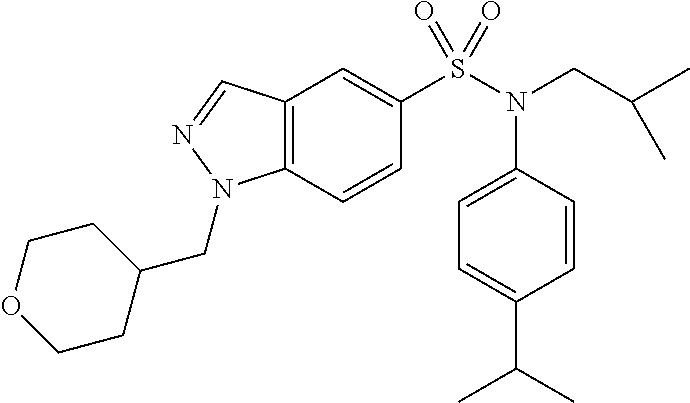
C00014

C00015
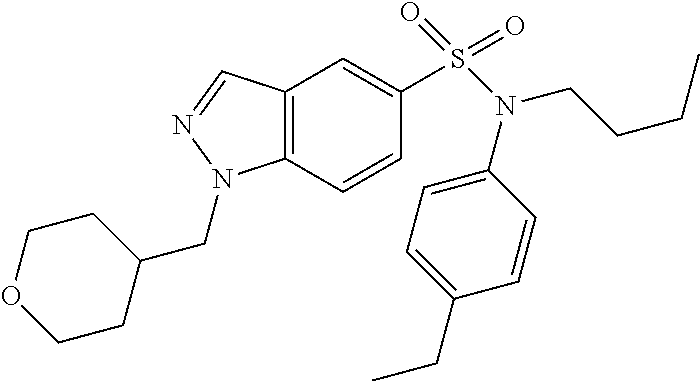
C00016
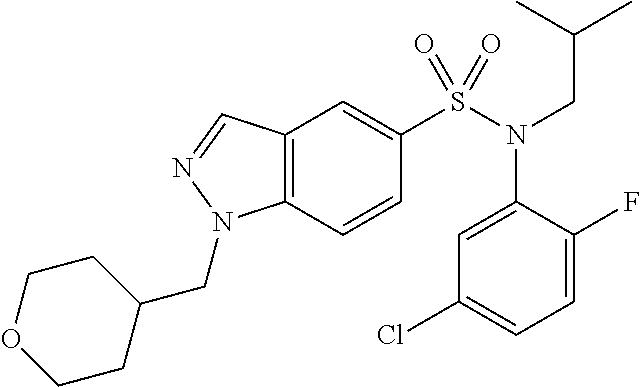
C00017

C00018
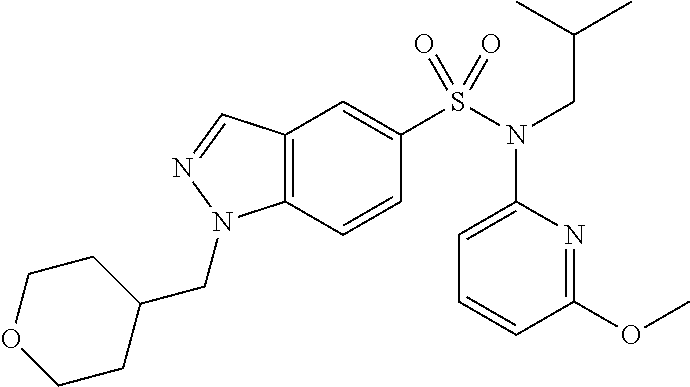
C00019

C00020

C00021

C00022

C00023

C00024
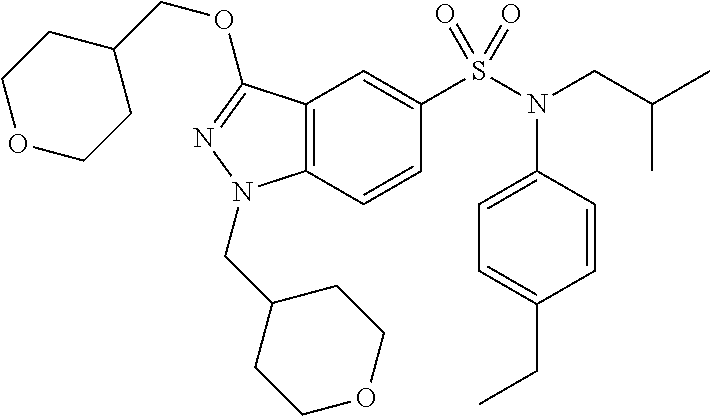
C00025

C00026
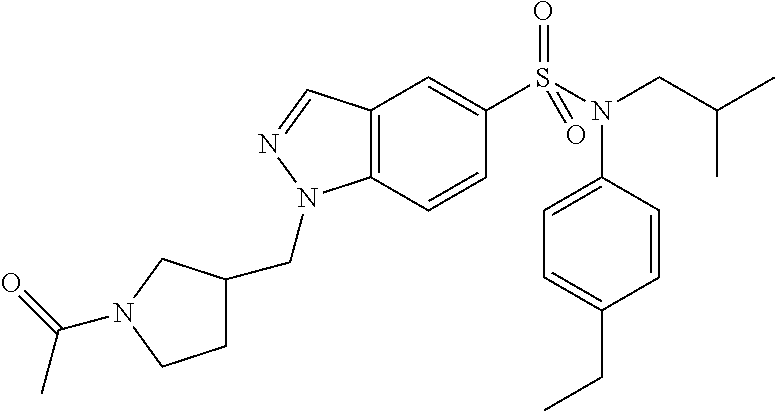
C00027

C00028

C00029

C00030
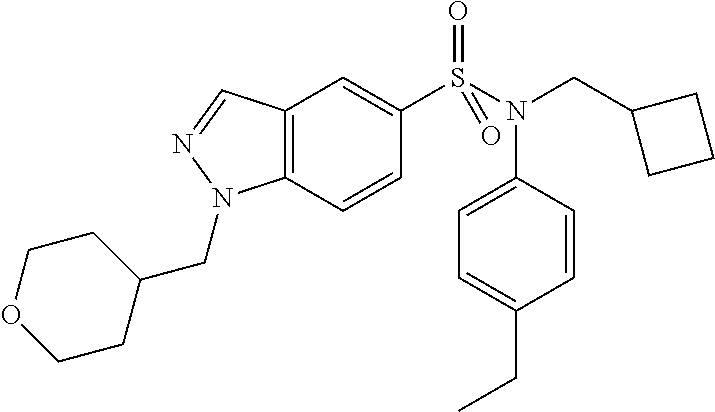
C00031

C00032

C00033

C00034

C00035

C00036

C00037
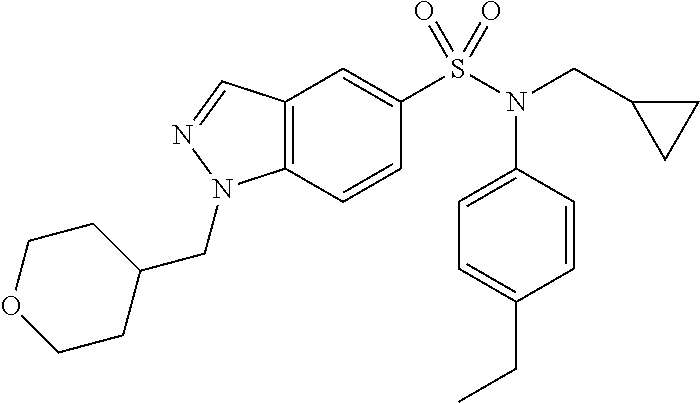
C00038

C00039
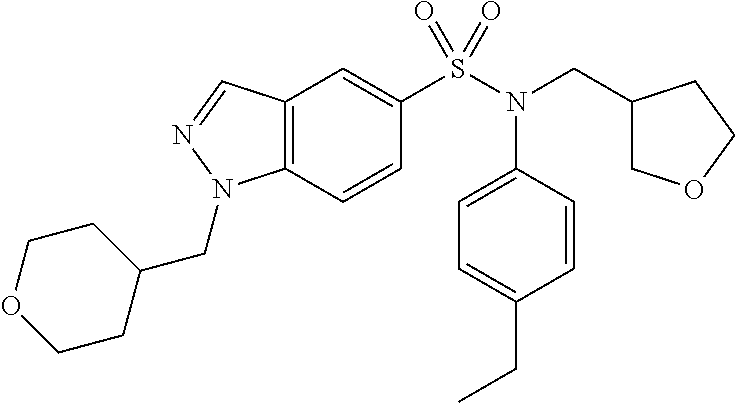
C00040

C00041

C00042

C00043

C00044
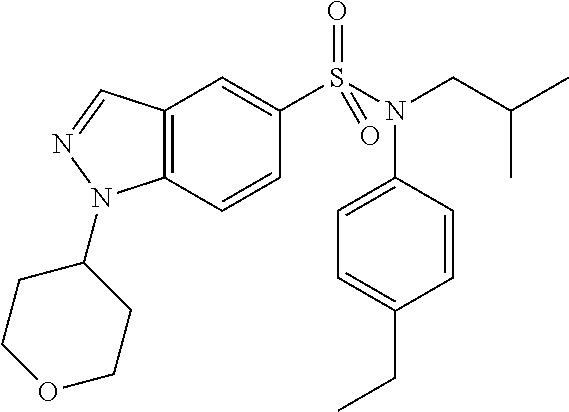
C00045
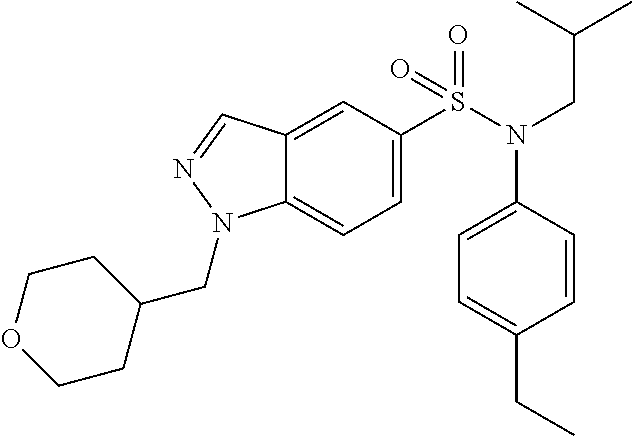
C00046
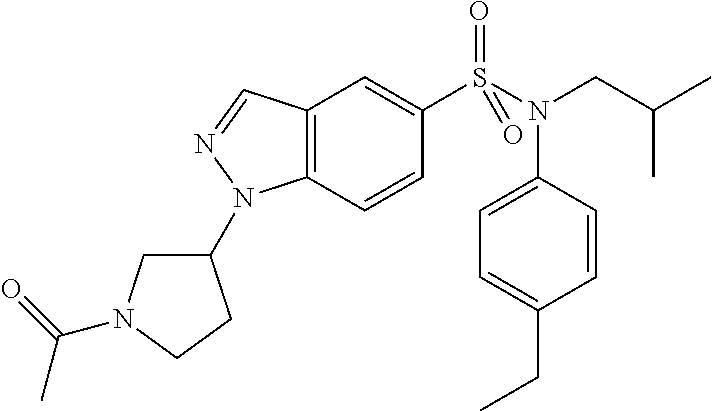
C00047
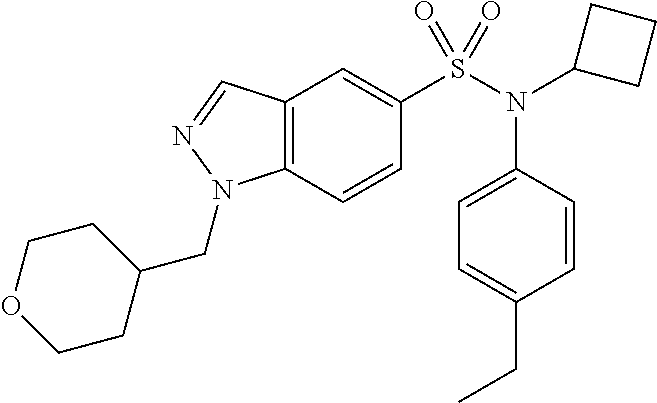
C00048

C00049
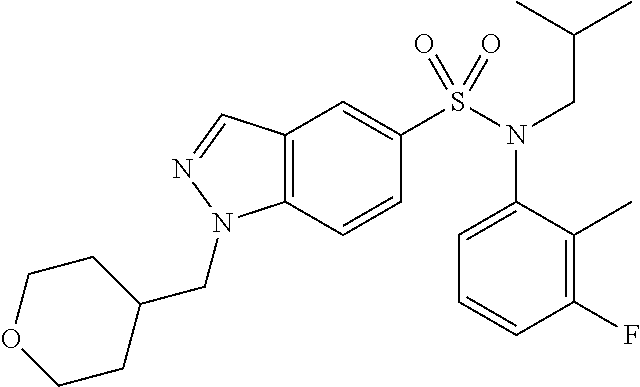
C00050

C00051

C00052
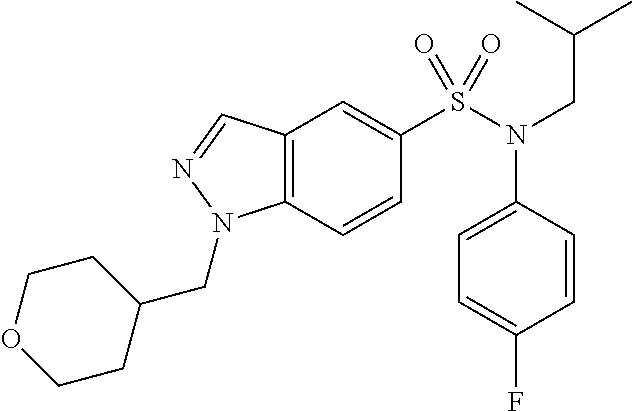
C00053

C00054
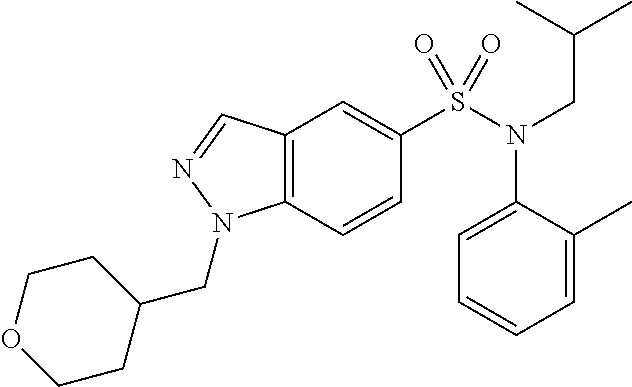
C00055

C00056

C00057

C00058
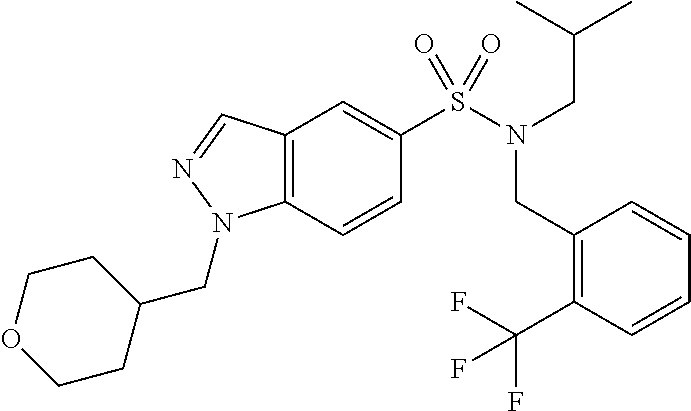
C00059
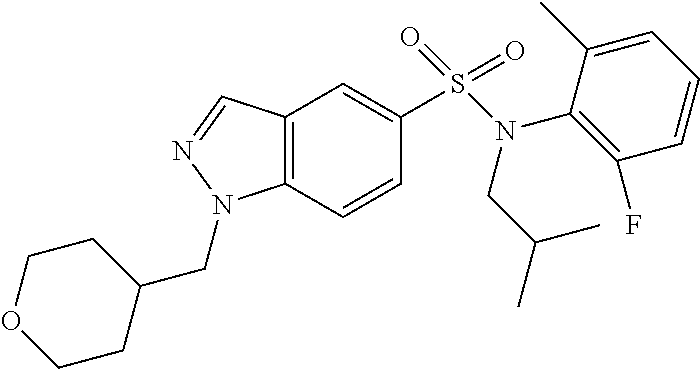
C00060

C00061
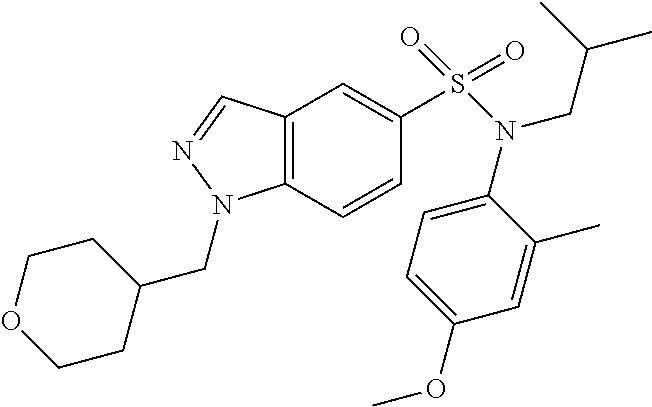
C00062

C00063

C00064

C00065
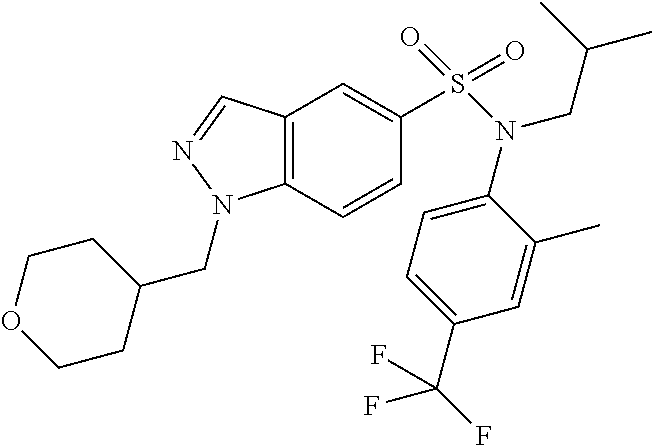
C00066

C00067

C00068

C00069

C00070

C00071
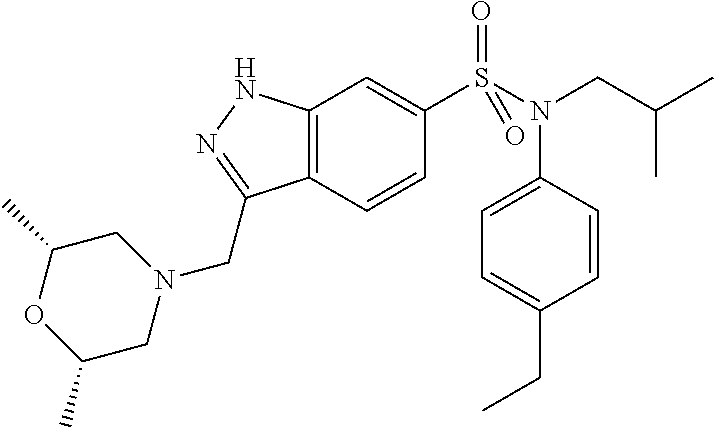
C00072

C00073
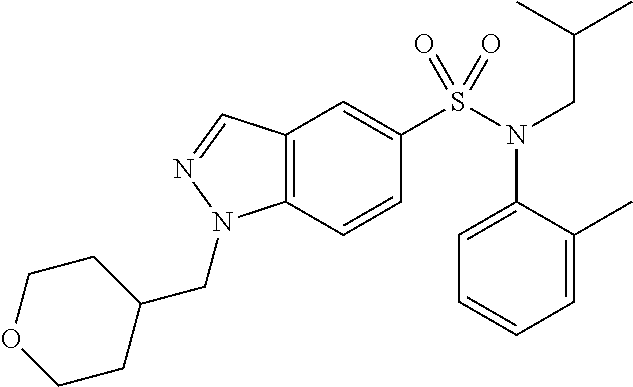
C00074
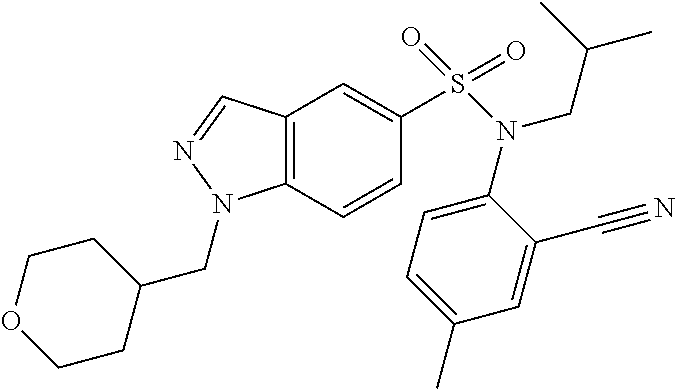
C00075

C00076

C00077
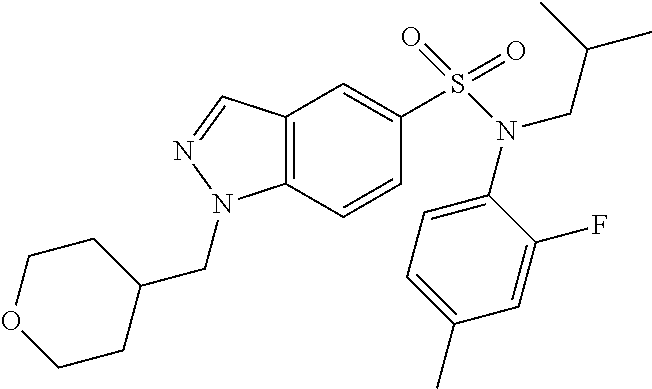
C00078
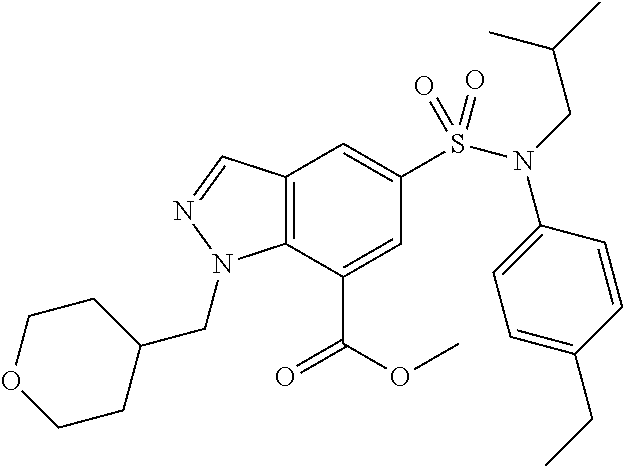
C00079
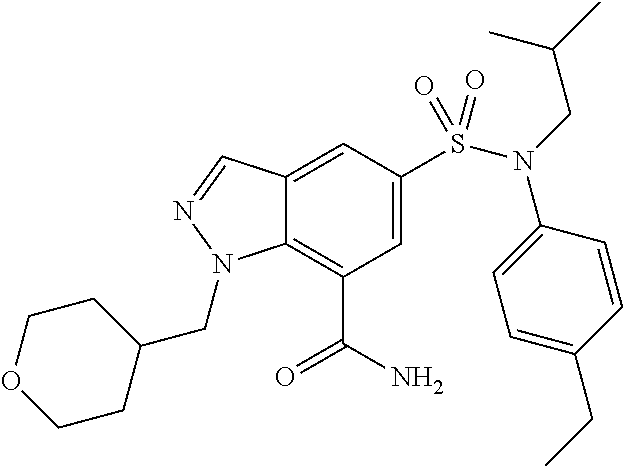
C00080

C00081
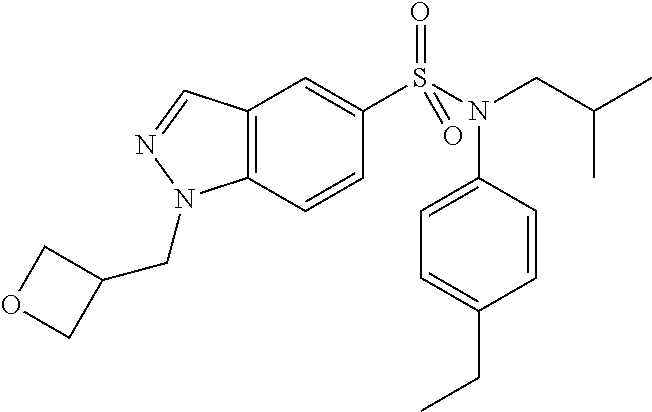
C00082
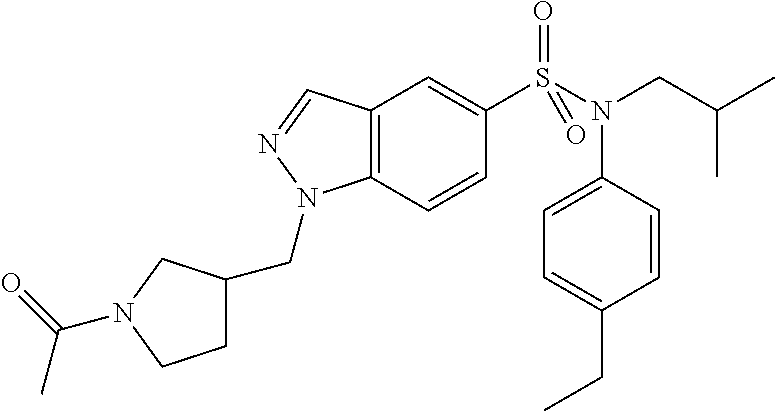
C00083
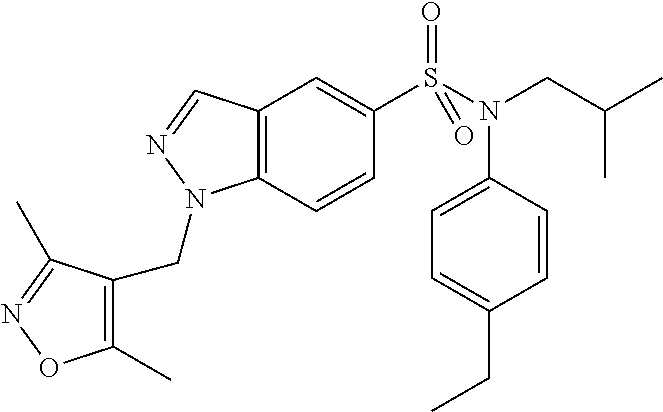
C00084

C00085

C00086

C00087

C00088

C00089

C00090
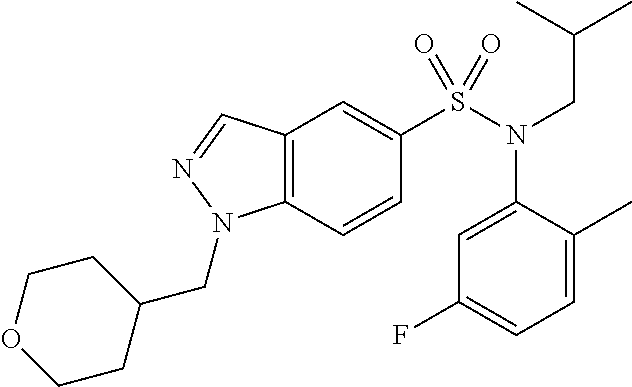
C00091

C00092
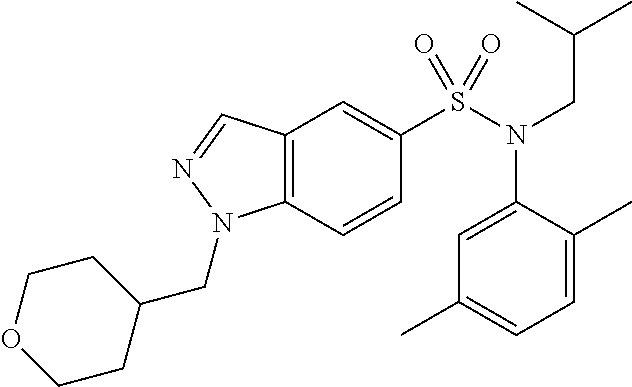
C00093

C00094
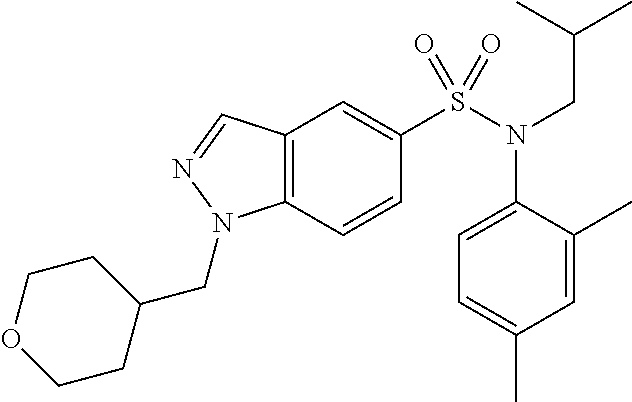
C00095

C00096
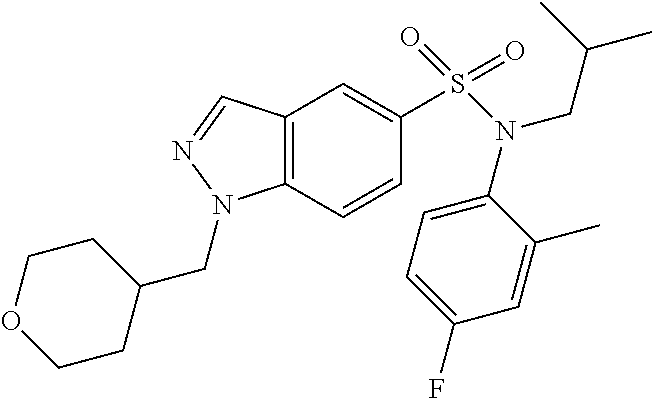
C00097

C00098
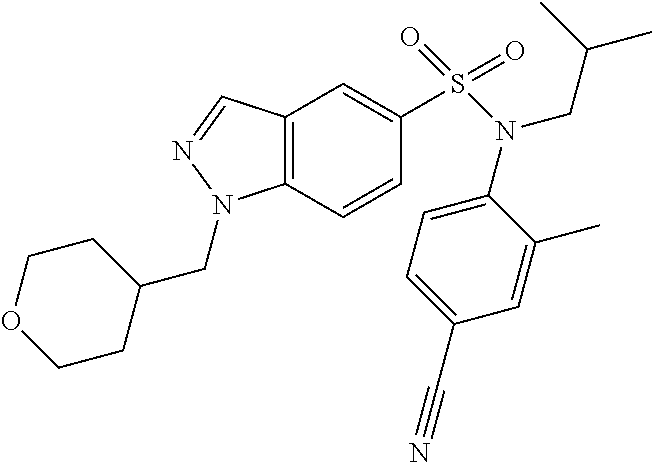
C00099

C00100

C00101
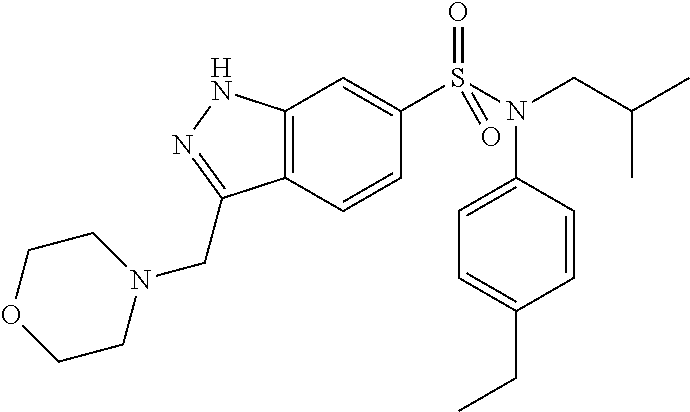
C00102

C00103
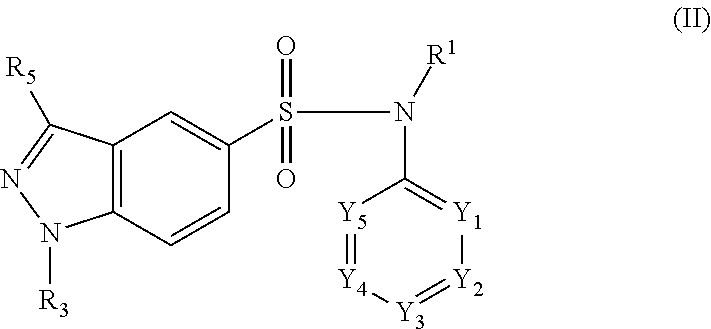
C00104
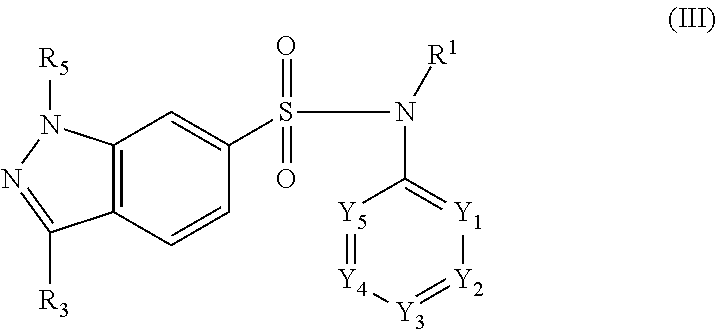
C00105

C00106

C00107

C00108

C00109
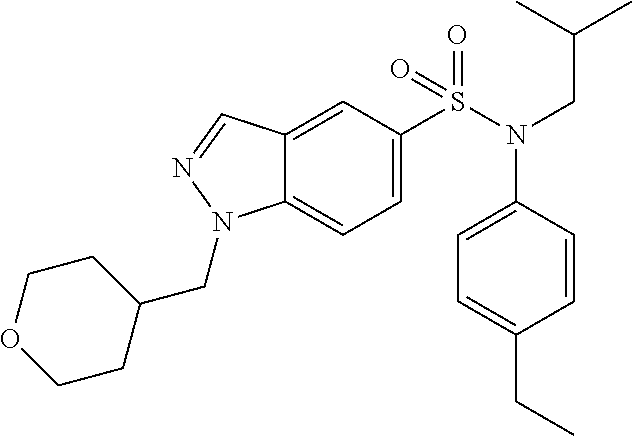
C00110

C00111

C00112
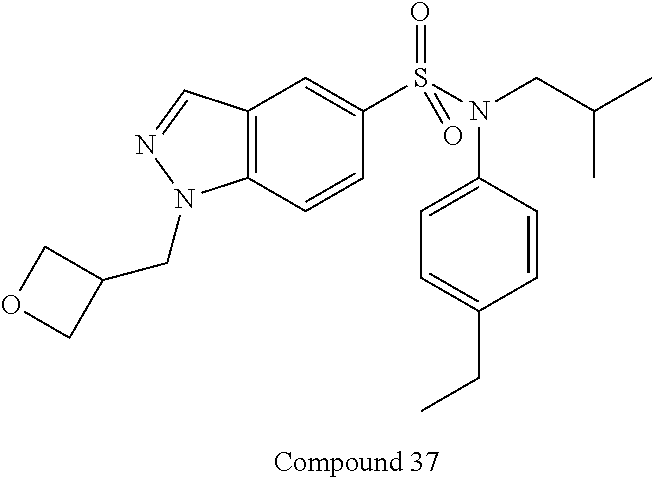
C00113

C00114

C00115

C00116

C00117
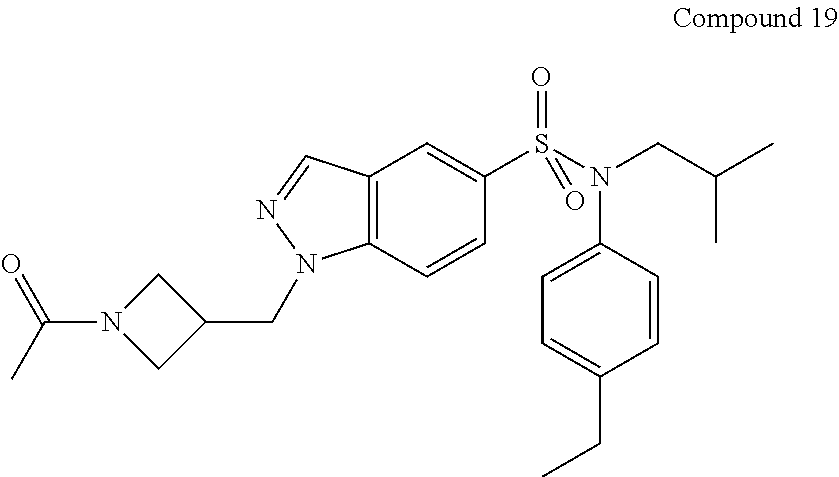
C00118
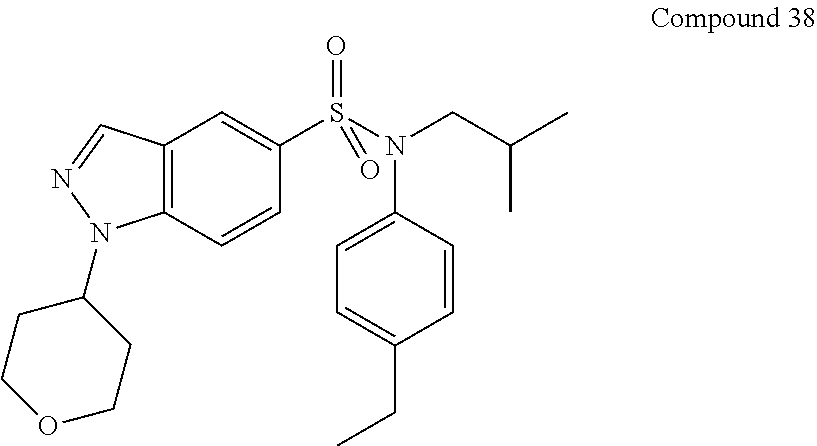
C00119

C00120

C00121
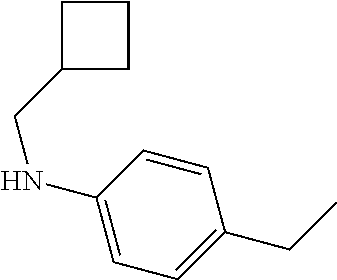
C00122
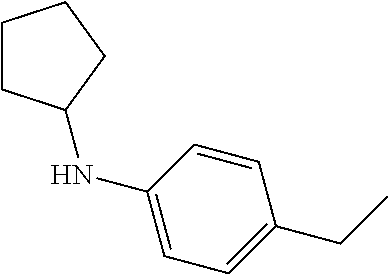
C00123

C00124

C00125
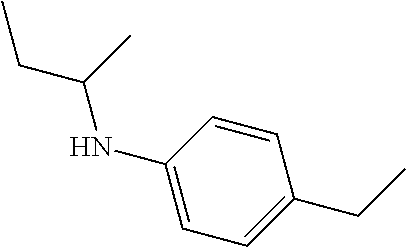
C00126

C00127
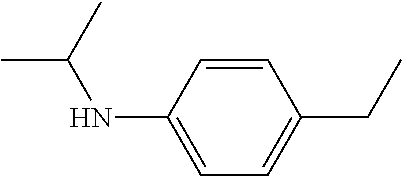
C00128

C00129

C00130

C00131
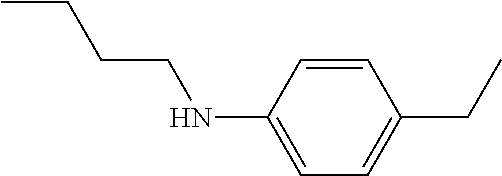
C00132
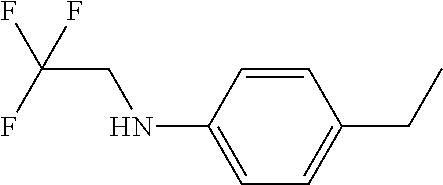
C00133
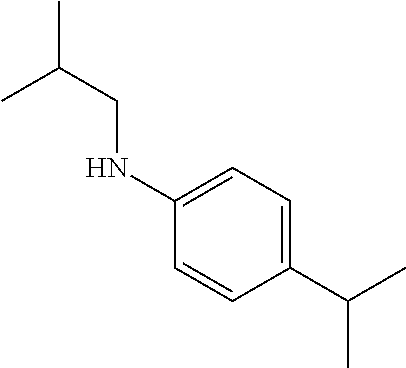
C00134

C00135

C00136

C00137

C00138

C00139
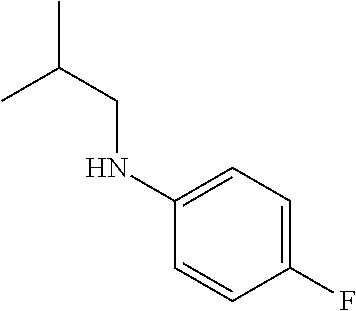
C00140
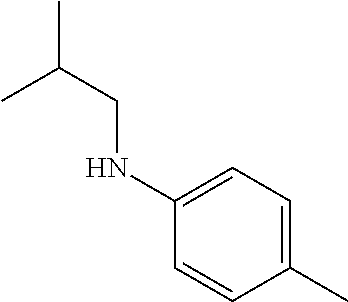
C00141
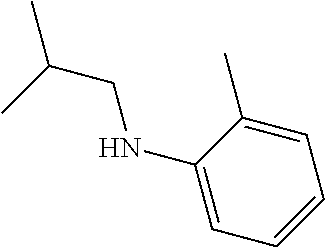
C00142
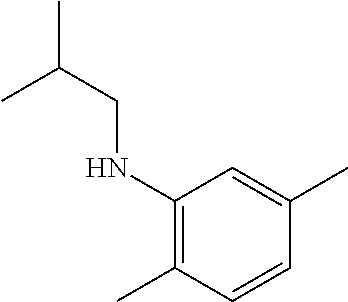
C00143
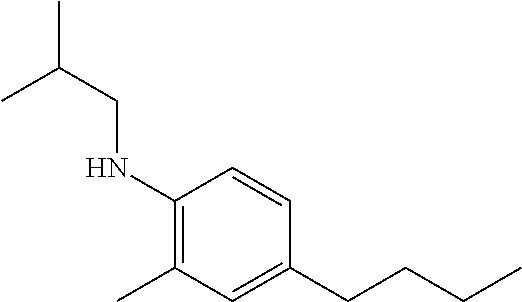
C00144

C00145
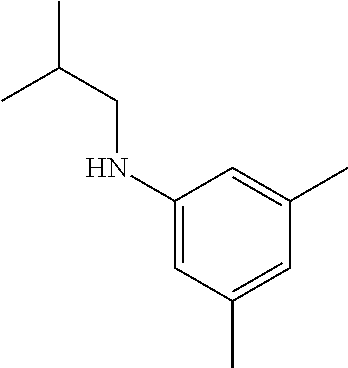
C00146

C00147

C00148
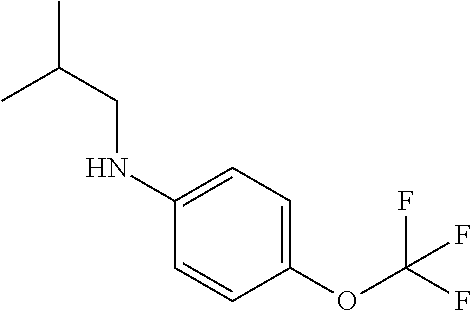
C00149

C00150

C00151
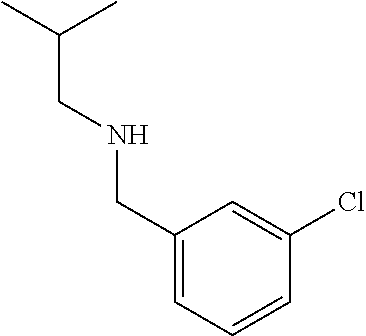
C00152
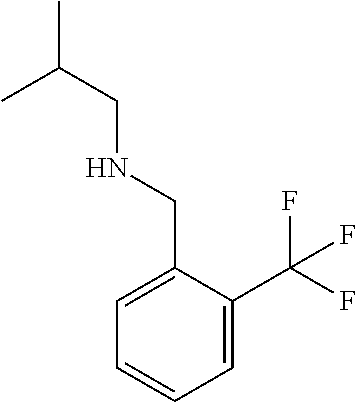
C00153
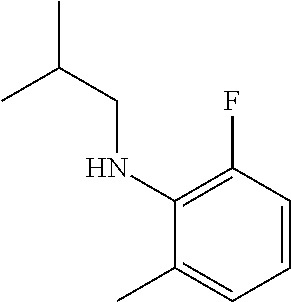
C00154

C00155
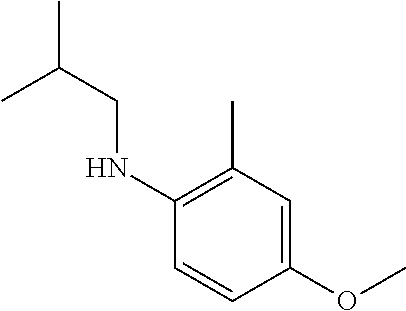
C00156

C00157

C00158
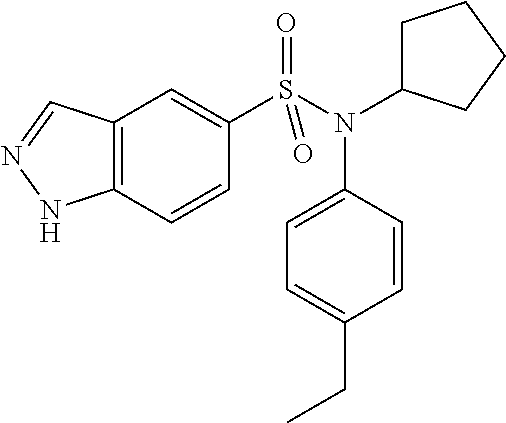
C00159
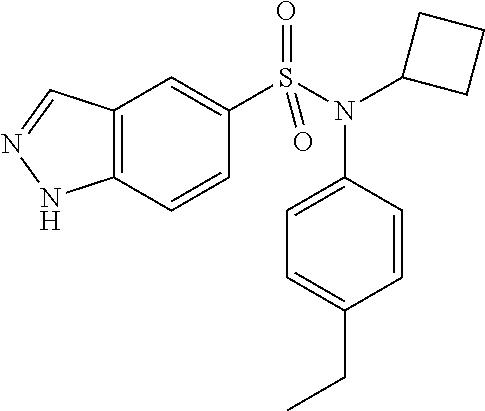
C00160

C00161
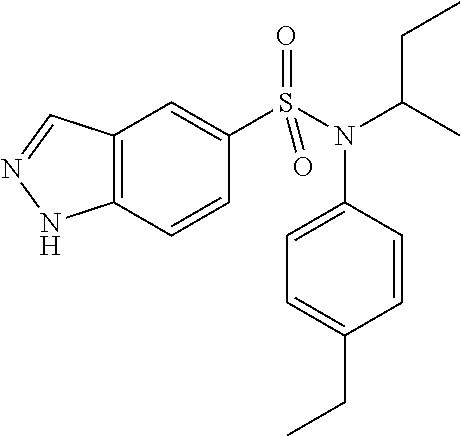
C00162

C00163
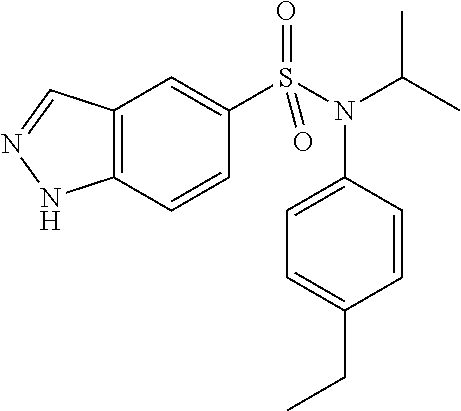
C00164
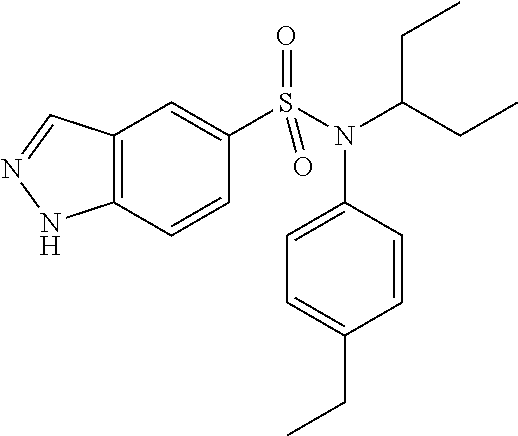
C00165
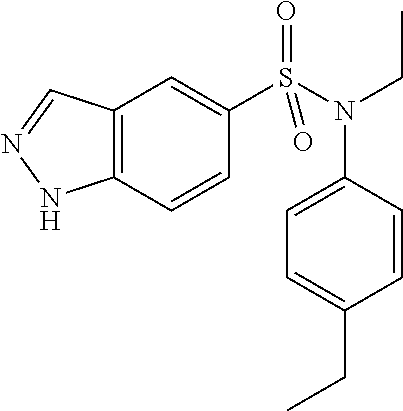
C00166
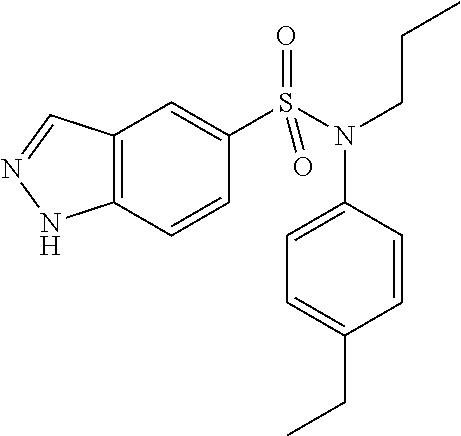
C00167
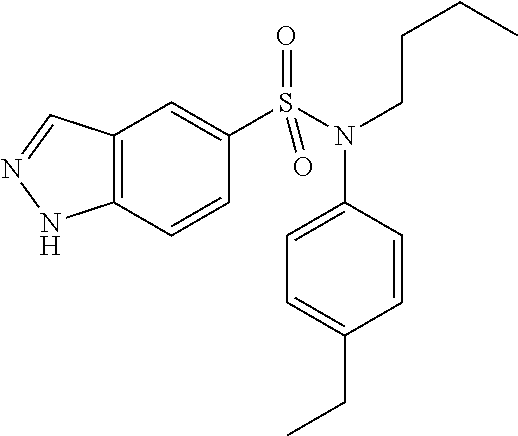
C00168
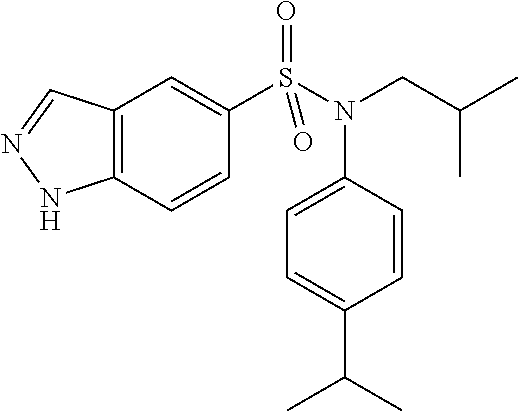
C00169

C00170
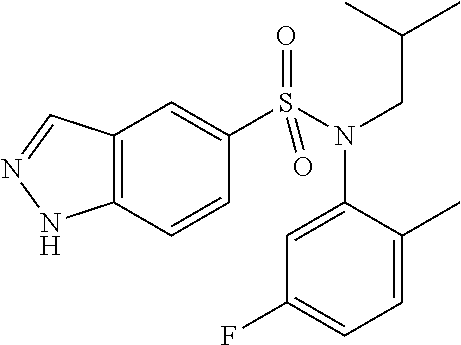
C00171

C00172
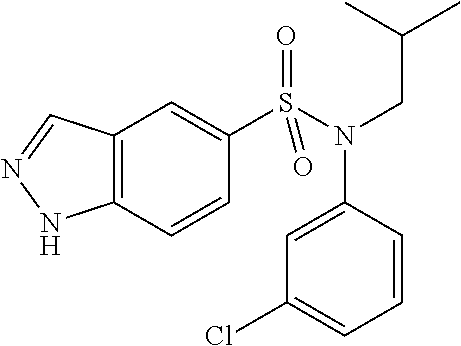
C00173

C00174
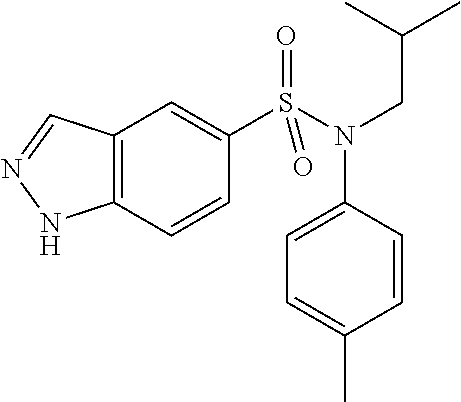
C00175
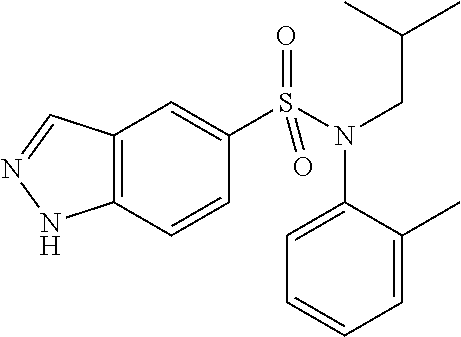
C00176

C00177

C00178

C00179

C00180
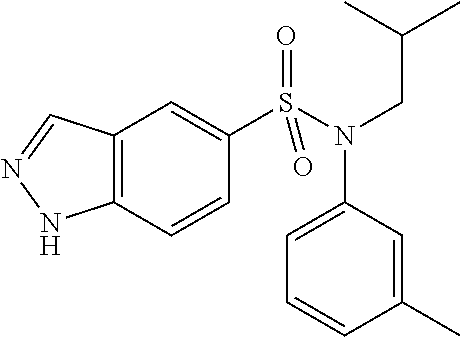
C00181

C00182
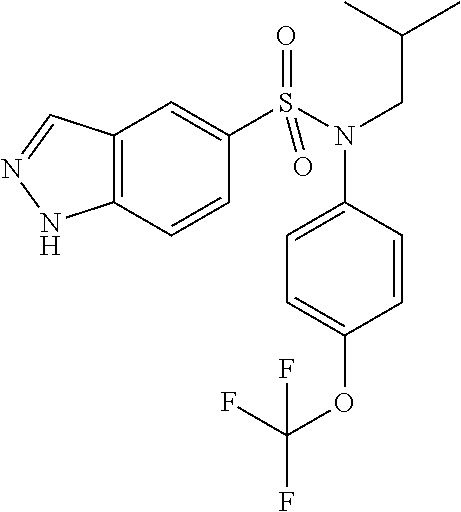
C00183

C00184

C00185

C00186

C00187
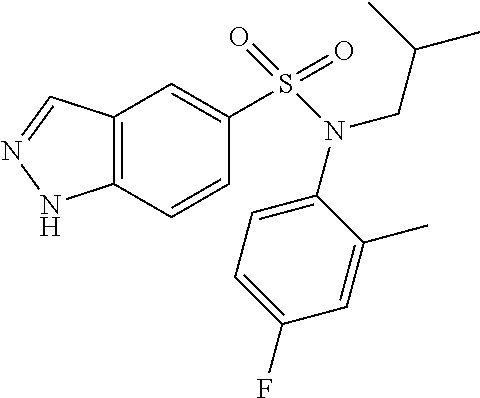
C00188

C00189

C00190

C00191

C00192
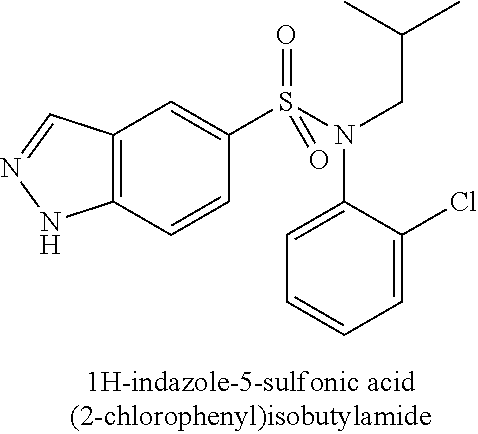
C00193

C00194

C00195

C00196
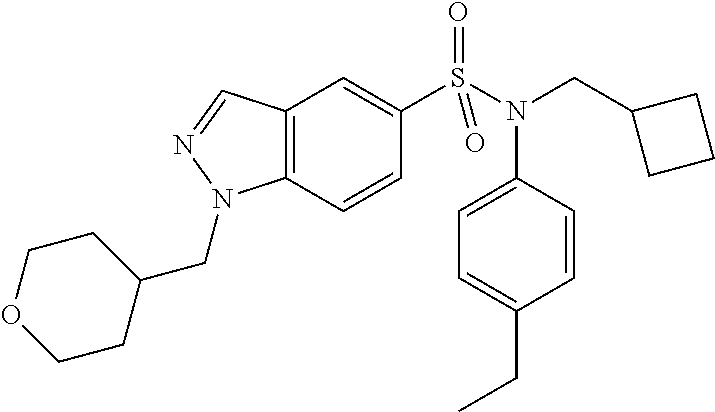
C00197
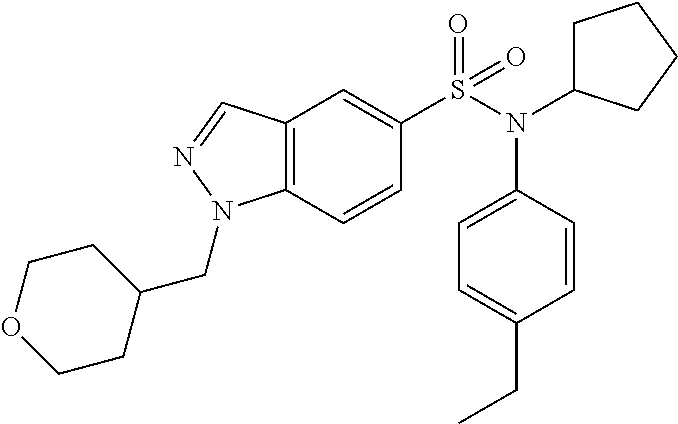
C00198

C00199

C00200

C00201
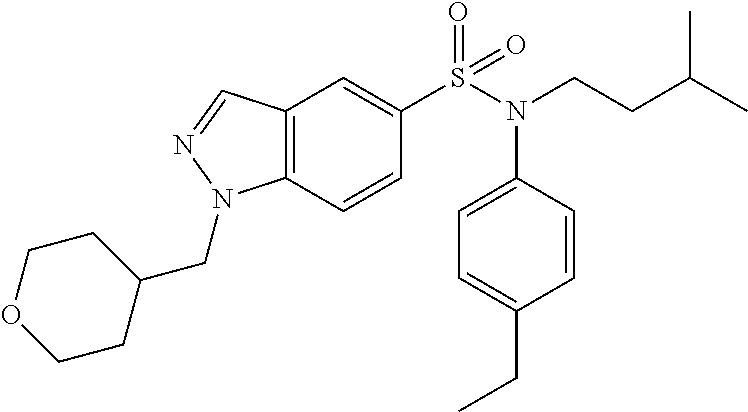
C00202

C00203

C00204

C00205
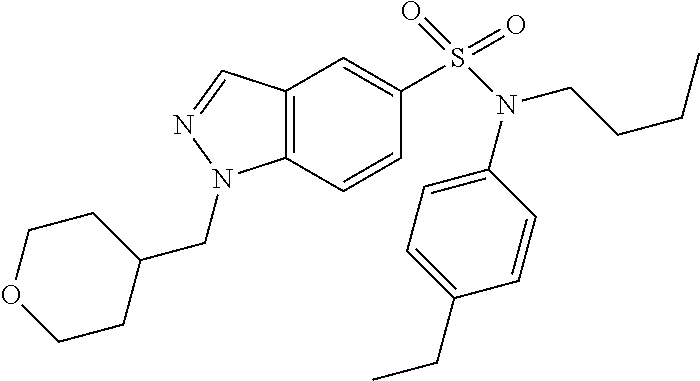
C00206
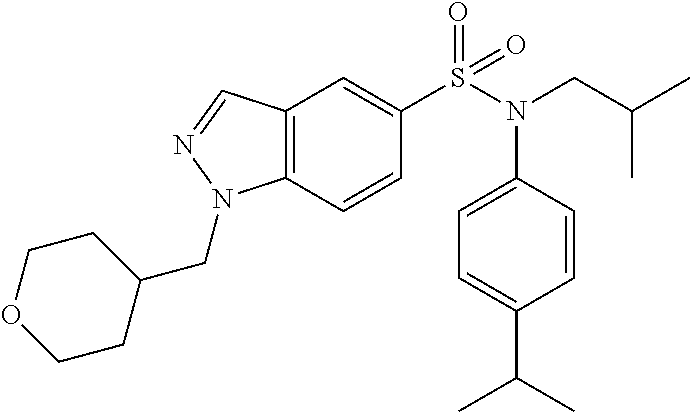
C00207
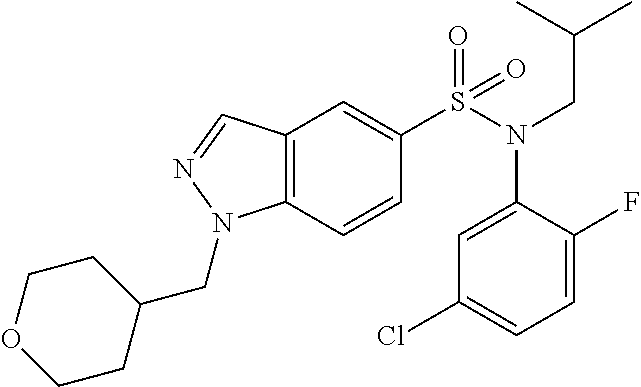
C00208

C00209

C00210

C00211

C00212
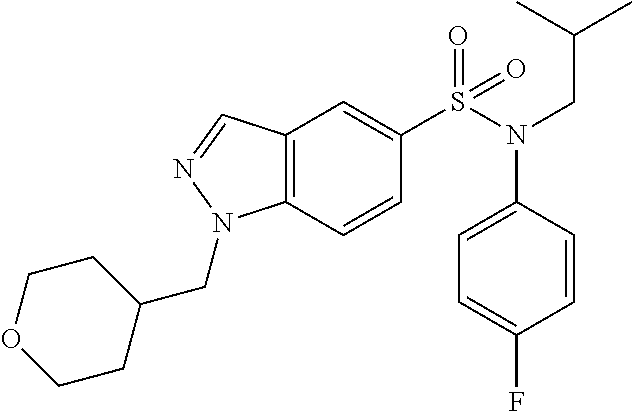
C00213

C00214

C00215
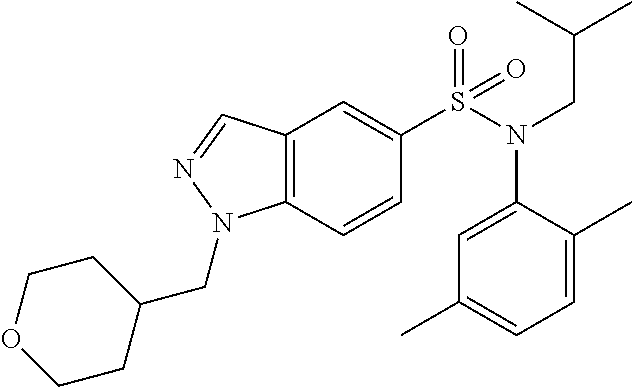
C00216
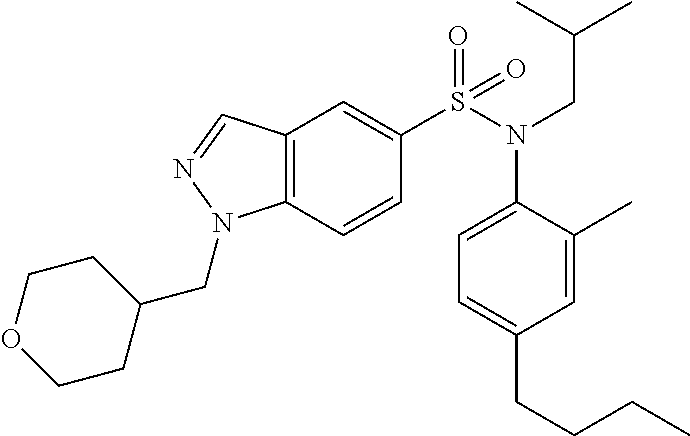
C00217
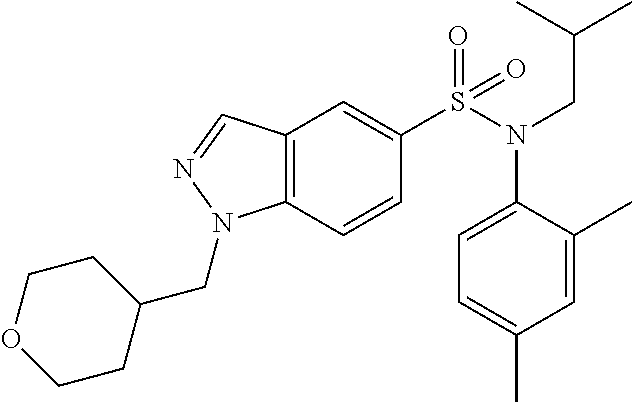
C00218
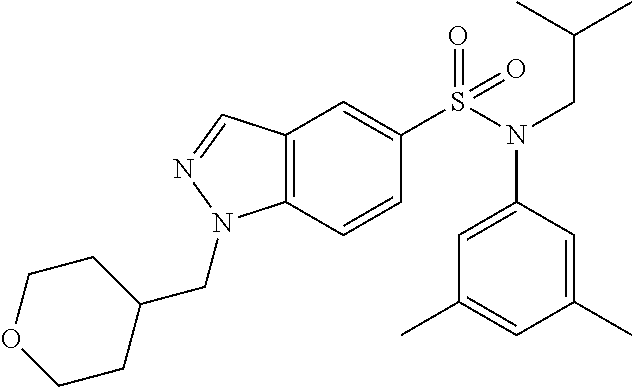
C00219
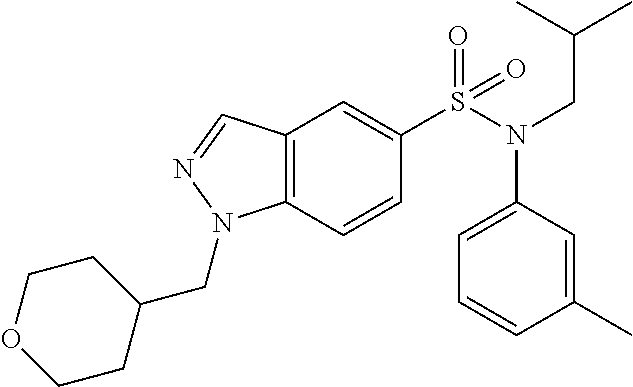
C00220
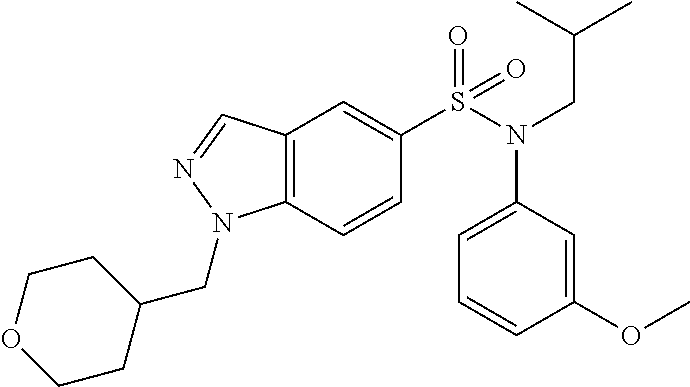
C00221

C00222
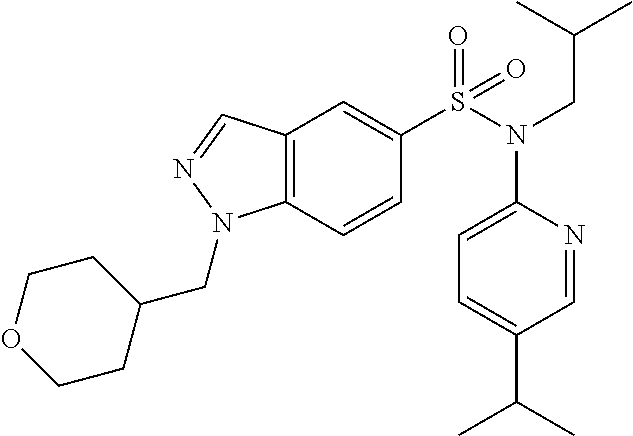
C00223
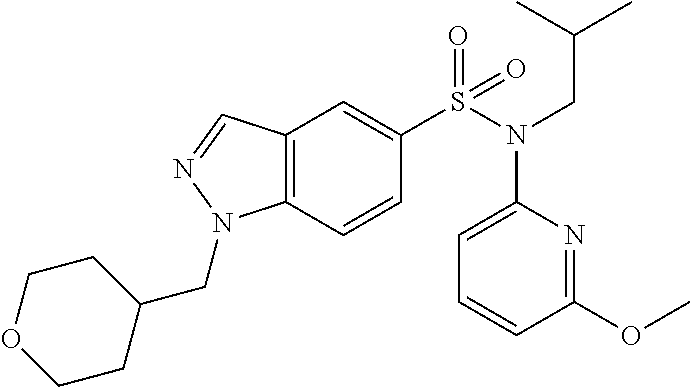
C00224

C00225
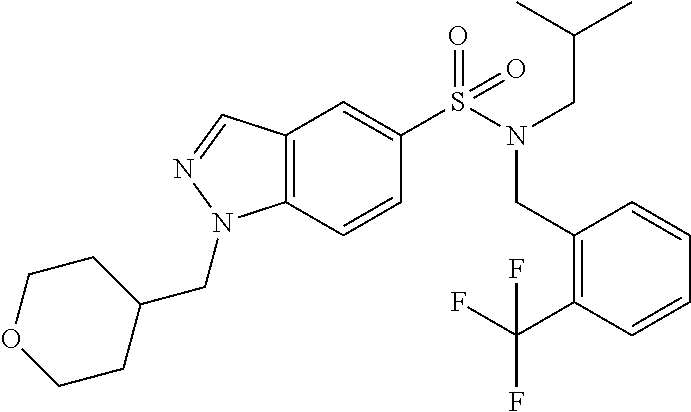
C00226
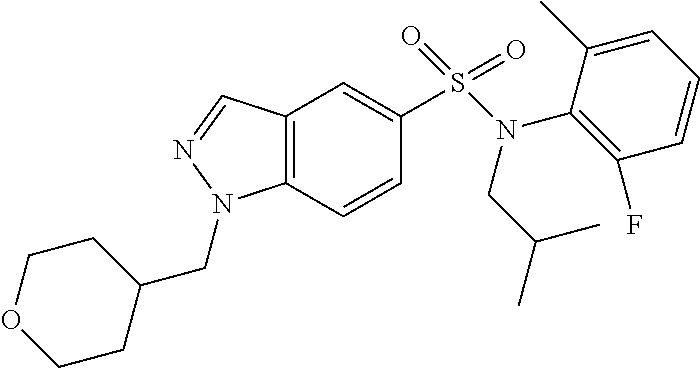
C00227
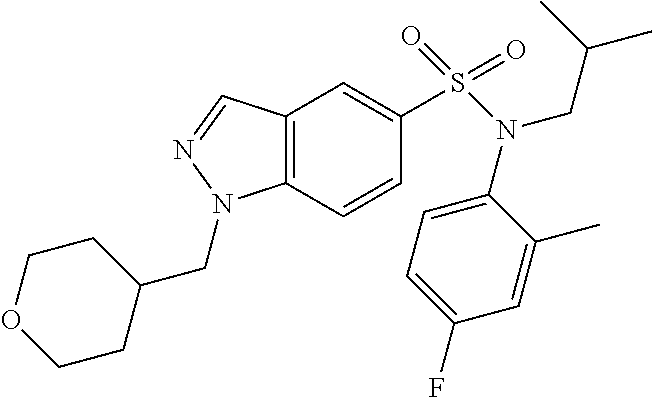
C00228

C00229
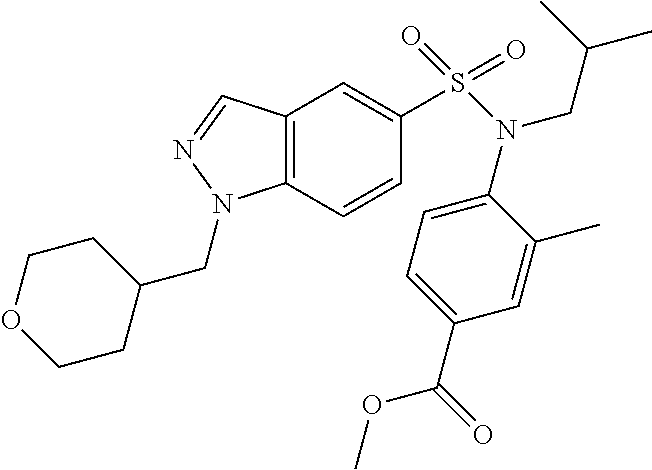
C00230

C00231
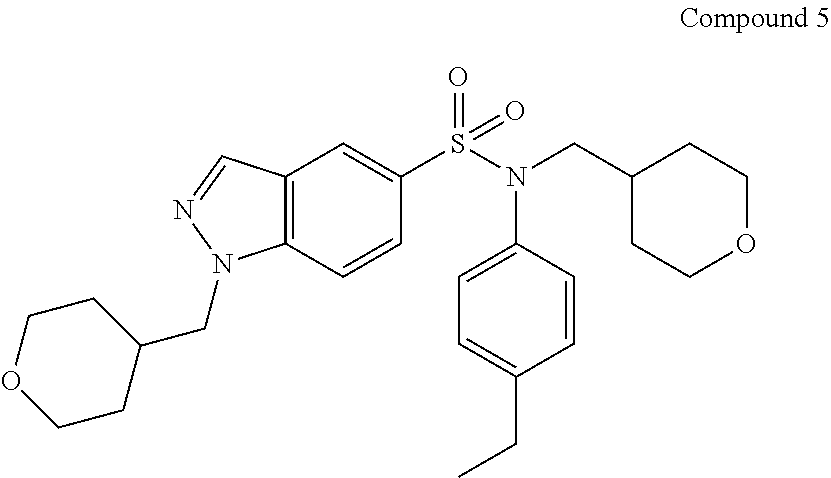
C00232

C00233

C00234
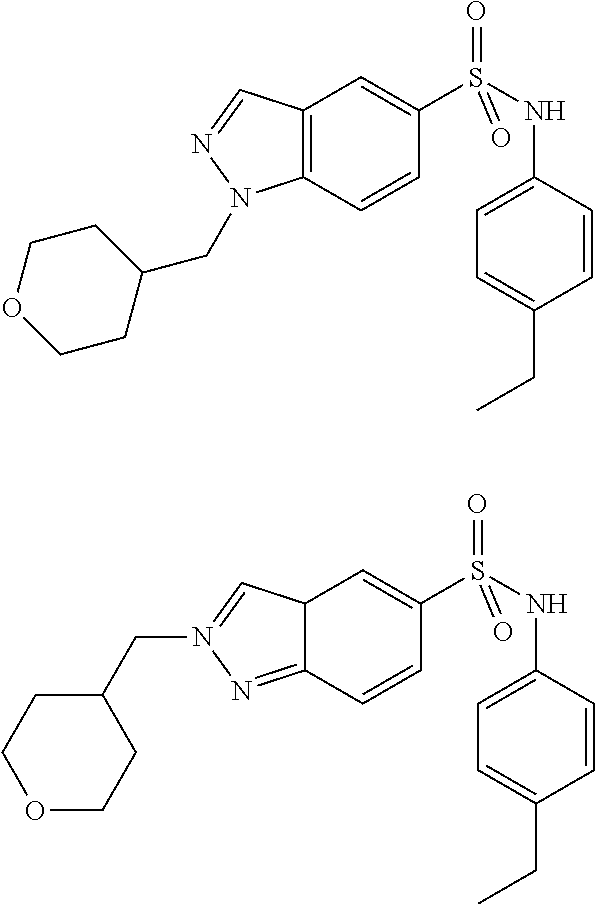
C00235
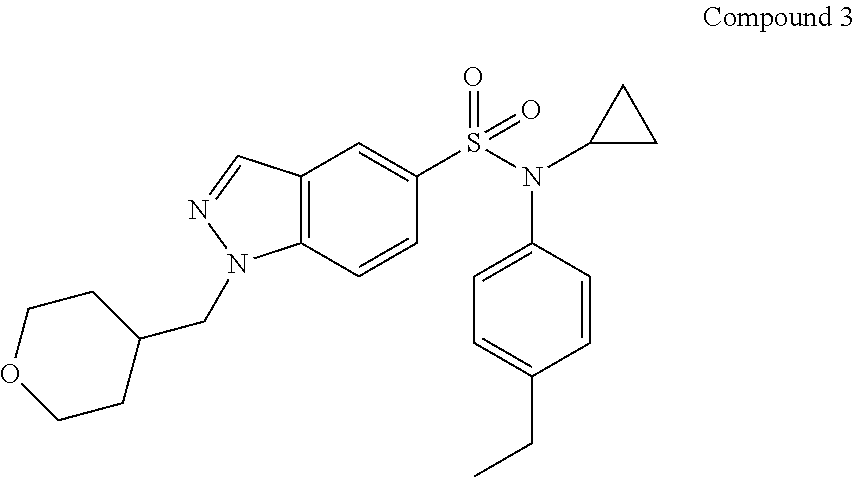
C00236

C00237

C00238

C00239
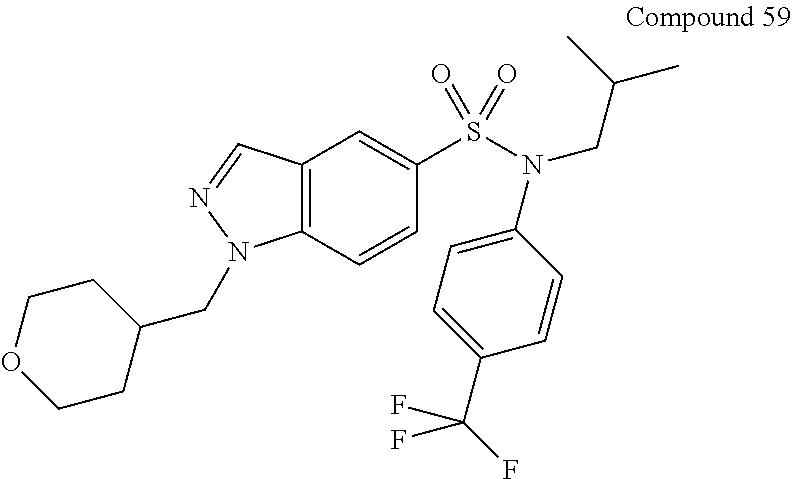
C00240
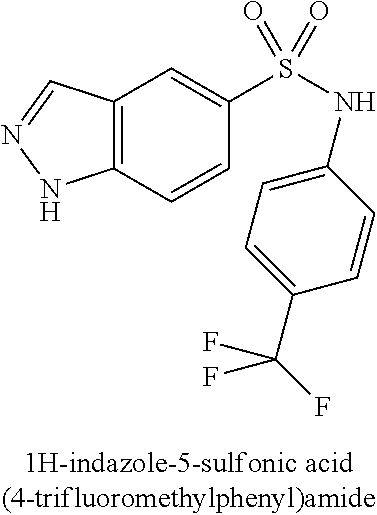
C00241

C00242

C00243

C00244

C00245

C00246
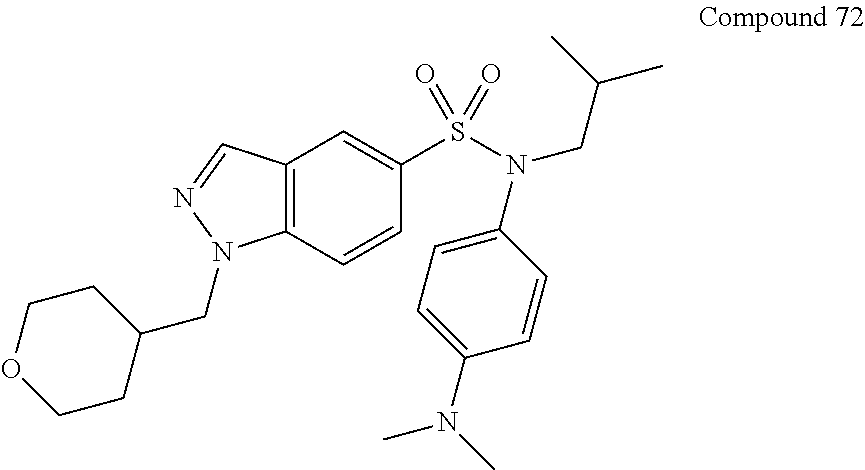
C00247

C00248

C00249
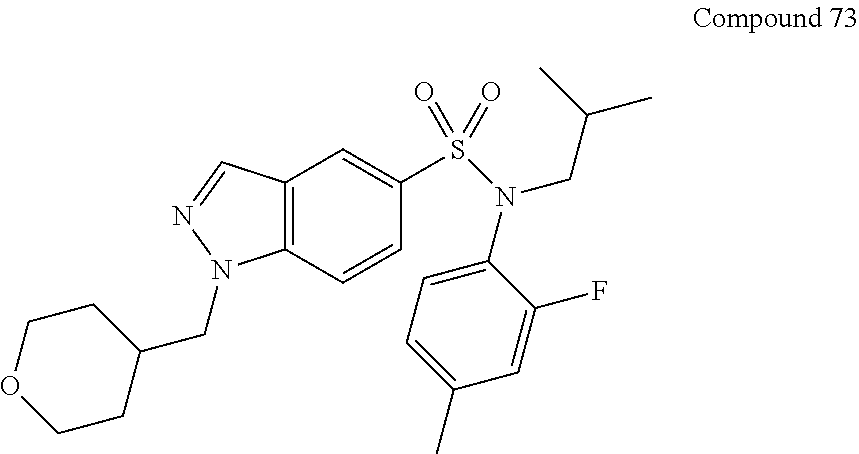
C00250
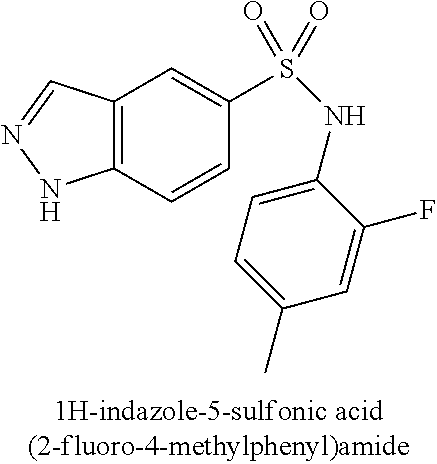
C00251

C00252

C00253

C00254

C00255
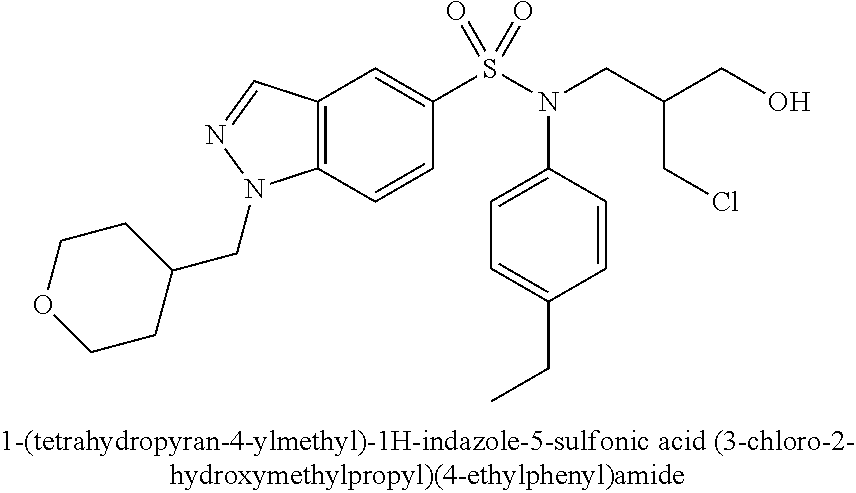
C00256

C00257

C00258
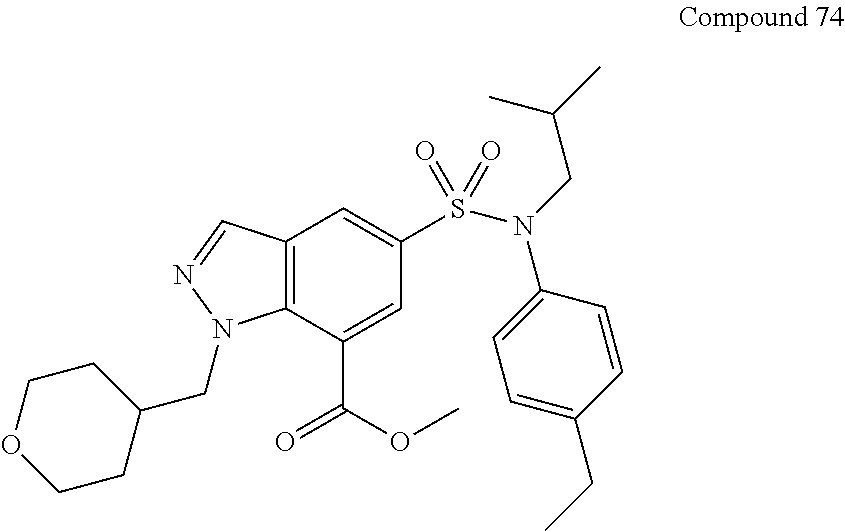
C00259
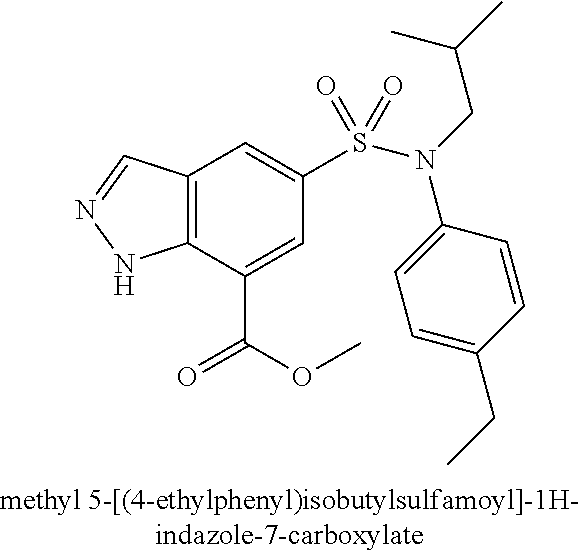
C00260
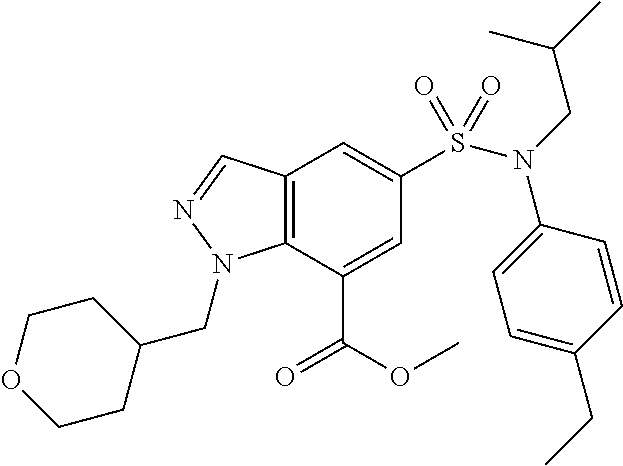
C00261

C00262

C00263
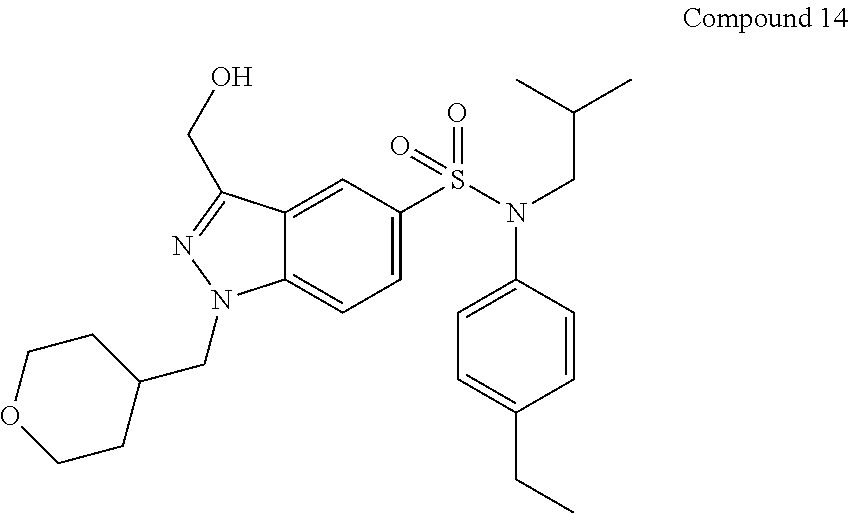
C00264

C00265
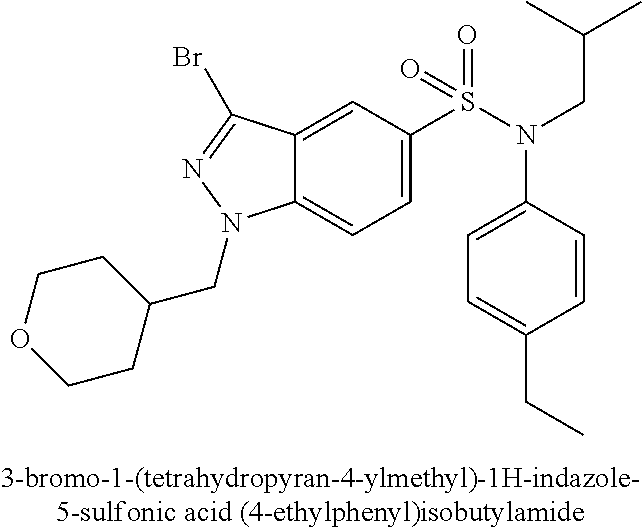
C00266
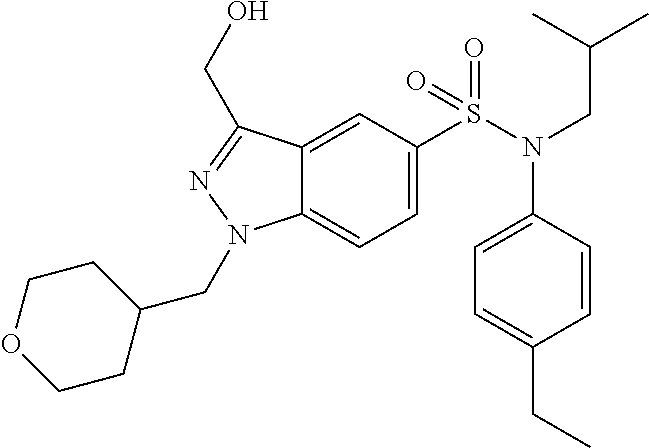
C00267

C00268

C00269

C00270
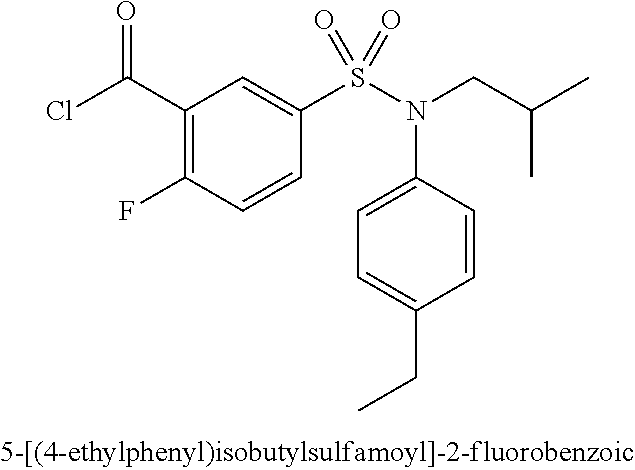
C00271

C00272
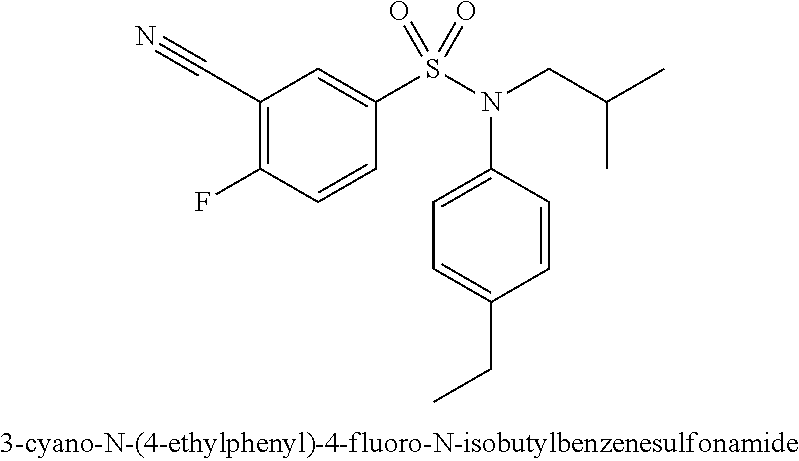
C00273

C00274
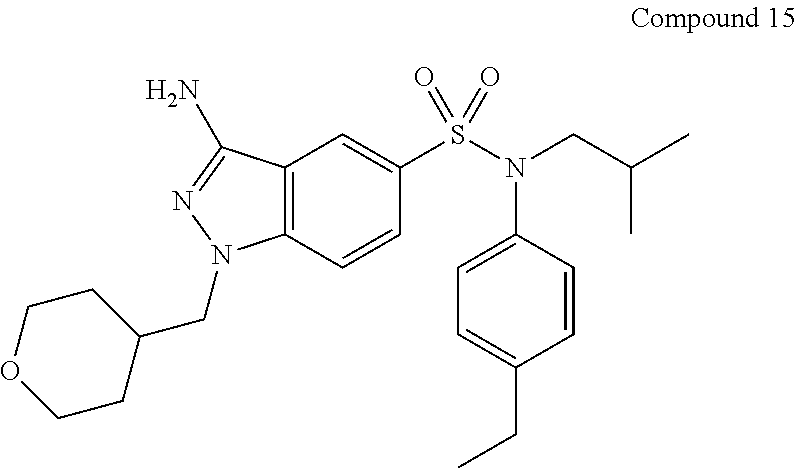
C00275
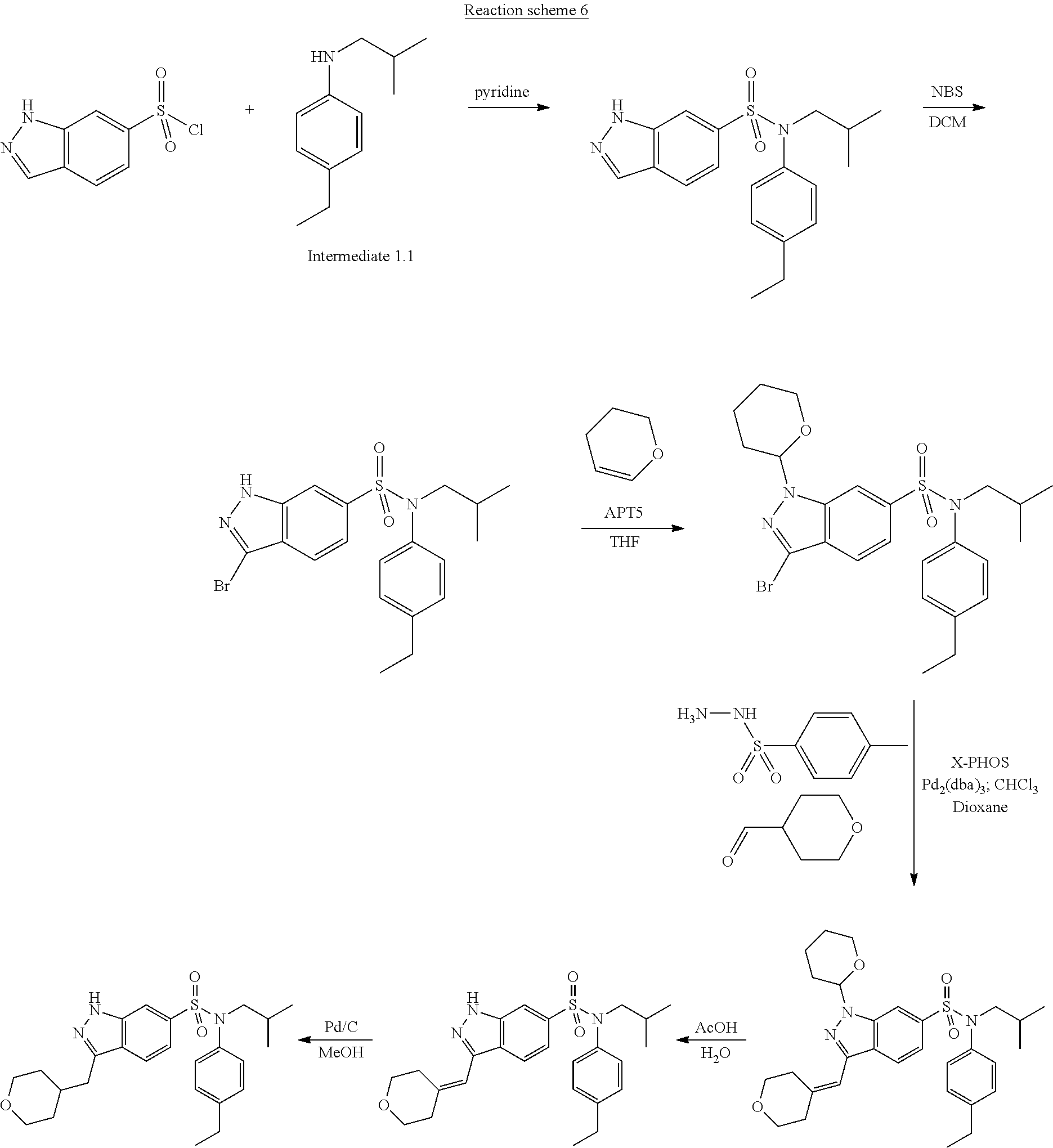
C00276

C00277
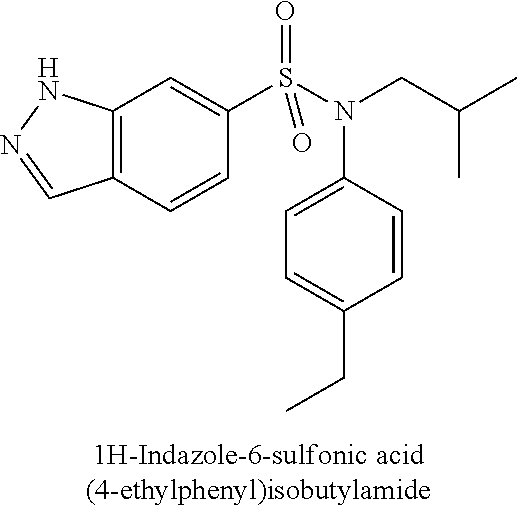
C00278

C00279
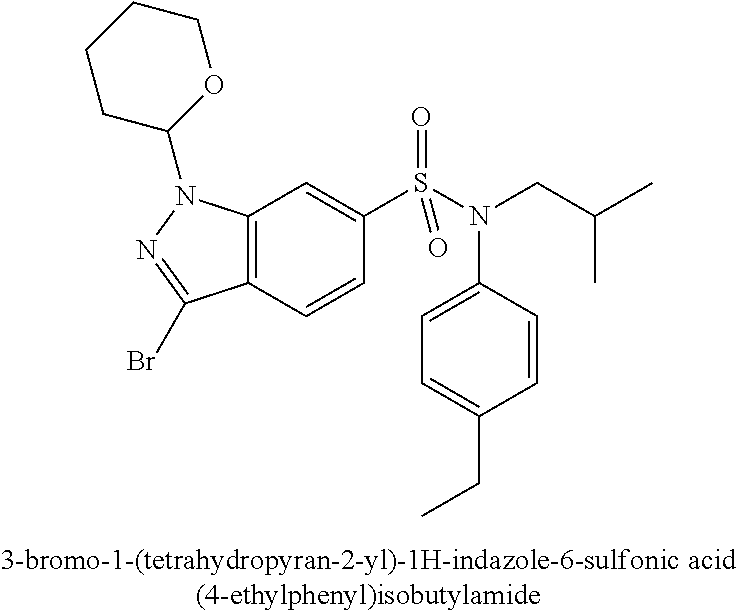
C00280
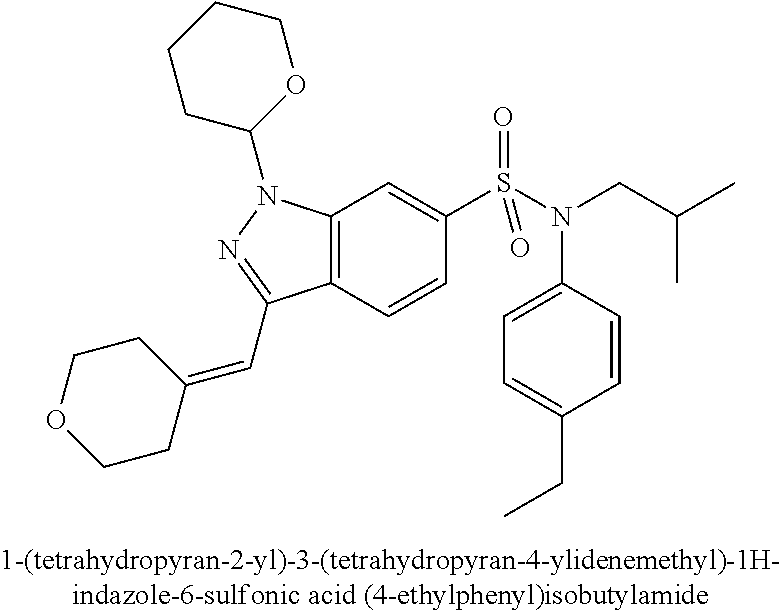
C00281
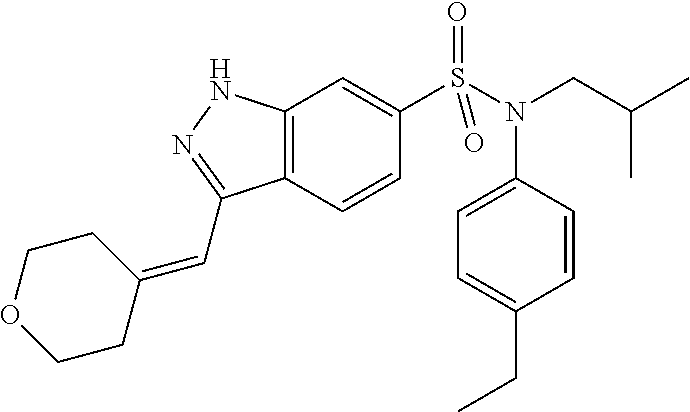
C00282
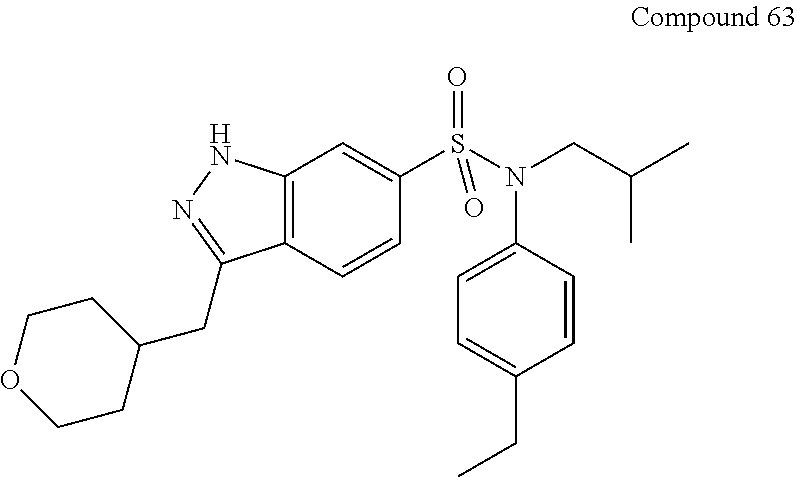
C00283

C00284

C00285

C00286
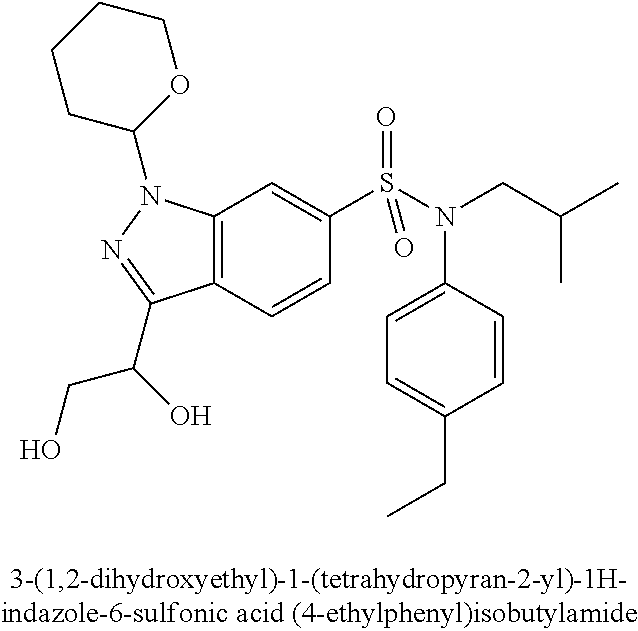
C00287

C00288
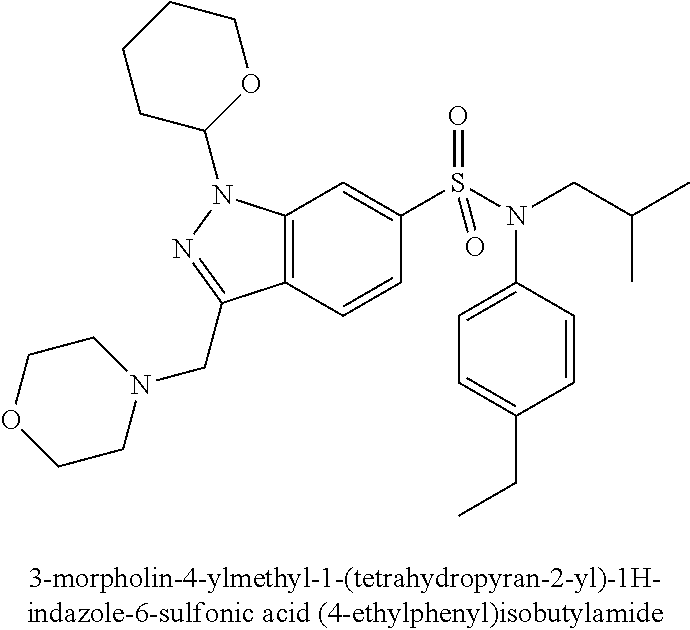
C00289
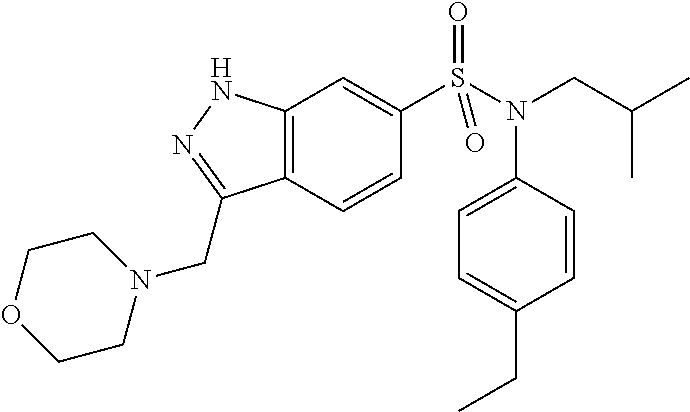
C00290

C00291

C00292
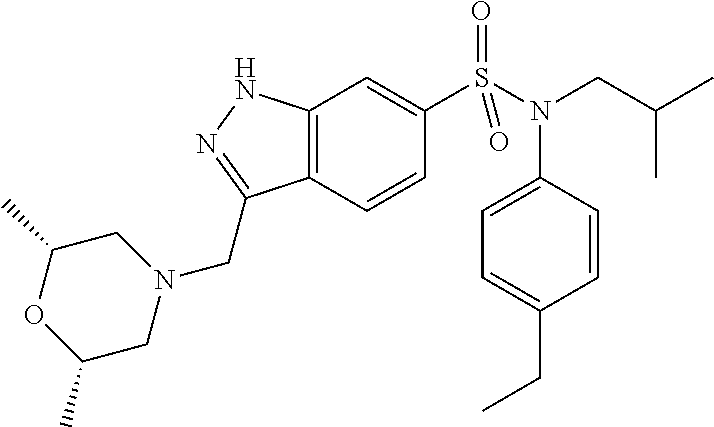
C00293
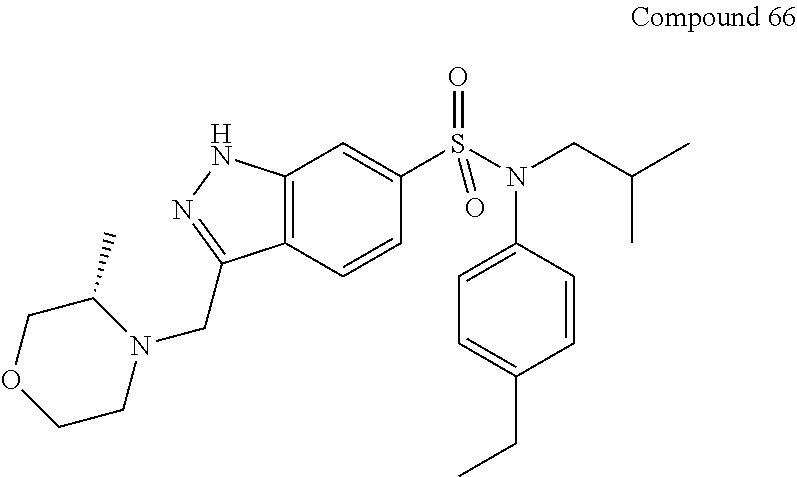
C00294
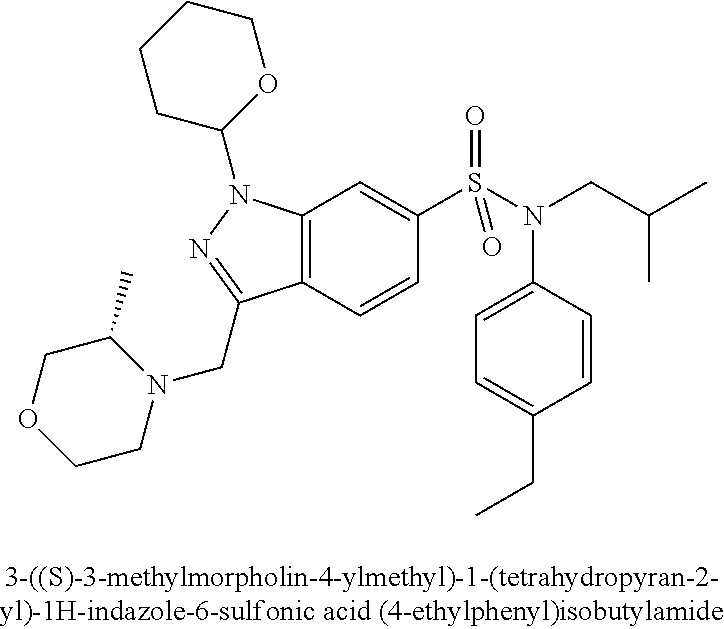
C00295

C00296
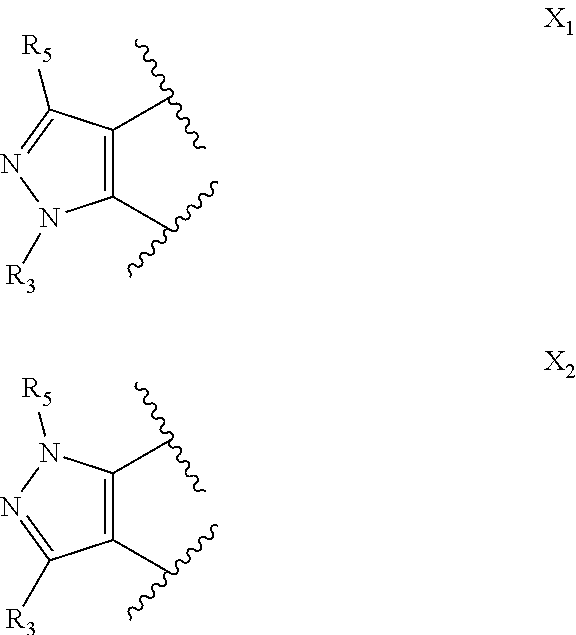
C00297

C00298

C00299

C00300

C00301

C00302

C00303

C00304

C00305

C00306

C00307

C00308

C00309
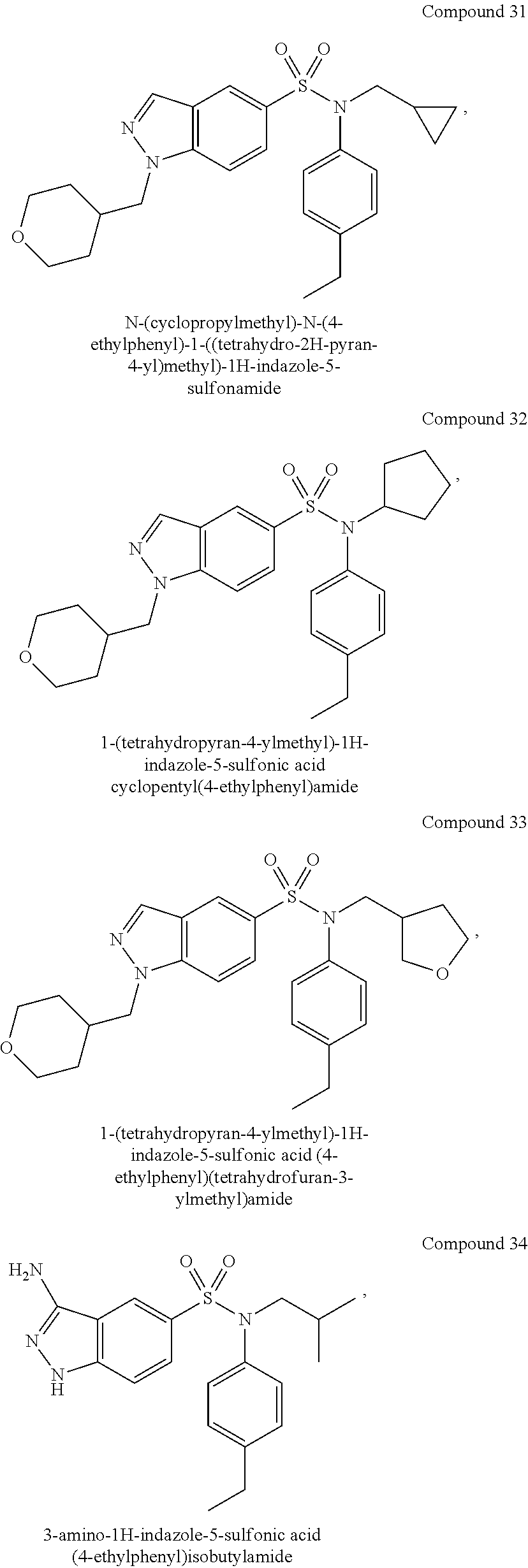
C00310

C00311

C00312

C00313
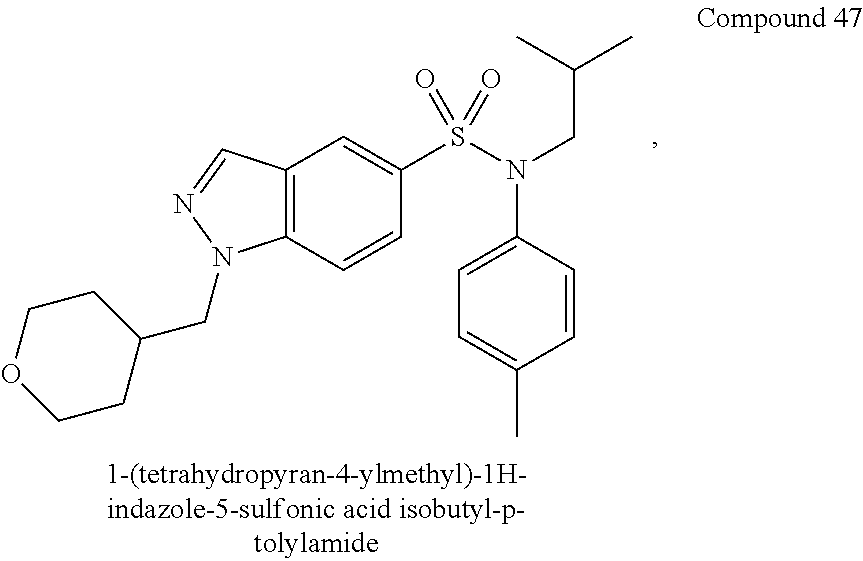
C00314
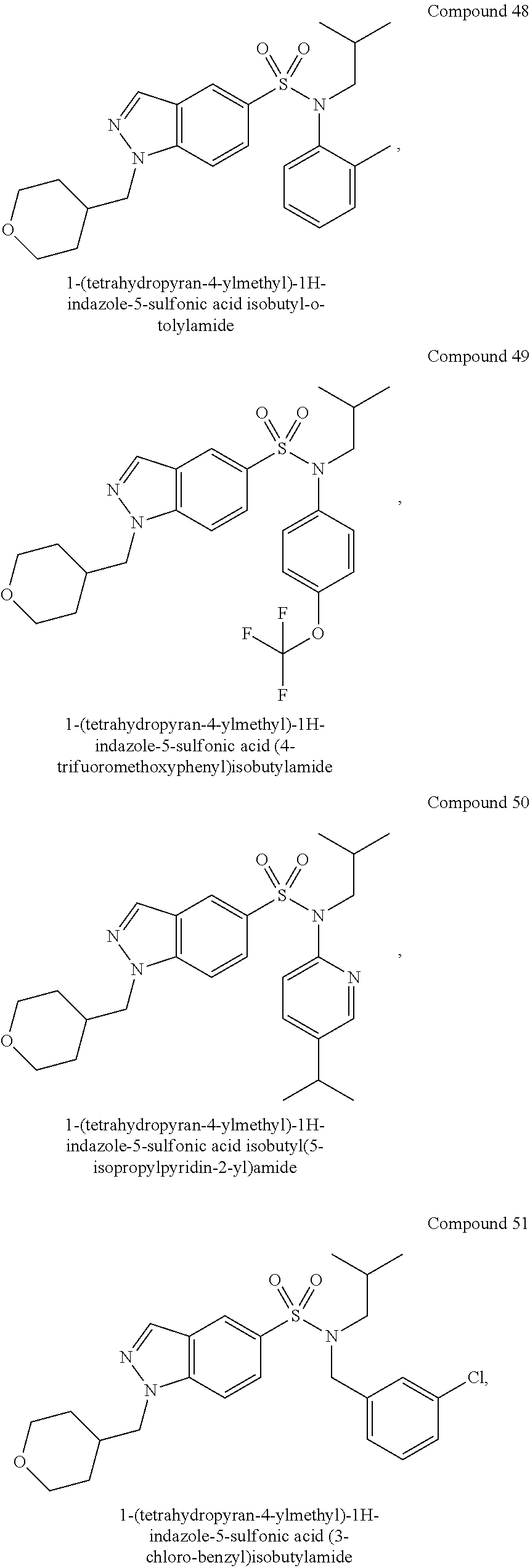
C00315
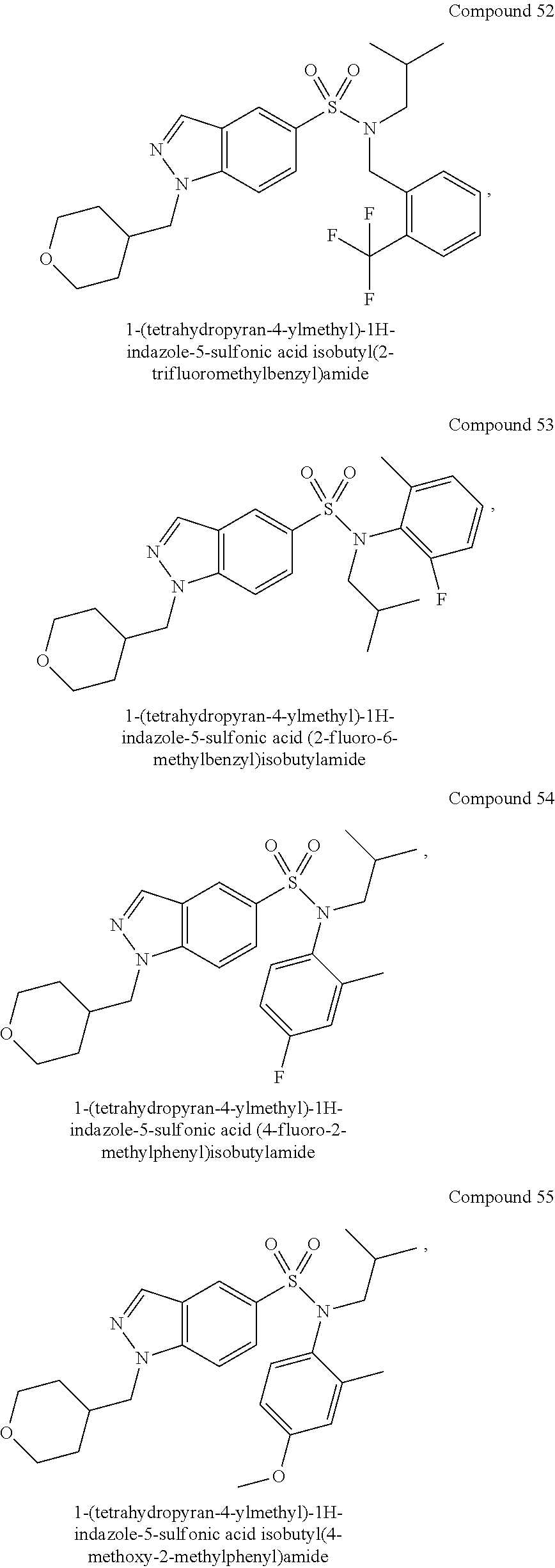
C00316

C00317

C00318

C00319

C00320

XML
uspto.report is an independent third-party trademark research tool that is not affiliated, endorsed, or sponsored by the United States Patent and Trademark Office (USPTO) or any other governmental organization. The information provided by uspto.report is based on publicly available data at the time of writing and is intended for informational purposes only.
While we strive to provide accurate and up-to-date information, we do not guarantee the accuracy, completeness, reliability, or suitability of the information displayed on this site. The use of this site is at your own risk. Any reliance you place on such information is therefore strictly at your own risk.
All official trademark data, including owner information, should be verified by visiting the official USPTO website at www.uspto.gov. This site is not intended to replace professional legal advice and should not be used as a substitute for consulting with a legal professional who is knowledgeable about trademark law.